CHAMPIONS





To join our team visit www.lockheedmartinjobs.com.
Breon Mechanical Engineering Manager

People and Events
8 Catch up with the latest retirements, promotions, upcoming events, and other news.
One on One
The 25th secretary of the U.S. Army, the Honorable Christine Wormouth, shares her outlook on the future.
Bias creates challenges that may cause our contributions to be ignored or diminished. Check out this story and find out how we can become examples of fair and inclusive practices in our organizations.
Career Voices ................... 18
Ever wonder what a day in the life of a civilian engineer looks like? Air Force Materiel Command officers give us a little insight into their world.
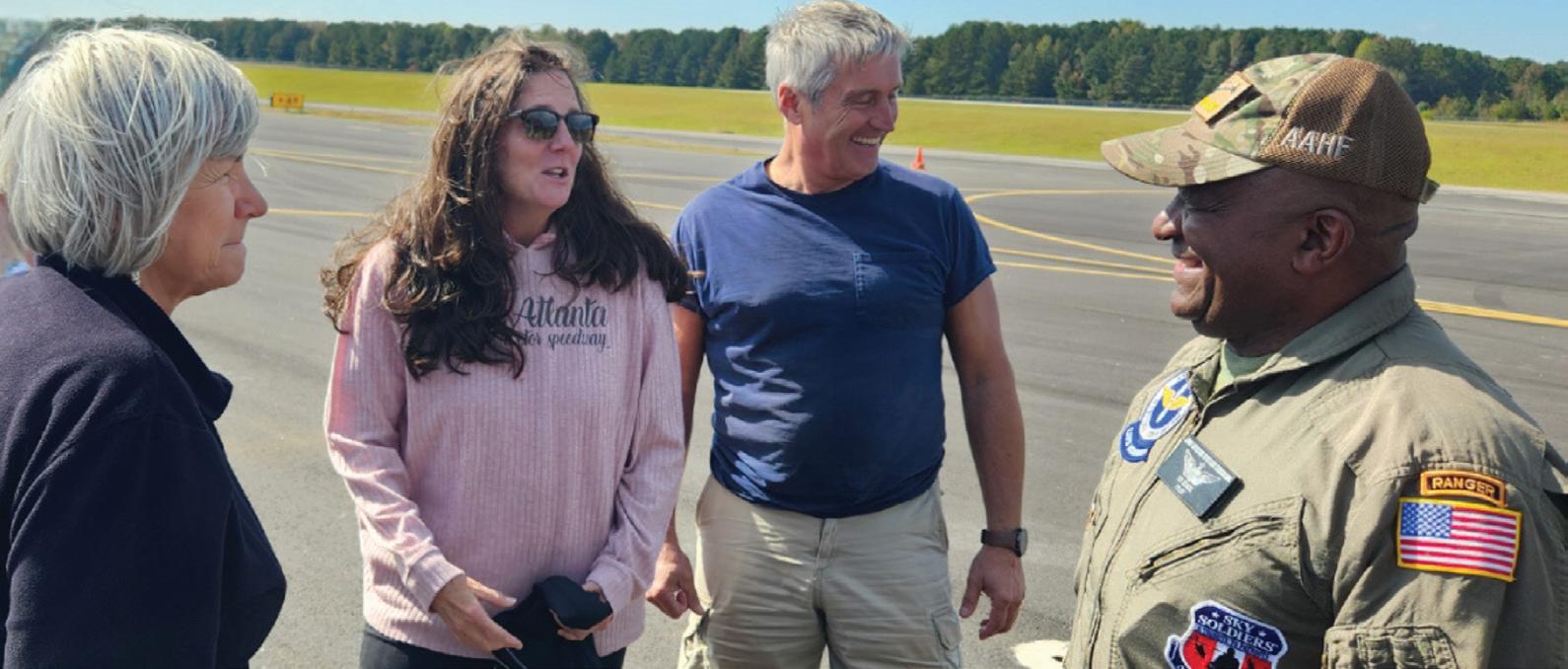
Leading Voices .................. 74
• Lieutenant Commander Desmond Walker, U.S. Navy - The Burden of a Black Naval Officer
Career Outlook ................79
Since US Black Engineer (USBE) magazine began publishing the “Top Blacks in the U.S. Military” list, more than 1,000 biographies have run in our end-of-year edition.
Some of the admirals and generals who have been featured on the cover of USBE’s Veterans issue (previously Homeland Security and Defense) include Mel Williams Jr., U.S. Navy retired; Robert Crear, former commander and president of the Mississippi River Commission; and William E. "Kip" Ward, who served as the inaugural commander of the United States Africa Command.
In 2009, Gen. Larry O. Spencer, then in the Office of the Assistant Secretary of the Air Force, appeared alongside Linda Gooden, former Lockheed Martin Corporation officer. After Anthony L. Winns graced the cover as Naval inspector general, USBE magazine spotlighted pairs of people from the Coast Guard, Army, Navy, and Air Force.
In 2014, Spencer, then in the Office Vice Chief of Staff, appeared with Gen. Mark A. Walsh III, Gen. Darren W. McDew, and Maj. Gen. Stayce D. Harris. A year earlier, the magazine cover featured Army generals Lloyd J. Austin, Vincent K. Brooks, Raymond T. Odierno, and Dennis L. Via. In 2017, Brooks made the group photo cover again with, among others, Simone Askew, the first African-American woman to lead the Corps of Cadets. In 2015, USBE magazine featured the Navy’s first female four-star admiral, Michelle J. Howard. Other historic firsts on our covers include Gen. Charles Q. Brown, a legendary aviator, who took office as the 22nd chief of staff of the U.S. Air Force in 2020.
More than four decades after Frank Emmanuel Petersen Jr. became the first AfricanAmerican general in the Marine Corps, Michael E. Langley became its first Black fourstar general after being promoted on Aug. 6, 2022.
Follow us online www.blackengineer.com


On the cover, clockwise fron top: Gen. James C. McConville, Chief of Staff, U.S. Army; Ms. Yvette Bourcicot, Acting Assistant Secretary of the Army Manpower and Reserve Affairs; Sgt. Maj. Michael Grinston, U.S. Army; Gen. Darryl A. Williams, Commander, U.S. Army Europe and Africa, Commander, NATO’s Allied Land Command, U.S. Army; The Honorable Christine E. Wormuth, Sectretary of the Army; Lt. Gen. Donna W. Martin, The Inspector General, U.S. Army; and Gen. Gary Brito, Commanding General, Training and Doctrine Command, U.S. Army.
Future-forward STEM careers in the U.S. armed forces. www.blackengineer.com
Tyrone D. Taborn Publisher and Chief Content Officer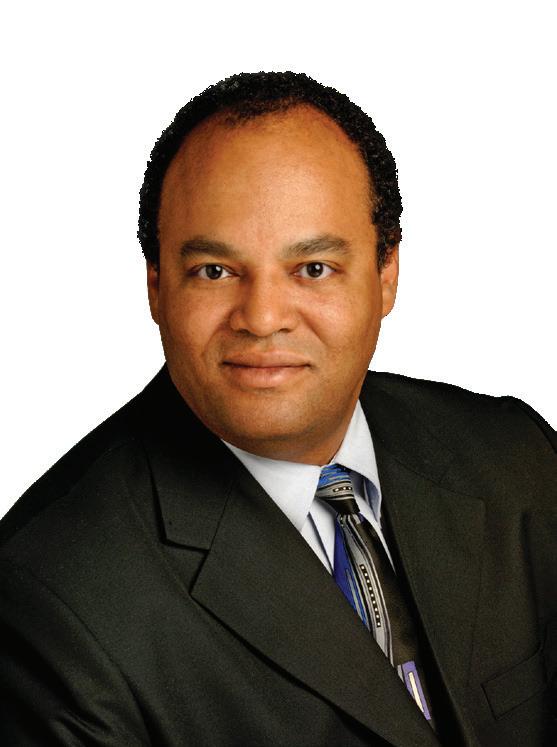



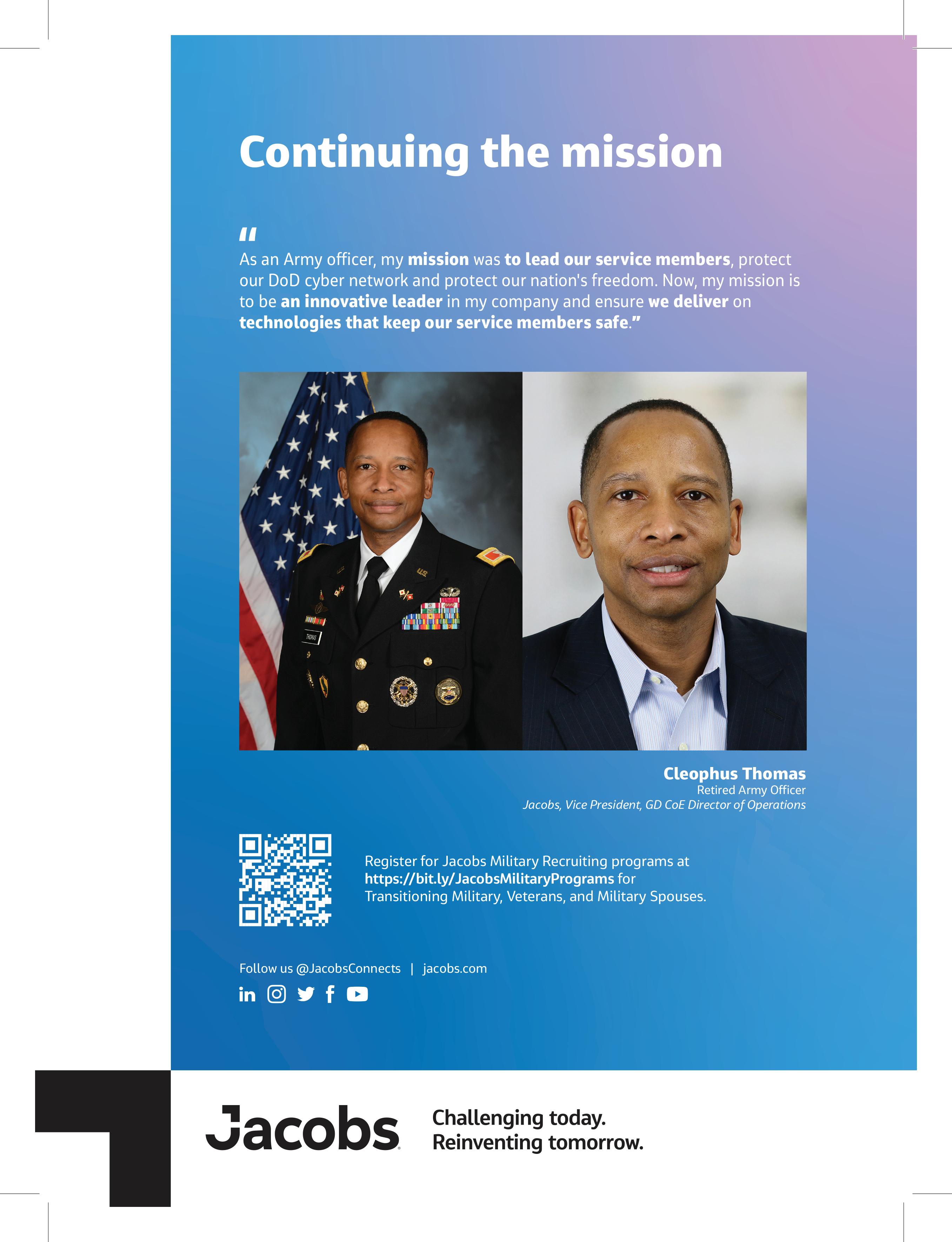
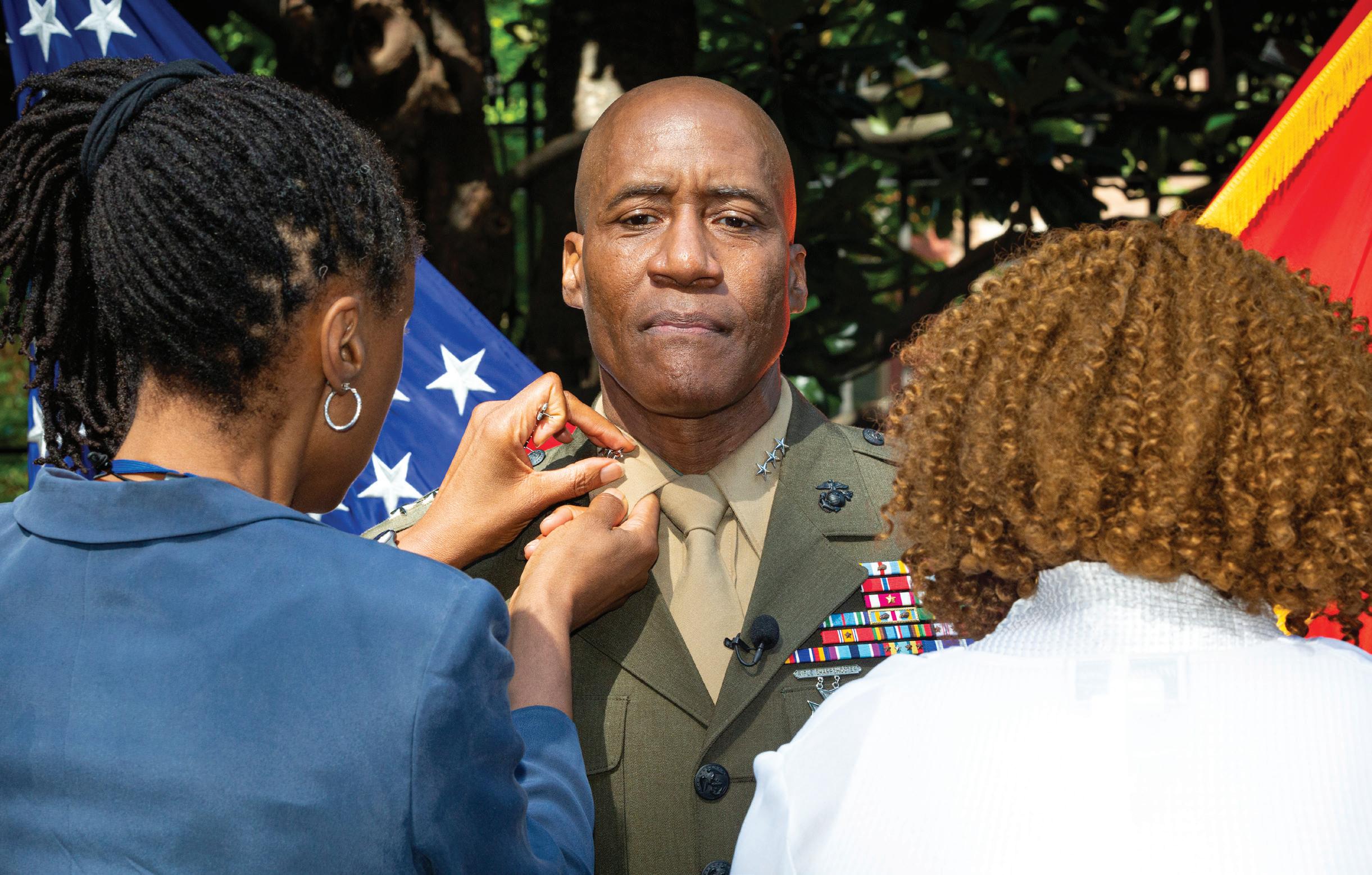
U.S. Marine Corps Gen. Michael E. Langley is promoted by his family during a ceremony at Marine Barracks Washington, D.C., August 6, 2022. (photo by Sgt. Karis Mattingly/Released 220806-M-TS451-0205.JPG)
Michael Elliott Langley is the first Black four-star general in the United States Marine Corps, having been promoted to that rank on Aug. 6, 2022. He has served as the commander of the United States Africa Command since Aug. 9. Most recently, he served as commander of U.S. Marine Corps Forces Command, United States Marine Corps Forces Northern Command, and Fleet Marine Force, Atlantic, from November 2021 to August 2022. He also served as deputy commander of Fleet Marine Force, Atlantic, and before that, as commander of United States Marine Forces Europe and Africa.
Col. Eries Mentzer, commander, 42d Air Base Wing, Chief Master Sgt. Lee Hoover, Command Chief Master Sergeant, 42d ABW, and an Alabama National Guard honor guardsman present the framed citation of the Congressional Medal of Honor to Private Romay Catherine Johnson Davis at Montgomery City Hall, July 26, 2022.
(Photo
U.S. Air Force photo by Melanie Rodgers Cox)
All-female, all-African American Six Triple Eight unit resolved a backlog of 17 million pieces of mail
July 26, 2022 marked the 74th Anniversary of Executive Order 9981, which integrated the Armed Forces. It was an auspicious day for Romay Davis, the oldest living member of the 6888, to receive the Congressional Gold Medal in Montgomery, AL.
According to Airman 1st Class Greydon Furstenau, Davis received the medal for her service as one of 855 Black women who served in the 6888th Central Postal Directory Battalion in World War II. "Joining the military is one of the biggest and best things I have chosen to do," Davis said in the interview. "I wish I could encourage more young people to take a stint away from home and join the military."
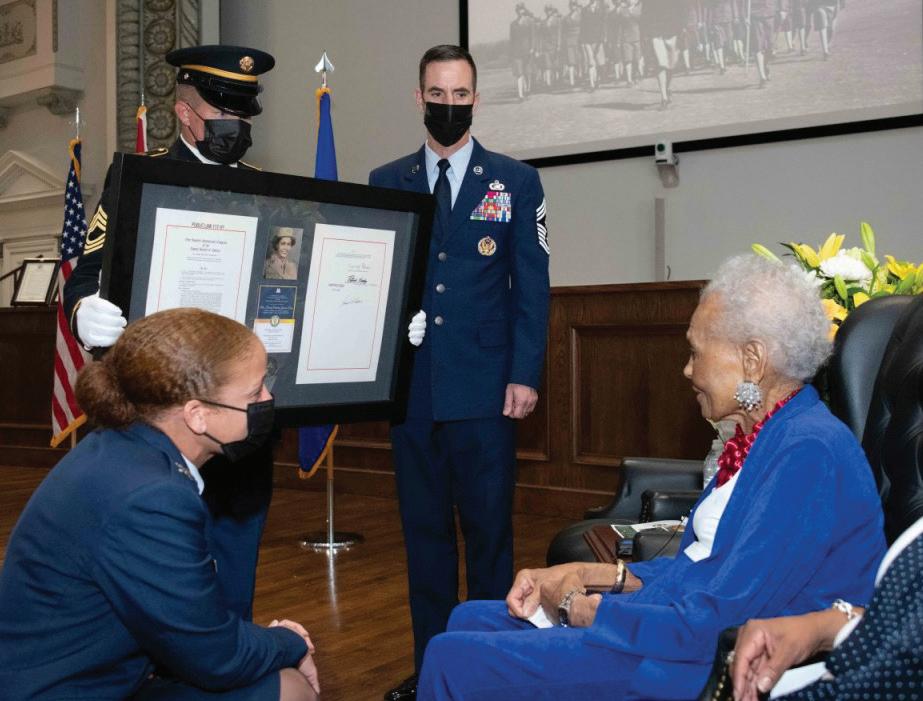
The Six Triple Eight battalion was the only predominantly Black female unit that served overseas during World War II. The unit resolved a growing
mail crisis during the war by ensuring American troops received their letters and packages from home. The unit processed more than 195,000 pieces of mail daily, clearing over 17 million by the end of their tour.
BEYA STEM GLOBAL COMPETITIVENESS DIGITAL TWIN CONFERENCE
Feb. 9-11, 2023
Gaylord National Resort & Convention Center, Washington, D.C.
AAAS ANNUAL MEETING
March 2-5, 2023 Washington, D.C.
WOMEN OF COLOR STEM DIGITAL TWIN CONFERENCE
Oct. 12-14, 2023
Huntington Place, Detroit, MI
February. The committee also awards student winners of various science, technology, engineering, and math (STEM) scholarships.
The Executive Coaching Pilot Program will leverage STEM City USA metaverse to reach 300 BEYA winners
Vice Adm. Anthony L. Winns (U.S. Navy retired) assumed chairmanship of the BEYA Stars & Stripes Committee on July 1. He succeeds Vice Adm. Walt Davis, who has guided BEYA Stars & Stripes over the past eight years. BEYA Stars & Stripes is an integral part of the annual BEYA STEM Conference. Since the founding members held the first breakfast event during the three-day conference 17 years ago, the veteran group of Black Engineer of the Year Award (BEYA) winners has honored a growing line of service members at a dinner held to mark Black History Month and National Engineers Week in
Career Communications Group, Inc. and the BEYA STEM Conference have announced a new partnership with Marshall Williams, director and CEO of Four Forces Executive Group and former principal deputy assistant secretary of the Army for manpower and reserve affairs. The BEYA STEM Executive Coaching Pilot Program is designed to strengthen the executive leadership of 300 winners of prestigious awards at the annual BEYA STEM Conference and chart their professional journey based on a solid career strategy. The pilot program will offer research-based executive coaching and leadership development services to boards, CEOs, and senior executives at leading global organizations. However, one key differentiator will be a specifically selected list of Black executive coaches, who will provide 10 hours of one-onone executive coaching service over five months for each client. S
Anthony L. Winns succeeds Walt Davis as chairman of BEYA Stars & StripesCredit:




Congratulations to the BEYA STEM Global Competitive Conference’s 2023 honorees.

As a proud supporter of this year’s conference, we believe that brilliant ideas and inspired thinking develop from unique perspectives.

Honorable Christine Wormouth was confirmed by the U.S. Senate and appointed as the 25th secretary of the U.S. Army on May 28, 2021. She is the first woman to be the U.S. Army's top civilian leader. The secretary of the Army is the senior civilian official within the Department of Defense responsible for all matters relating to the U.S. Army. Before confirmation, she was the director of the International Defense and Security Center at the RAND Corporation. She was a frequent writer and speaker on foreign policy, national security, and homeland security issues.
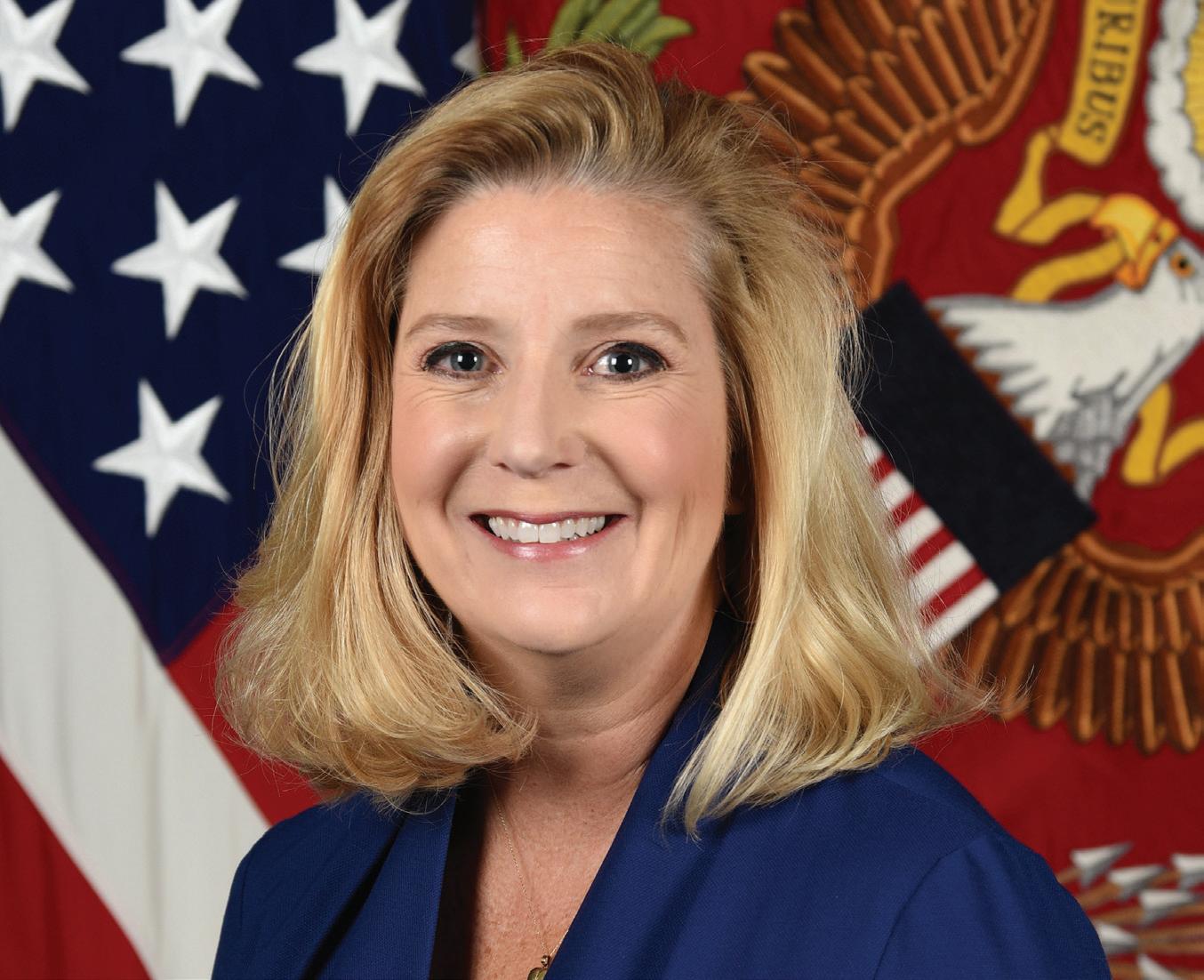
Wormouth gave US Black Engineer & IT (USBE&IT) magazine an exclusive interview on the future of the Army. Below is that conversation.
USBE&IT Magazine: How is the Army building on the service branch's foundational priorities of people, modernization, and readiness?
Honorable Christine Wormouth: Building on our foundational priorities, I published six objectives in early 2022 to help guide the force. First, we are ensuring the Army continues down a sustainable strategic path that allows us to transform to face new challenges while taking care of our people, and without sacrificing our readiness to answer our nation’s call anytime, anywhere. Second, we must ensure the Army becomes more data-centric and capable of operating in contested environments in order to prevail on the modern battlefield. Third, we must continue our efforts to be resilient in the face of climate change, adapting our installations, acquisitions programs, and training to remain ready to operate in a changing environment. Fourth, we are building positive command climates at scale across all Army formations. Fifth, we must reduce the harmful behaviors that hurt our soldiers and
break trust with the American people, including sexual harassment and assault, racism and extremism, and domestic violence. Finally, we must strategically adapt the way we recruit and retain our nation’s best talent to sustain the all-volunteer force.
USBE&IT Magazine: What does Project Convergence mean in terms of opportunities for new recruits and Army civilians?
Honorable Christine Wormouth: Project Convergence—the Army’s campaign of learning—enables us to test and experiment with capabilities and ideas—not by ourselves, but with our sister services, industry partners, and for the first time ever, direct participation from some of our allies. The insights gained through Project Convergence allow us to better understand the capabilities that our soldiers and civilians need on the future battlefield. It creates new opportunities
Honorable Christine Wormouth 25th Secretary of the U.S. Army
for technological and doctrinal innovation and helps us identify the cutting-edge skillsets that we need from current soldiers and new recruits alike, as we build the Army of 2030.
USBE&IT Magazine: Army STEM jobs have always offered exposure to new technologies and innovation for high school grads and college grads. How does the Army’s modernization strategy embrace emerging technologies?
Honorable Christine Wormouth: The United States Army is an innovative, high-tech service. We’ve maintained momentum on modernization, and as we build the Army of 2030, we will continue to sustain that momentum. 2023 will be a big year for Army modernization—we will deliver prototypes or begin fielding 24 different systems. The future battlefield
will require a lot from us, but the Army is ready, and we will meet the challenges of a more dispersed and transparent battlefield head-on.
To further bolster the Army’s culture of innovation, we are holding the finals event for the U.S. Army’s xTech Historically Black Colleges and Universities (HBCUs)—Student Competition, a platform providing undergraduates from HBCUs to submit novel technology concepts to the Army across three topic areas: climate change, health, and artificial intelligence and machine learning while participating in an accelerator program that will provide them with entrepreneurial training and one-to-one coaching leading up to the finals.
Additionally, the Artificial Intelligence Integration Center (AI2C) at Army Futures Command was established to better connect the Army to the artificial intelligence community, universities, and companies across the country, and I look forward to seeing the innovative solutions that come from that partnership.
I am a strong believer in STEM programs and the key role that STEM plays in exposing and preparing high school and college graduates for the opportunities that await them in our Army. Now more than ever, the Army needs data scientists, coders, and engineers, as much as we need our
tankers, aviators, and infantry soldiers, and Army STEM jobs offer a pathway into these critical roles.
USBE&IT Magazine: How is the Army adapting to operate in a time of climate change and build resiliency against its impacts?
Honorable Christine Wormouth: Climate change threatens our national and economic security. The effects of climate change have taken a toll on supply chains, damaged our infrastructure, and increased risks to Army soldiers and families due to natural disasters and extreme weather.
As part of the Army Climate Strategy, we are specifically working to optimize the use of fuel, water, electricity, and other resources—in everyday operations to include training—while saving taxpayer dollars and reducing our impact on the planet.
The Army has a big footprint, which means that we have the opportunity to make a significant impact on smart climate solutions. And I’m proud to say the Army has and continues to be a leader on climate change actions for the Department of Defense.
The Army’s core purpose is to deploy, fight, and win our nation’s wars, and that remains unchanged. However, as climate change will only make this mission more challenging, the Army is working to reduce the risks that climate change presents.
USBE&IT Magazine: How is the Army caring for soldiers, families, and Army civilians who are the very foundation of Army excellence?
Honorable Christine Wormouth: Taking care of our soldiers and their families is a top priority for all Army senior leaders. I am committed to ensuring that we provide the best services and support to our soldiers and families as possible.
As part of our efforts, the Army is working to ensure we select the best possible leaders for our force and that we listen to our people. The Army’s Equity and Inclusion Agency will continue its listening sessions to better understand the issues facing
our soldiers and civilians and develop solutions which enhance inclusion and build more cohesive teams. We will continue to recruit Americans from all backgrounds, talents, and geographies to ensure we benefit from the vast experience, knowledge, and differing perspectives required to make any organization great.
While we recruit soldiers, we retain families, and we know that our soldiers could not do what they do every day for our nation without the strong support from their families.
The Army has worked closely with the Department of Defense on initiatives to improve the affordability of housing and food, improve spousal employment, and make the PCS (permanent change of station) process more predictable and as seamless as possible. And we are focused on countering the rising costs of housing, improving housing and barracks conditions, and ensuring access to childcare services.
USBE&IT Magazine: What is the Army doing to reduce the frequency of harmful behaviors?
Honorable Christine Wormouth: Reducing harmful behaviors is a top priority for all Army leaders. We have got to shift from responding to harmful events to finding ways to prevent them. The Army is working to develop and institutionalize prevention-oriented approaches to reduce the frequency of harmful behaviors such as sexual harassment and assault, extremist activity, racism, and domestic violence.
The Army recently implemented two new initiatives to combat harmful behaviors. First, we’ve actioned the Safe-to-Report policy, which safeguards sexual assault victims from disciplinary action for minor collateral misconduct. Second, this summer we also established the Office of the Special Trial Counsel, which will be led by a 1-star who will report directly to me and who will take the lead in the investigation, referral, and trial-level litigation and prosecution of sexual assault. S
“The future battlefield will require a lot from us, but the Army is ready, and we will meet the challenges of a more dispersed and transparent battlefield head-on.”
World Wide Technology is honored to support the federal government and its efforts to enhance citizen services, improve quality of life and protect our world. Together, let’s make a new world happen.
Find out how at wwt.com

Fernanda Alaniz
Mario Almazan
Yefte Apodaca
Victor Arenas
Roberto Arias Sr.
Angela Butler
Gabriela Cabrera
Aldo Carreon
Jabari Carrington
Emanuel Castelo
Ikechukwu Chima
Hector Corona Sr.
Fernando Del Rayo
Miguel Diego Sr.
Denisse Duarte
Myster Duck
Roberto Eng
Denisse Espinoza
Ignacio Espinoza
Fola Fakayode
Juan Figueroa
Pedro Flores Ramirez
Renita Friese
Juan Gaeta
Areli Melina Garcia
German Garcia
Melina Garcia
Soriel Garcia
Miguel Gonzalez
Marco Gutierrez
Michael Gutierrez
Ronald Harris II
Winkens Henri
Manuel Higareda
Aziza Johnson
John Johnson
Jylinda Johnson
Robert Johnson
Dwayne Jones
Evelyn Kimble
Emily Koshay
Mario Lafarga
Lateef Law
Ivette Leon
Mayra Lizarraga
Federico Lopez Sr.
Kevin Lopez
Yiset Lopez
Katie Manthe
Fernando Marquez
Thomas Mathis
Delena McFadden-Mello
Kortnie Mills
Shunnar Mitchell
Nolasco Monk
Terry Mulligan
Alberto Nunez
Eros Omassi
Terence Pace
Manuel Pantoja
Katia Peña
Devon Reynolds
Xochitl Richarte
Stephanie Rizzo
Blas Romero
Mario Rubalcava Corona
Jorge Sato
Maury Smith
Eduardo Solorio
Drew Sylve
Ashley Tyler
Pablo Uzueta
Filiberto Valenciana
Sophia Vaughn Christopher Wells
Marin Wilkerson
Delano Wilson
Oscar Zamora
Antonio Zamudio
Alan Zavala
Marco Zazueta
Marjorie Zelaya
Linda Dorsey
Jacques Arrieux
Lazare Balossa
Akilah Crowner
Tyrone Dell
Cameron Mims
Cemone Moy
Stacey Neloms
Kelvin Spencer
Xiaomin Wang
There are many types of bias: tendency, horns and halo, anchoring, contrast, unconscious, recency, and fundamental attribution, to name just a few. And, they all show up in many different ways. As STEM and STEAM professionals, it is imperative that we have the context to be able to disrupt them as we experience them in our industry and the world around us.
By definition, unconscious bias is often
defined as a prejudice or unsupported judgment in favor of or against one thing, person, or group compared to another, in a way that is usually considered unfair. Researchers suggest it occurs automatically as the brain makes quick judgments based on past experiences and backgrounds. Underrepresented individuals (gender diverse, ethnically diverse, women, etc.) tend to be on the receiving end of unconscious biases in many cases.
The first thing everyone should know about bias is that it is real and experienced by the majority of professionals across all industries. What’s more, conversations about workplace bias have erupted in the last 50 years. From microaggressions to microinequities, research suggests that 64 percent of all professionals either have or will experience workplace bias as witnesses or victims at some point in their lives. And when it occurs, the impact on individuals can include
negative consequences such as stress, anxiety, depression, PTSD, low selfesteem, psychological distress, and more.
In the 21st century, though, the face of bias has changed. Many well-meaning people may be unaware of the hidden messages they communicate through their biases. Yet, while people may be well-intending, their aggressions, or microaggressions, can still have a negative impact. It is essential to know that microaggressions are not measured by the intent of the aggressor, but by the impact on the victim.
Microaggressions are usually experienced one-on-one, and there is usually no evidence of the experience. So why is it important to recognize them in STEM industries? For starters, they can impact the people who are recruited to professional teams and organizations. These unconscious biases can also affect evaluations and assumptions that are made regarding which individuals can perform specific jobs. Particularly key for engineers, microaggressions can have a negative impact on what career paths are offered to or chosen by professionals. If self-confidence is lost based on biases experienced or witnessed in the workplace, valuable leaders will lose


their ability to imagine a bright future for themselves—and that is the soul of what engineers do. They build things that don’t yet exist. Microaggressions can also hinder the development of important professional relationships, negatively impact new skills that could be learned, detract from businesses that could be built, and thwart invitations for professionals to participate in meaningful projects and proposals.
So how should someone mitigate microaggressions in their workplace? First, prepare for them. Again, they exist. Preparation alleviates surprise and allows time to think about a response and avoid unfavorable reactions. Next, pay attention to your experiences in the workplace. Because biases or microaggressions may seem or feel small as they happen, seriously consider the reality of what is happening. Take notes and write down what happened to retain key moments of daily interactions. Next, do
your part to create a counterculture to change the conversation about race and identity. Join affinity groups and identify bystanders and allies. They are on your side and don’t want the negativity of microaggressions in the workplace. Also, call out and bring attention to the good when it happens with microaffirmations. These change perceptions of people’s abilities and who can be successful. Doing these things can transform our workplaces into spaces that are safer, kinder, more compassionate, and ultimately more unified toward common goals. S Watch this conversation online at https://youtu.be/ z8zAVLeEMsY
Many well-meaning people may be unaware of the hidden messages they communicate through their biases.This article is based on a seminar that took place at a Career Communications Group conference. Participants clockwise from top: Raymone Jackson, Global Head of Diversity, T. Rowe Price; Pauline Bennett, Senior Engineering Technical Manager, General Dynamics Mission Systems; Cheronda Walls, Chief Architect, General Dynamics Mission Systems; Onyeka Ossai, Sales Practice Lead, Actalent

this area handle all maintenance, repair, and overhaul duties for the weapons and software systems in the Air Force. The center has over 4,000 software professionals who write and develop software. This not only involves bug fixes, but also adding new capabilities to weapon systems. The Sustainment Center looks to add innovative talent that can keep the Air Force ahead of its adversaries in the technological space. This is key because 80 percent of the weapons systems in place are softwarebased, and most of the functions in the weapons systems cannot happen without utilizing at least one software application. Engineers in this space will work to ensure software gets developed efficiently and with agility.
The organization has over 89,000 employees. Of those, at least 15,000 are engineers and scientists. With centers spanning metropolitan and rural areas throughout the United States, AFMC provides great opportunities for civil engineers interested in basic, applied, and advanced research.
AFMC is an extensive operation that works across air, nuclear, and cyberspace systems of the Air Force. The organization consists of six management centers, each with specific functions. The Life Cycle Management Center focuses on acquiring and creating all capabilities needed for warfighters, as well as purchasing everything from computers to weapons. Other centers include the Test Center, Installation and Mission Support, and Nuclear Weapons.
The Air Force Sustainment Center handles everything from writing software to disassembling and reassembling airplanes. Engineers in
A big part of the Sustainment Center includes the Software Engineering Group. This team develops organic solutions for any and all Air Force problems. They control everything from startup to maintenance, and they’re more competitive than any other company that supports the government’s military operations. This team handles several responsibilities, including (but not limited to): setting up source code management for software teams, fixing bugs and adding needed features, scanning source code to find and fix security vulnerabilities, redesigning software and updating technology (including hardware) as needed, and procuring whatever teams need to move forward with their operations. Engineers working in this sector have a direct impact on the software end user, and they gain a rich knowledge of software development, maintenance, and security.
In the Air Force Research Lab (AFRL), engineers get to lead the discovery, development, and integration of affordable warfighting technologies for air, space, and cyberspace forces.
Collaboration-driven ideation here has a future-forward focus, as team members invest in basic research, applied research, and advanced technology development for air tech that may be created and used 20–30 years from now. A recent example of this cutting-edge innovation includes the Responsive Open-Source Engine (ROSE) Program. With ROSE, engineers are creating the first turbine engine that is designed, assembled, and tested exclusively by AFRL. The program
The mission of the Air Force Materiel Command (AFMC) is to “develop, deliver, support, and sustain war-winning capabilities” for “the world’s greatest Air Force.”
is a rapid demonstration of new technologies and faster, less expensive prototypes. With varying needs from aeronautical design to structural and mechanical design, AFRL seeks engineers with diverse degrees of expertise and experience.
The AFMC is an expansive operation with a myriad of opportunities available to military and civilian engineers. The examples here are only a handful. Though civilian engineers who work

for the AFMC are required to take an oath to support and defend the Constitution of the United States, there are no physical fitness, air, or military requirements. If you are an engineer interested in serving your country, there’s no greater opportunity than working for the Air Force or Air Force Materiel Command.
You can listen to the full Seminar Here https://youtu.be/e_

S
“In the Air Force Research Lab (AFRL), engineers get to lead the discovery, development, and integration of affordable warfighting technologies for air, space, and cyberspace forces.

Boeing is proud to honor service members for everything they do to keep those at home safe.
Learn more at boeing.com/veterans


Adm. Michael M. Gilday is the 32nd chief of Naval Operations who holds master’s degrees from the Harvard Kennedy School and the National War College. Son of a Navy sailor, Gilday is a native of Lowell, MA, and a graduate of the U.S. Naval Academy.
In February, Gilday delivered an empowering speech as the keynote speaker at the U.S. Black Engineer of the Year Awards Stars & Stripes event in Washington, D.C. The ceremony recognized awe-inspiring individuals in our armed forces, and Gilday said he was humbled to share a platform with these individuals.
“Tonight, we celebrate all of those who overcome obstacles to engineer solutions not for personal gain...but for the benefit of all,” Gilday said.
When speaking about the Stars & Stripes awardees for the night, he emphasized his admiration for them, citing their incredible commitment to our country and applauding them as our nation’s leaders and heroes.
“It’s been said that a nation reveals its character by those it honors,” Gilday said. “By presenting this award each year, we honor the crucial role of Black engineers across our armed services, and we recognize these icons that have overcome structural challenges, created concrete change, and optimized the potential of their teams by developing a diverse, equitable, and inclusive environment.”
Diversity in the military has become a hot topic in recent years. It’s important for our armed forces to represent every individual in our country no matter their background, race, gender, or

religion. According to the Pew Research Center, 57 percent of U.S. servicemembers were white, 16 percent were Black, and 16 percent were Hispanic in 2017. Women represented 16 percent of the overall active duty force, up from 9 percent in 1980 and just 1 percent in 1970.
Gilday said that to truly realize the full potential of everyone in the country, the military must be diverse and inclusive not just in terms of race and gender but in background and personal beliefs as well.
but empowered to express themselves freely. Having different opinions should not be a deterrent but instead serves as an opportunity to connect with others.
“By prioritizing diversity and inclusion, we can promote a force that better leverages everyone’s insights and strengths,” Gilday said.
The Stars & Stripes event at BEYA celebrates leaders in our armed forces making it possible to foster diversity and inclusion that will only help move our country forward. Gilday ended his speech by congratulating those who were recognized at the event.
According to Gilday, the U.S. Navy has made it a goal to be the most diverse service in the next 20 years and one of our nation’s most diverse organizations. He said that in order to deter war and promote peace, leaders must build environments where everyone can contribute and grow. He said his wife, Linda, says it best: “Diversity without inclusion is just optics.”
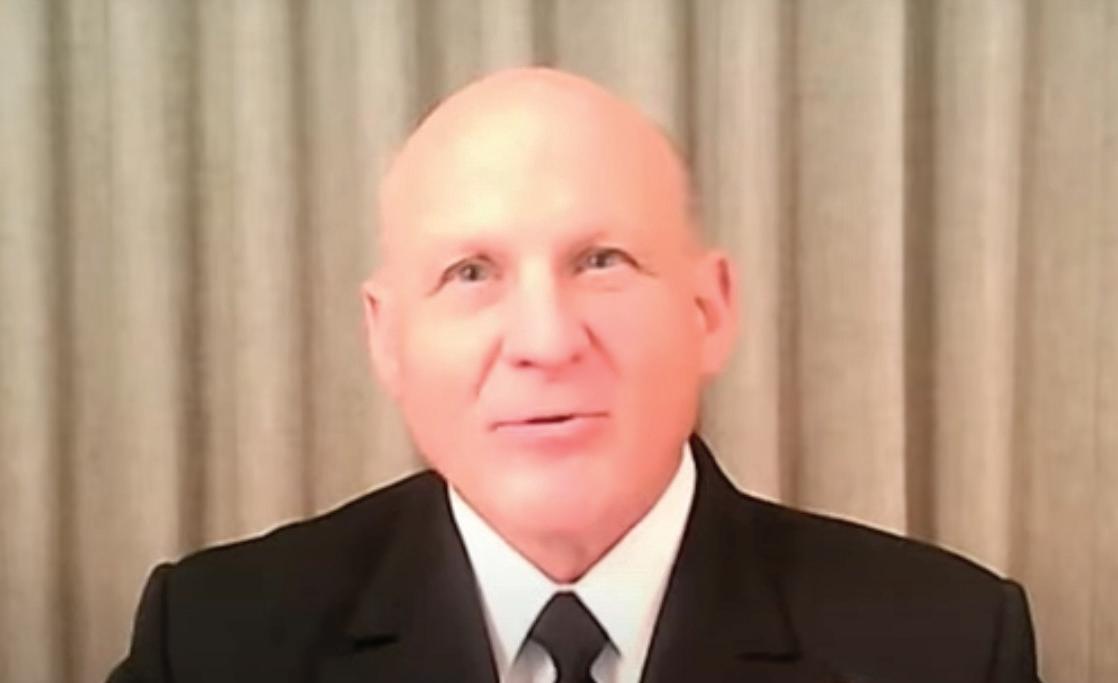
When it comes to having different opinions, Gilday said it's important for everyone to feel not only comfortable
“Tonight, we celebrate the service and the incredible career of those engineers who represent the very best of our nation and its highest ideals,” Gilday said. “Congratulations to all of our BEYA recipients. You are an inspiration to all of our sailors across the fleet and so many young men and women who are pushing their dreams in the STEM areas of study. It is my distinct honor to serve beside you all.” S
You can watch Adm. Gilday's Speech and the Stars & Stripes event here: https://youtu.be/oAy7GkEglSw?t=3765
“Quite simply...if we do not change the way we think, act, attract, retain, and manage talent, we will not be able to compete in this century,” Gilday said. “We need to welcome diversity, embrace it, and use it to our advantage.”Adm. Michael M. Gilday, 32nd chief of Naval Operations

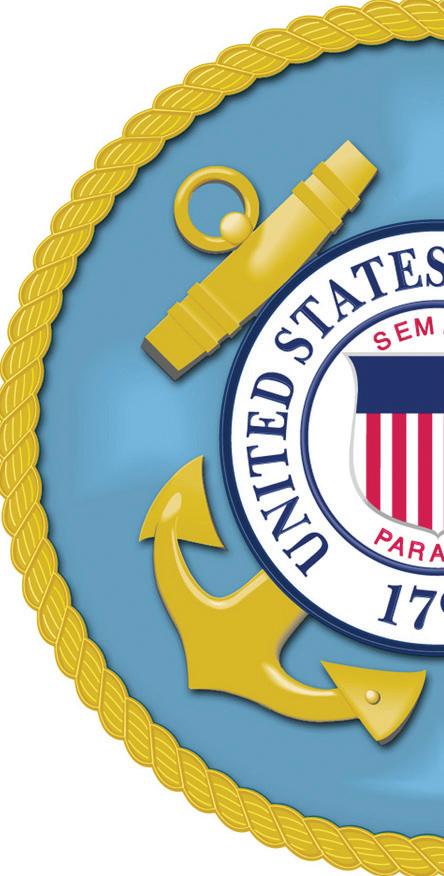

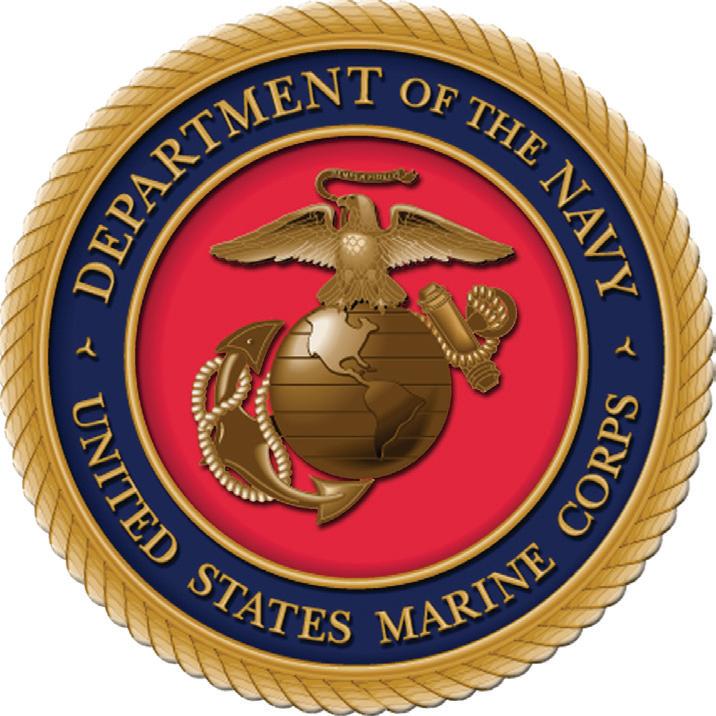

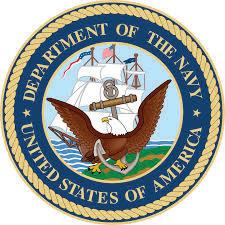

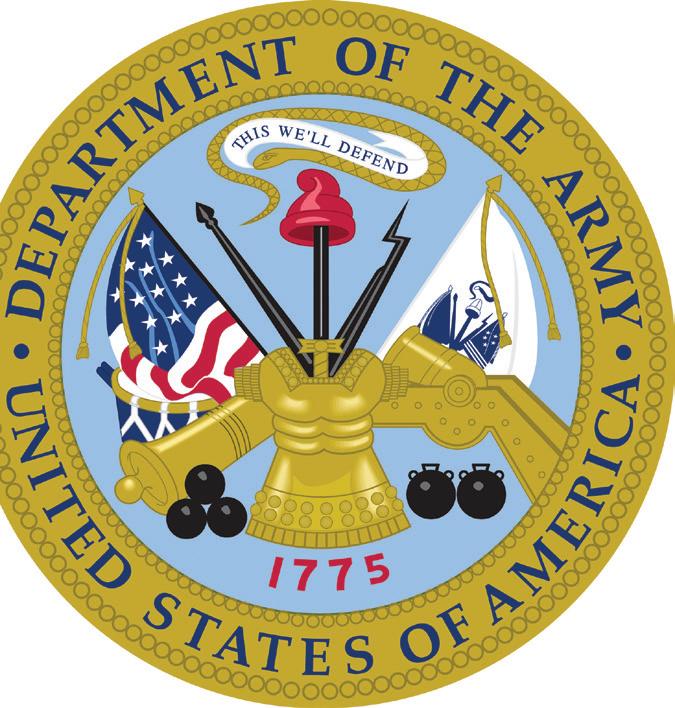



Per tradition, this issue of US Black Engineer & Information Technology magazine focuses on veterans and nonveterans in the United States military. The men and women featured on the following pages have devoted their lives and careers to our national defense at home and abroad. They are among the leaders of America's uniformed military services, the highestranking officers of the Army, Navy, Air Force, Marine Corps, Space Force, Coast Guard, and National Guard. Their stories, told briefly, hint at their commitment, bravery, and dedication to a nation that has depended on them in good times and bad. Information confirmed as of September 1, 2022
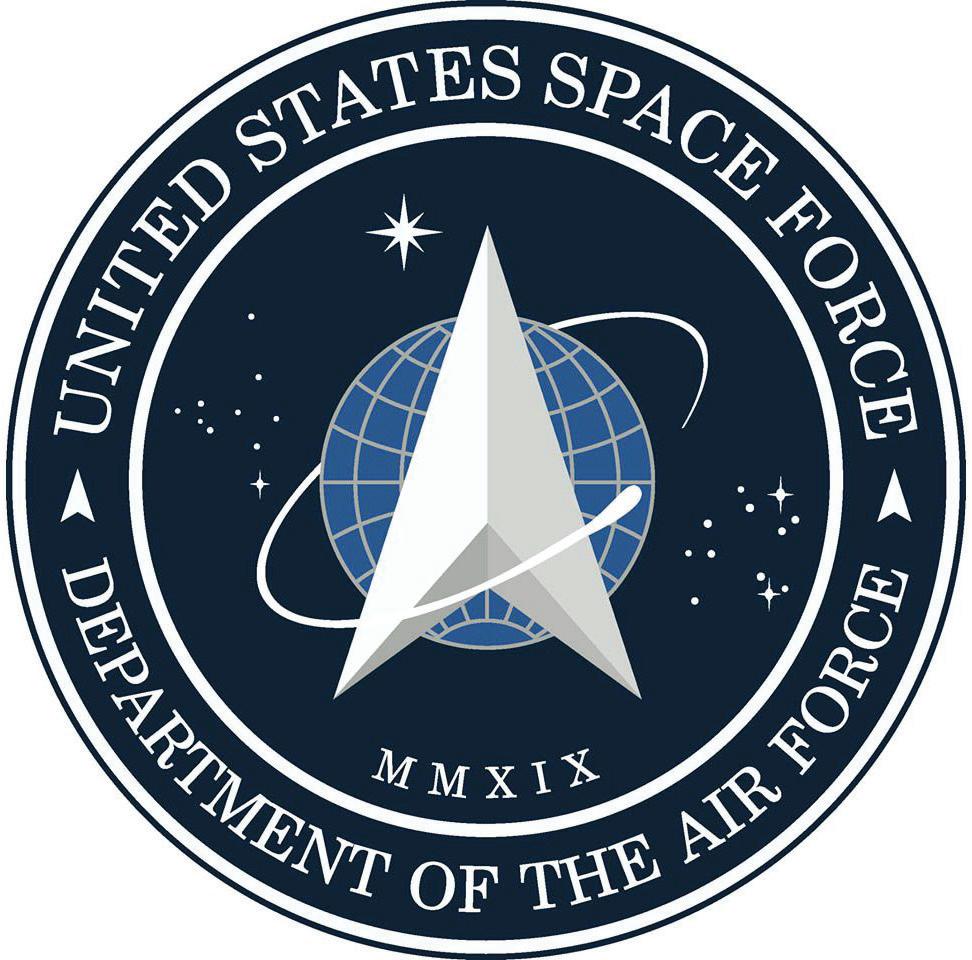



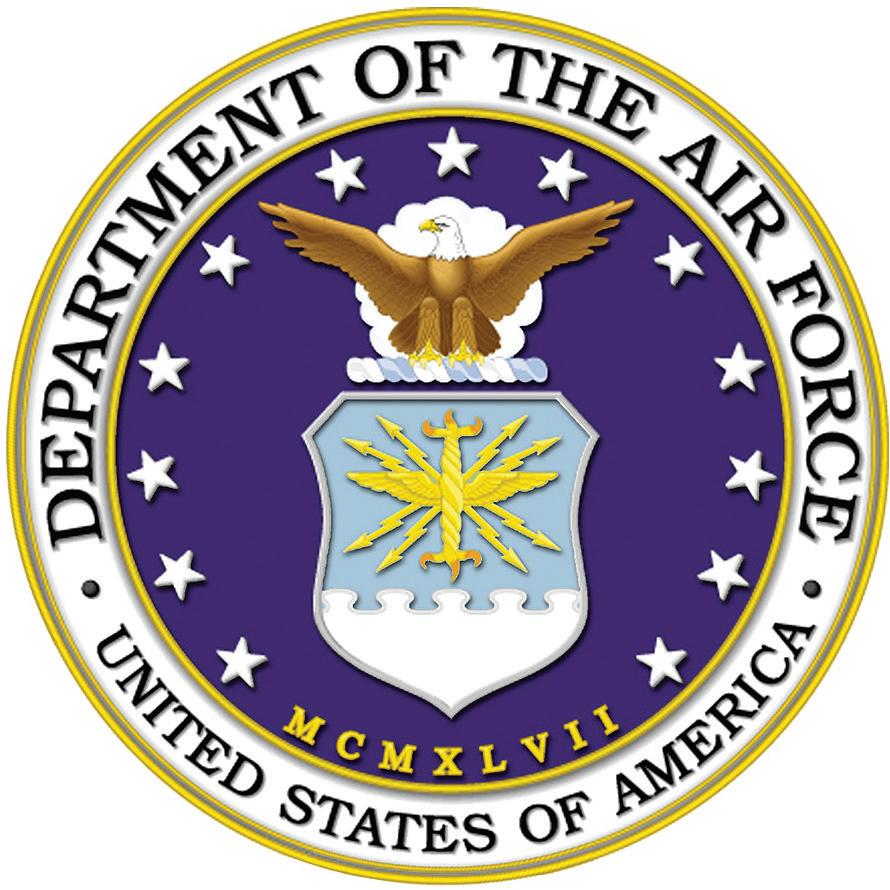




Commanding General, Training and Doctrine Command



Gen. Gary Brito assumed duties as the 18th commanding general of the Training and Doctrine Command on Sept. 8, 2022. He is responsible for developing, managing, and executing manpower and personnel plans, programs, and policies for the total Army. Before this assignment, he served as the U.S. Army’s 49th deputy chief of staff, G-1. Brito is a native of Massachusetts and was commissioned an infantry officer through Penn State University. He entered active duty in March 1987. He graduated from the Infantry Officer Basic and Advanced courses, Airborne and Ranger Schools, Combined Arms Staff Services School, Command and General Staff Officers Course, and Senior Service College at the Joint Advanced Warfighting School (JAWS) in Virginia. He holds a Bachelor of Science in community studies from Penn State, a master’s degree in human resource management from Troy State, and a second master’s degree in joint strategy and campaign planning from the Joint Advanced Warfighting School. He is also a graduate of the MIT Seminar XXI Program. Brito has served in a variety of command and staff positions. His previous assignments include commanding general, Joint Readiness Training Center and Fort Polk; deputy commanding general for sustainment, then later operations, 25th Infantry Division; director, Force 2025 and Beyond, U.S. Army Capabilities and Integration Center, Training and Doctrine and Command (TRADOC); commander, 120th Infantry Brigade, First Army; commander, 1st Battalion, 15th Infantry Regiment, 3d Brigade, 3d Infantry Division; operations officer (S-3), 2d Battalion, 8th Infantry Regiment; and later as the brigade operations officer (S-3), 2d Brigade, 4th Infantry Division.
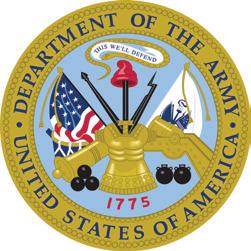
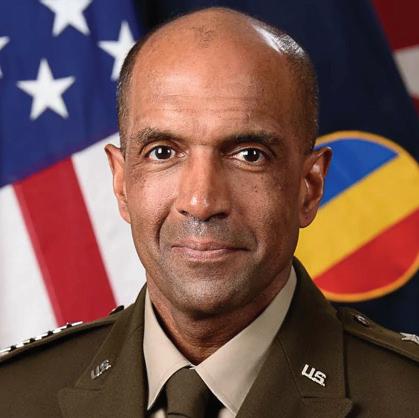
Gen. Darryl Williams assumed command of the U.S. Army Europe and Africa in June 2022.
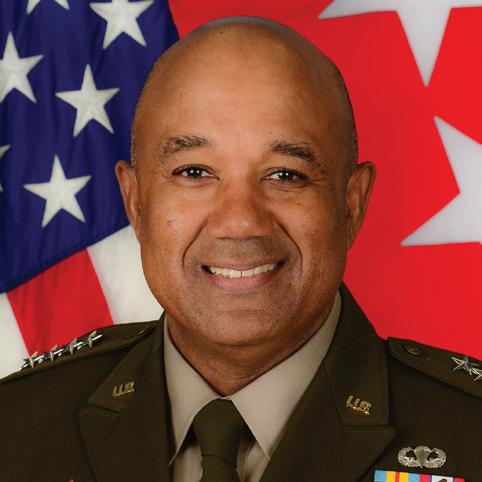
He also took command of NATO’s Allied Land Command in August 2022. A native of Alexandria, VA, Williams graduated from the United States Military Academy, West Point, in 1983 and was commissioned as a second lieutenant in the U.S. Army. A career Field Artillery officer, Williams has commanded at all levels, including Division Artillery, 1st Armored Division; U.S. Army Warrior Transition Command; U.S. Army Africa; NATO Allied Land Command; and most recently, as USMA’s 60th superintendent. He has also served in key leadership positions at the tactical, operational, and strategic levels, including deputy commanding general (support), 2nd Infantry Division, Republic of Korea; deputy chief of staff (G-3/5/7), U.S. Army Europe; and deputy director for Soldier Comprehensive Fitness, Department of the Army G-3/5/7. He has deployed in support of Operations Desert Shield/Desert Storm as a battery commander; Operation Iraqi Freedom as a division fire and effects coordinator; and Operation United Assistance as United States Army Africa commander, fighting against the Ebola outbreak in Liberia. His military education includes the Field Artillery Officer Basic and Advanced Courses, Command and General Staff College, School of Advanced Military Studies, and the United States Naval War College. He holds master’s degrees in leadership development, military art and science, and national security and strategic studies. His awards and decorations include the Defense Distinguished Service Medal, Distinguished Service Medal, Defense Superior Service Medal, Legion of Merit, Bronze Star, Defense Meritorious Service Medal, Meritorious Service Medal, the Parachutist Badge, Presidential Service Badge, and the Army Staff Identification Badge.
LT. GEN. MILFORD H. BEAGLE, JR. Commanding General, U.S. Army Combined Arms Center and Fort Leavenworth, KS Commandant, U.S. Army Command and General Staff College
Deputy Commanding General for Combined Arms, U.S. Army Training and Doctrine Command
Lt. Gen. Milford Beagle, Jr. was commissioned as an infantry officer upon graduation from South Carolina State University in 1990 as a distinguished military graduate. Beagle holds master’s degrees from Kansas State University in Manhattan, KS, and the United States Army School of Advanced Military Studies (SAMS), Fort Leavenworth, KS. Beagle has served in
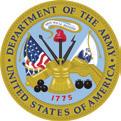
multiple leadership capacities from the platoon to the division level. He has served in combat in both Iraq and Afghanistan in positions ranging from operations officer in tactical combat units to advisor as part of NATO missions. His

career assignments have spanned the globe from Hawaii to South Korea. His most recent assignments were as the commanding general, 10th Mountain Division (Light Infantry) and Fort Drum, NY; before that, he served as the commanding general at the United States Army Training Center and Fort Jackson, SC. Beagle also served as the executive officer to the 35th vice chief of staff of the Army, Gen. Daniel Allyn, followed by serving as the deputy commanding general (support), 10th Mountain Division (Light), Fort Drum, NY, and forward deployed in support of Operation Inherent Resolve.
LT. GEN. XAVIER T. BRUNSON I Corps Commanding General Joint Base Lewis-McChord, Washington

Lt. Gen. Xavier Brunson is the I Corps commanding general at Joint Base Lewis-McChord (JBLM). He has served as commanding general of the I Corps since October 2021. Previously, he served as deputy commanding general of the I Corps from May to September 2021 and commanding general of the 7th Infantry Division from August 2019 to May 2021. America's First (I) Corps manages activities for more than 44,000 soldiers stationed at JBLM and across the Pacific, including Hawaii and Alaska. While deployed, America's First Corps commands all branches of service—Army, Navy, Air Force, and Marines—and international forces. Brunson’s previous assignments include assignments as chief of staff of XVIII Airborne Corps from August 2017 to June 2019 and deputy commanding general for operations of the 10th Mountain Division from November 2016 to June 2017. A native of Fayetteville, NC, Brunson holds a bachelor's degree in political science from Hampton University (where he earned his commission in 1990), a master's degree in human resources from Webster University, and a master's degree in national security and strategic studies from the United States Army War College.
LT. GEN.


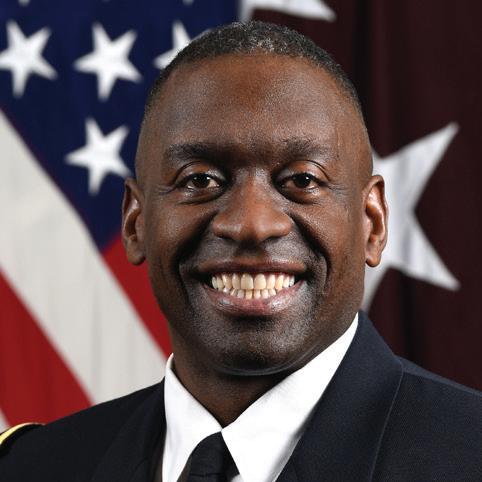
Lt. Gen. Ronald Clark is currently the senior military assistant to the 28th secretary of defense, Lloyd J. Austin III. Previously, he served as the U.S. Army Central and Third Army commanding general at Shaw Air Force Base, SC. Throughout his years of military service, he has commanded from the company level through Army Service Component Command and held key tactical, operational, and strategic positions. Of note, Clark served as commander of the 1st Battalion, 506th Infantry Regiment, 101st Airborne Division (Air Assault); director of the Simon Center for the Professional Military Ethic at West Point; commander of the 192d Infantry Brigade; deputy commanding general of the 82nd Airborne Division; and deputy chief of staff—operations for the NATO Allied Rapid Reaction Corps. Clark also served as chief of staff, U.S. Army Pacific; commanding general of the 25th Infantry Division, and chief of staff U.S. Indo-Pacific Command. Clark’s education includes a Bachelor of Science degree from the United States Military Academy at West Point, a Master of Military Art and Science degree from the U.S. Army Command and General Staff College, and the U.S. Army War College Fellowship at Duke University. He is also an MIT Seminar XXI National Security Studies Program graduate.
LT. GEN. R. SCOTT DINGLE
The Surgeon General of the U.S. Army Commanding General, U.S. Army Medical Command
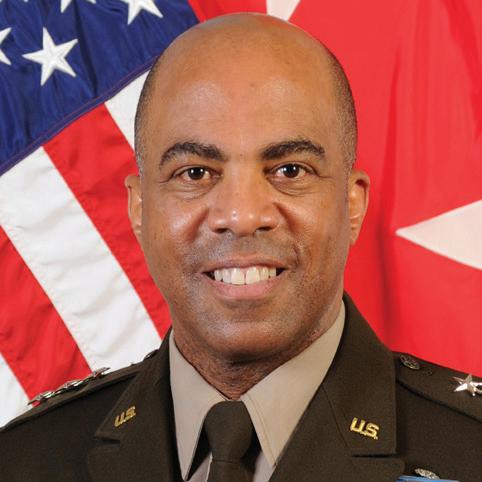
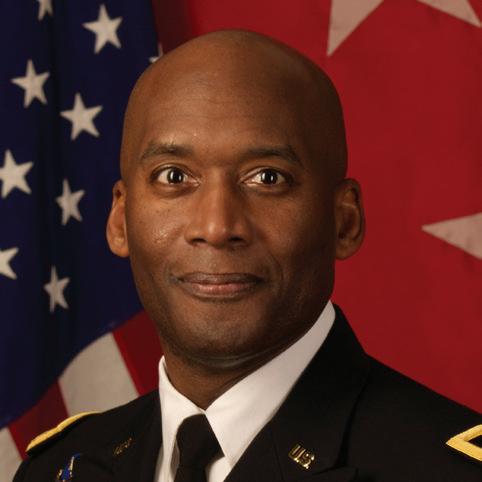
Lt. Gen. R. Scott Dingle is the Army surgeon general and commanding general of the U.S. Army Medical Command. Before assuming his current position, he served as deputy surgeon general and deputy commanding general (Support). Dingle is a distinguished military graduate of Morgan State University. His degrees include a Master of Science in administration from Central Michigan University, a Master of Military Arts and Science from the School of Advanced Military Studies, and a Master of Science in national security strategy from the National War College. His military education includes the Army Medical Department Officer Basic Course, the Combined Logistics Officer Advanced Course, the U.S. Army Command and General Staff College, the School of Advanced Military Studies, and the National War College. His awards and decorations include the Distinguished

in the U.S. Military

Service Medal (oak leaf cluster), Bronze Star Medal, Meritorious Service Medal (seven oak leaf clusters), Joint Service Commendation Medal, Joint Meritorious Unit Award, Army Commendation Medal (two bronze oak leaf clusters), Army Achievement Medal (one bronze oak leaf cluster), Humanitarian Service Medal, the Order of Military Medical Merit, Recruiters Medallion, the Order of Kentucky Colonels, the Army Surgeon General's prestigious 9A Proficiency Designator, Expert Field Medical Badge, Parachutist Badge, and the Air Assault Badge.
LT. GEN. TONY
Commander, NATO Special Operations Headquarters SHAPE, Belgium
Lt. Gen. Tony Fletcher currently serves as the 7th commander of NATO Special Operations Headquarters (NSHQ) at SHAPE, Belgium. Before assuming command of NSHQ, Fletcher served as the deputy director of the Defense Threat Reduction Agency, Fort Belvoir, VA. Fletcher began his career in the 197th Infantry Brigade at Fort Benning, GA. He has led soldiers and Joint teammates in Infantry and Special Operations units in the United States, South America, Iraq, and Afghanistan. A career Special Forces officer, he has commanded at the detachment, company, battalion, and group levels, including command of the 7th Special Forces Group (Airborne). As a general officer, his assignments have included deputy commander of Special Operations Joint Task Force—Afghanistan from 2016–2017; assistant commanding general for Support, 1st Special Forces Command (Airborne) in 2017; director of the strategy, policy, and plans (J-5) at United States Southern Command from 2017–2018, and commander of Special Operations Command South from 2018–2020. Fletcher was born in South Carolina and graduated from the United States Military Academy in 1989. He holds a Bachelor of Science degree from West Point and a master’s in strategic studies from the Marine Corps War College.
LT. GEN. CHARLES R. HAMILTON
Deputy Chief of Staff, G-4 for the United States Army

Lt. Gen. Charles Hamilton assumed duties as the deputy chief of staff, G-4, for the United States Army on April 4, 2022. In this position, he develops, implements, and oversees policy, plans, and programming
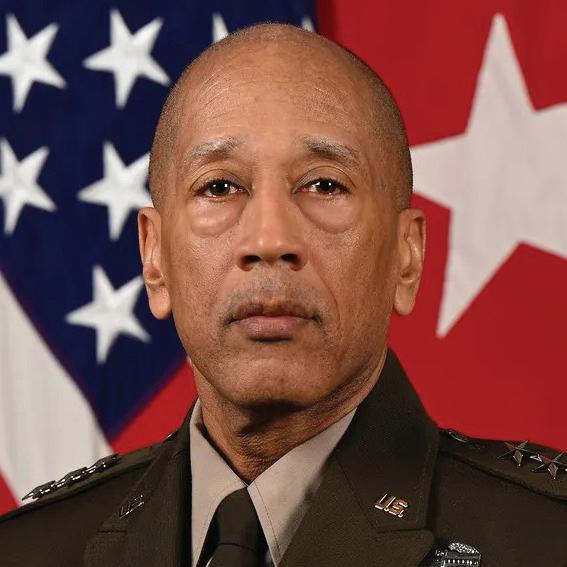
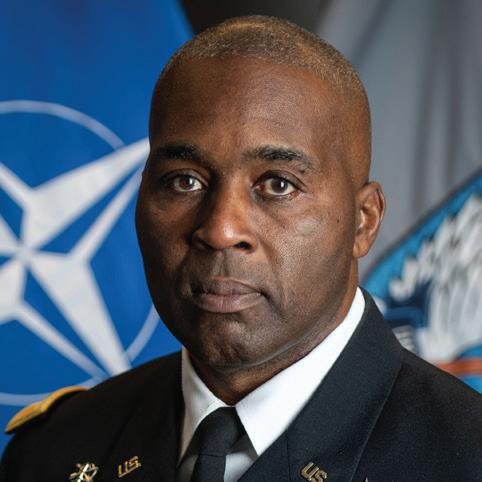

for sustainment to enable total Army readiness. Prior, Hamilton commanded the 8th Theater Sustainment Command, the lead integrator for all sustainment operations in the U.S Indo-Pacific Command area. Previously, he served as the assistant chief of staff, J-4, United States Forces Korea. He also commanded Defense Logistics Agency—Troop Support. His unit provided $14 billion annually of food, clothing, textiles, construction, engineering equipment, and industrial hardware for America’s warfighters, ensuring the combatant commander’s freedom of maneuver.
Hamilton has several overseas tours along with three deployments to Afghanistan. During his last deployment, he served as the commander of the 101st Sustainment Brigade, leading Task Force Lifeliner. He is a distinguished military graduate from Officer Candidate School. Hamilton graduated from Virginia State University and earned a master’s degree in public administration from Central Michigan University and a second master’s degree in military studies from The Marine Corps University. His military education includes Senior Service College as a 2012 Office of the Assistant Secretary of Defense (OSD) corporate fellow.
LT. GEN. DONNA W. MARTIN
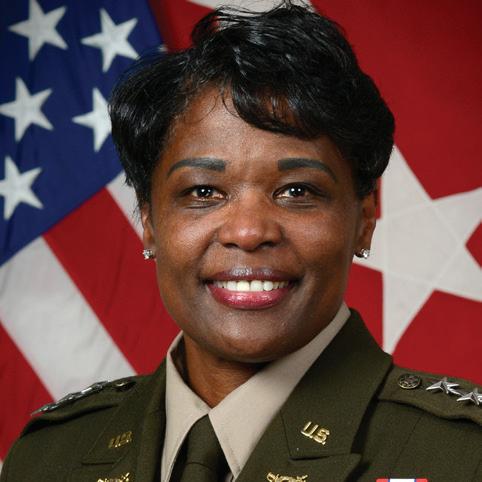
The Inspector General
The United States Army
Lt. Gen. Donna Martin assumed responsibility as the 67th inspector general of the United States Army in September 2021. Previously, she was the provost marshal general of the U.S. Army, serving as the principal military advisor to the secretary of the Army and the chief of staff of the Army on policing matters, including law enforcement, criminal investigations, criminal intelligence corrections, biometrics and forensics, physical security, highrisk personnel security, antiterrorism, and detention operations. Concurrently, Martin served as commanding general Army Criminal Investigation Command, the Department of the Army’s independent criminal investigative authority. In 2017, Martin assumed duties as the deputy commanding general of the United States Army Recruiting Command. From June 2017 to August 2018, she served as commandant of the Military Police School. From August 2018 to July 2020, Martin commanded the Maneuver Support Center of Excellence and Fort Leonard Wood. After that command, Martin was appointed commanding general of the Army Criminal Investigation Command. An Old Dominion University alum, she graduated with a Bachelor of Science in criminal justice and was commissioned a second lieutenant in the Military Police Corps in 1988. Martin also earned a master’s in strategic studies from the Army War College in Pennsylvania.


Lt. Gen. A.C. Roper is the deputy commander of the U.S. Northern Command. He previously served as deputy commanding general of the Army Reserve Command. His other assignments have included deputy chief, Chief of the Army Reserve; commanding general 76th Operational Response Command; commanding general of the 80th Training Command; acting deputy commanding general of the 335th Signal Command; commander of 415th Chemical Brigade, while dual-hatted as the Task Force operations commander, JTF-51, Army North for the Command and Control Chemical, Biological, Radiological, Nuclear Response Element-A (C2CRE-A) homeland response mission; chief of staff, 87th Division; and assistant director of staff, 81st Regional Readiness Command. Roper is a graduate of the University of Alabama and the Army War College and holds master’s degrees in criminal justice and strategic studies. Roper’s awards and decorations include the Distinguished Service Medal (with one oak leaf cluster), Legion of Merit (two oak leaf clusters), Bronze Star, Meritorious Service Medal (three oak leaf clusters), Joint Service Commendation Medal, and Combat Action Badge. Roper has over 33 years of law enforcement experience culminating in his 10-year tenure as chief of police of the Birmingham, AL, Police Department. He graduated from the FBI’s National Academy and National Executive Institute.
LT. GEN. KEVIN VEREEN
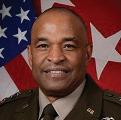
Deputy Chief of Staff, G-9 Office of the Deputy Chief of Staff, G-9 Headquarters, Department of the Army, Washington, D.C. Lt. Gen. Kevin Vereen is the Headquarters, Department of the Army deputy chief of staff, G-9; he assumed duties on Sept. 21, 2022. Most recently, Vereen was commanding general of the U.S. Army Recruiting Command at Fort Knox, KY, from July 23, 2020, until Sept. 21, 2022. From August 2010 to July 2011, he attended the United States Army War College at Carlisle Barracks, PA. Upon graduation, he was selected as brigade commander of the 14th Military Police Brigade at Fort Leonard Wood. Returning to Fort Bragg in 2013, Vereen served as provost marshal and then executive officer to the United States Army Forces
Command commanding general. In 2015, he became the 48th chief and commandant of the Military Police Corps Regiment at Fort Leonard Wood. Then from 2017 to 2019, he served as deputy commanding general of operations at the United States Army Recruiting Command, Fort Knox. Vereen served as the provost marshal general of the U.S. Army and Commanding General U.S. Army Criminal Investigation Command. In those roles, he served as the principal military advisor on policing matters and as the Department of the Army’s independent criminal investigative authority.
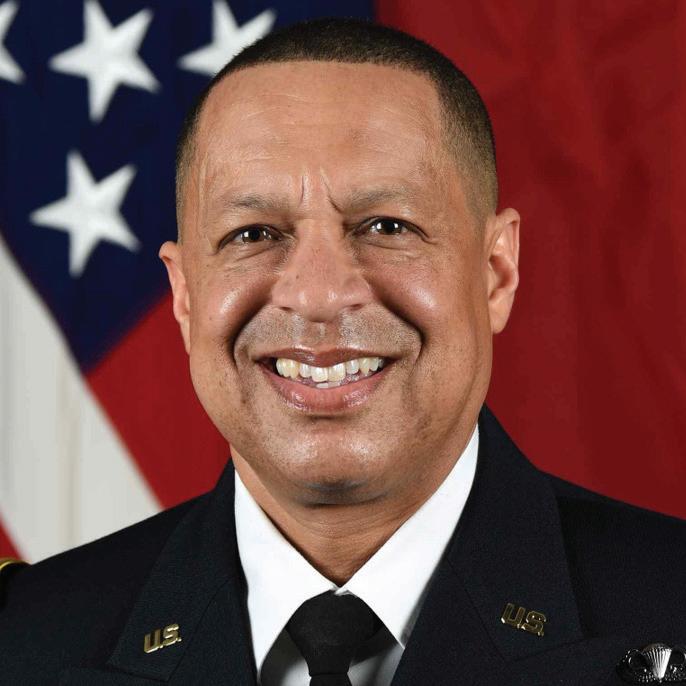
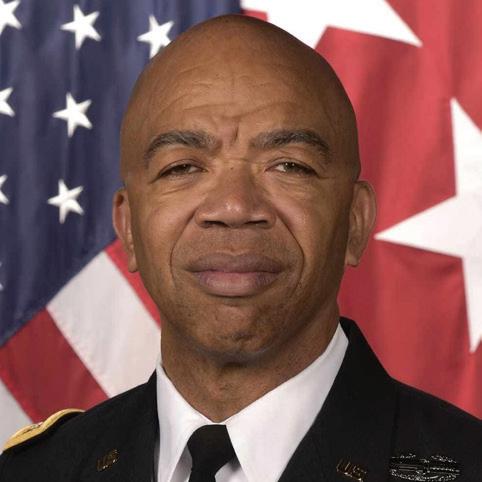
Director of Force Management for the Army G-3/5/7 Maj. Gen. Kevin Admiral currently serves as the director of force management for the Army G-3/5/7.
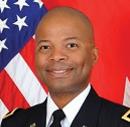



Commissioned as an Armor officer through the Army Reserve Officers' Training Corps (ROTC), Admiral has enjoyed the privilege of leading soldiers in armor, cavalry, Stryker, and mechanized infantry units in Korea, Iraq, Afghanistan, and multiple locations in the United States. During staff assignments, Admiral taught at the Armor Captain’s Career Course, as an aide-de-camp to the 36th Army chief of staff, and as an executive officer to the U.N. Command/Combined Forces Command/U.S. Forces Korea commander. Before assuming his current duties, he was the 52nd commandant of the U.S. Army Armor School. He received a B.S. in cellular biology from the University of Kansas and an M.S. in campaign planning and strategy from the National Defense University. He graduated from the Royal College of Defence Studies in London, England.
Maj. Gen. Clement Coward assumed the duties of director of the Department of Defense Sexual Assault Prevention and Response Office (SAPRO) in September 2020. Coward graduated and received his commission in the Air Defense Artillery branch as a second lieutenant from the University of North Carolina at Wilmington and entered active duty in 1989. He holds a Bachelor of Arts degree in speech communications, a Master of Arts in national security and strategic studies from the Naval War College, and a Master of Science in strategic studies
in the U.S. Military
from the Army War College. Before joining SAPRO, Coward was the commanding general of the 32nd Army Air and Missile Defense Command based at Fort Bliss, TX. Coward’s key operational assignments include leading at all levels of command and service in support of Operation Desert Storm, Operation Iraqi Freedom, Operation Enduring Freedom, and Spartan Shield. His key staff positions have also included serving on the Joint and Army Staff in the Pentagon. Coward's military awards and decorations include the Distinguished Service Medal, Defense Superior Service Medal, Legion of Merit, Bronze Star Medal, and the Defense Meritorious Service Medal.
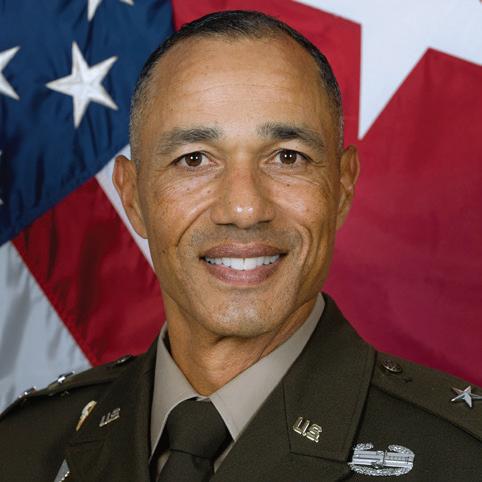
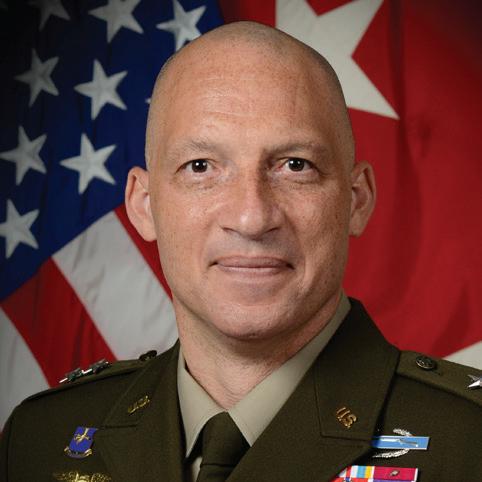

U.S. Army Deputy Surgeon General Falls Church, Virginia

Maj. Gen. Telita Crosland proudly serves as Army deputy surgeon general, the first African American woman to fill this role. As the second highest leader in Army Medicine, she executes the vision of the Army surgeon general, champions Military
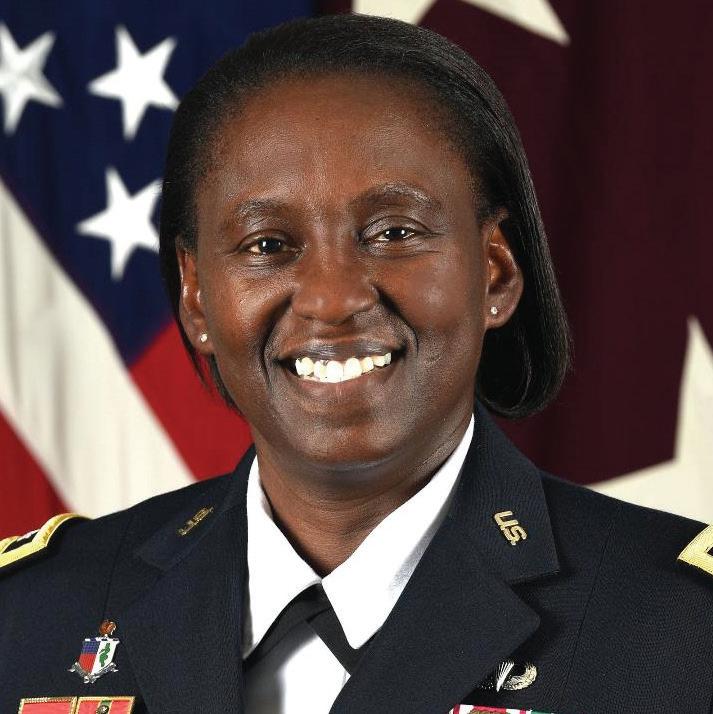
Health System reform, and oversees a multibillion-dollar healthcare system. Crosland is board-certified by the American Board of Family Medicine and is a fellow of the American Academy of Family Physicians. Born in Brooklyn, NY, Crosland entered the Army as a Medical Corps officer in 1993. She graduated from the United States Military Academy at West Point and the U.S. Army Command and General Staff College. She earned her Doctor of Medicine degree from the Uniformed Services University of the Health Sciences (USU) in Bethesda, MD. In addition, she holds a Master of Public Health degree from USU and a Master of Science in resource strategy from the Dwight D. Eisenhower School for National Security. Throughout her distinguished career, Crosland’s clinical expertise and leadership include senior physician and officer in charge of health clinics, associate program director of family medicine residency, and Human Resources Command Medical Corps branch chief. She has commanded honorably at every level within Army Medicine.
MAJ. GEN. JOHNNY
Commanding General United States Army Recruiting Command Maj. Gen. Johnny K. Davis served as the commanding general of the U.S. Army Joint Modernization Command at Fort Bliss, Texas, from June 2018 to June 2020; chief of staff at U.S. Army Futures Command in Austin, TX, from June 2020 to July 2021; and as commanding general, U.S. Army Cadet Command and Fort Knox, KY, from August 2021 to September 2022. He assumed command of the U.S. Army Recruiting Command


and Fort Knox, in October 2022. He was commissioned by New Mexico Military Institute in 1989 through the Reserve Officers' Training Corps Early Commissioning Program. He began his career with the 24th Infantry Division at Fort Stewart, GA. After attending the Command and General Staff College, Davis was assigned to the 101st Airborne Division at Fort Campbell, KY where he served as a battalion and brigade operations officer and executive officer. He then served as the aide to the vice chairman of the Joint Chiefs of Staff and Joint Staff J8 capabilities officer. Davis attended the National War College at Fort McNair, Washington, D.C., and followed with an assignment as the director of the U.S. Wounded Warrior Program.
MAJ. GEN. ROBERT L. EDMONSON II Commander of the U.S. Army Communications-Electronics Command and Senior Commander of Aberdeen Proving Ground Maj. Gen. Robert Edmonson took up assignment as commander of the Army CommunicationsElectronics Command and senior commander of Aberdeen Proving Ground in 2021. As the commanding general for a 9,000-person, two-star global command and senior commander of a 28,000-person military base, Edmonson serves as the Army’s Command, Control, Communications, Computers, Cyber, Intelligence, Surveillance, Reconnaissance, and medical materiel integrator. He is responsible for enabling the Army’s warfighting readiness by providing sustainable global C5ISR and medical materiel support. A native of Willingboro, NJ, Edmonson received his commission from Frostburg State University. He holds a Bachelor of Science in business marketing, a Master of Science Administration in information resource management from Central Michigan University, and a Master of Science in national security strategy from the National Defense University. In 2022, he received an honorary degree from Frostburg State University. Throughout his 31-year career, Edmonson has served in various command and staff positions at the tactical, operational, and strategic levels. In his previous assignment, he served as the deputy chief of staff, G-6/chief information officer, U.S. Army Forces Command at Fort Bragg, NC.
MAJ. GEN. SEAN A. GAINEY Director, Joint C-UAS Office and Director, Fires in the G-3/5/7, HQ Department of the Army Maj. Gen. Sean Gainey is director of the Joint Counter-small Unmanned Aircraft Systems Office (JCO) and director of fires in the G-3/5/7, HQ Department of the Army. The JCO is an executive agent office for all counter-small, unmanned aircraft systems (C-UAS) activities by the defense secretary. The fire director is responsible for training and equipping air defense and long-range artillery activities for the Army. Gainey graduated from Georgia Southern University in 1990 and was commissioned as a second lieutenant in air defense artillery. His military education includes the Air Defense Officer Basic and Advanced Courses, Command and General Staff College, and Senior Service College at the Dwight D. Eisenhower School for National Security. Gainey's first duty assignment was in the 2d Air Defense Artillery Regiment in Germany. He was then assigned to the 43d Air Defense Artillery Regiment, Fort Bliss, TX, where he served as an assistant operations officer. He later deployed to support Operation Southern Watch and served as an air defense artillery observer/ controller. He was assigned to the 7th Air Defense Artillery, U.S. Army Europe, where he later deployed to support Operation Iraqi Freedom. Gainey’s awards and decorations include the Legion of Merit, Joint Service Achievement Medal, Air Force Achievement Medal, Meritorious Unit Citation, and Parachutist Badge.
MAJ. GEN. MITCHELL L. KILGO Deputy, The Inspector General
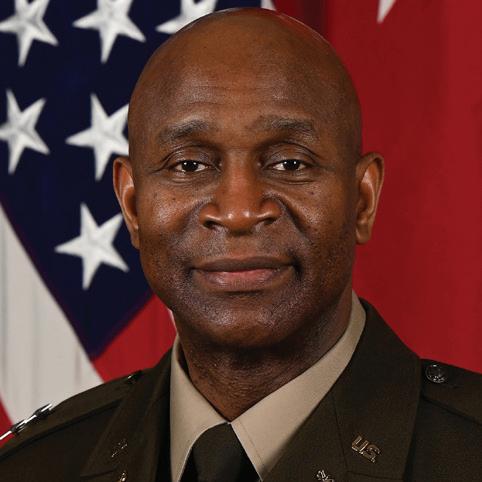

Maj. Gen. Mitchell Kilgo assumed responsibility as a deputy of the inspector general in the U.S. Army Inspector General Agency in 2021. Previously, the major general served as the 16th commander of the U.S. Army CommunicationsElectronics Command (CECOM) and senior commander of Aberdeen Proving Ground. Kilgo was a command, control, communications, computers, cyber, intelligence, surveillance, and reconnaissance (C5ISR) materiel integrator. Kilgo has served in various command and staff positions throughout his Army career. He has commanded at every operational level from company to theater signal command, with significant assignments such as commanding general, 5th Theater Signal
Command, Wiesbaden, Germany. Kilgo is a graduate of the National War College, Command and General Staff College, and Signal Officer Basic and Advanced Courses. Raised in Newport News, VA, Kilgo entered active duty in 1988 after graduating from Virginia Union University with a Bachelor of Science degree in mathematics and natural sciences. He also holds a Master of Science degree in systems technology (Joint Command, Control, and Communications) from the Naval Postgraduate School and a Master of Science degree in national security strategy from the National War College.
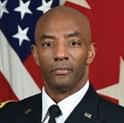



Maj. Gen. Gavin Lawrence graduated from the U. S. Military Academy (USMA) in 1995 and, upon graduation, was commissioned as a second lieutenant in the Army Quartermaster Corps. His civilian education includes a bachelor’s degree in international relations from USMA, a master’s degree in national security and strategic studies from U.S. Naval War College, and a master’s degree in strategic studies from the Army War College. He has also completed the Massachusetts Institute of Technology (MIT) Seminar XXI Program and the University of North Carolina’s Institute for Defense and Business advanced program in logistics and technology. Lawrence has held several key staff and joint assignments, including supply and services officer; support operations officer; executive officer; and director of readiness, strategy, and operations. Lawrence’s command assignments include the Headquarters and Distribution Company for 225th Forward Support Battalion, Division Support Command, and the Defense Logistics Agency Troop Support commander. Lawrence’s combat and operational service include one deployment to Iraq in support of Operation Iraqi Freedom and three deployments to Afghanistan in support of Operation Enduring Freedom. Before assuming his current role, Lawrence served as the deputy chief of staff, G-4, U.S. Army Forces Command at Fort Bragg, NC.
MAJ. GEN. JETH B. REY Director, Network Cross-Functional Team
Maj. Gen. Jeth B. Rey serves as the director of the network cross-functional team within Army Futures Command, focusing on integrating and modernizing the Army’s network. Rey is responsible for continuously improving network, command, control, communications, and intelligence to enable mission command across the tactical network. This will allow the speed, range, and convergence required to achieve decision dominance and overmatch against near-peer adversaries. Rey
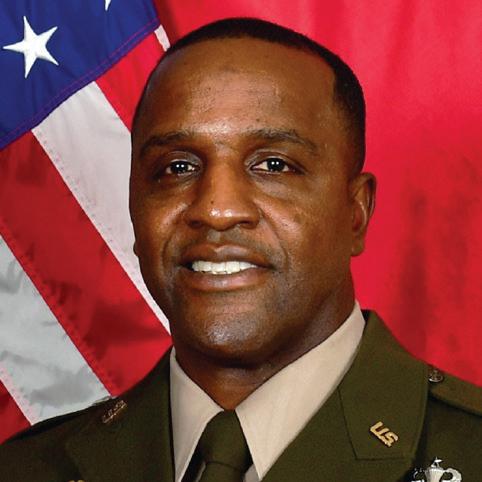
in the U.S. Military



previously served as the director of Command and Control, Communications, and Computer Systems, J-6, United States Central Command (USCENTCOM), MacDill Air Force Base, FL, where he was responsible for

implementing and managing USCENTCOM’s global communications, cybersecurity, and computer networks.
Rey is a native of St. Thomas, United States Virgin Islands, and has served in Army enlisted, warrant, and officer positions. He received his commission from the Army’s Officer Candidate School and was commissioned into the U.S. Army Signal Corps. He has received three master’s degrees, including telecommunications management, national security studies from the Naval War College, and strategic studies from the United States Army War College.
MAJ. GEN. MICHEL M. RUSSELL, SR. Commanding General, 1st Theater Sustainment Command
Maj. Gen. Michel Russell joined the Army Reserve in 1983 as an enlisted field artilleryman. In 1987, he graduated from John Jay College and was commissioned as a second lieutenant from Fordham University ROTC as a distinguished military graduate. In 1991, Russell was detailed to the Ordnance Corps from the Air Defense Artillery branch. He served as the 28th chief of transportation, then as the U.S. Forces Korea J-4, and later as the commanding general for the 19th Expeditionary Sustainment Command in South Korea. Russell recently served as the Headquarters, Department of the Army assistant deputy chief of staff, G-4. Russell currently serves as commanding general for the 1st Theater Sustainment and the deputy commanding general—Sustainment for U.S. Army Central. Russell is a Marine Corps Staff College graduate and the Eisenhower School for National Security and Resources. Russell’s awards and decorations include the Parachutist Badge, the Army Staff Badge, the Office of the Secretary of Defense Staff Badge, the Joint Chiefs of Staff Badge Chairman, and the Combat Action Badge. He holds three master’s degrees and is a certified Lean Six Sigma Green Belt.
MAJ. GEN. JAMES SMITH Commander, 21st Theater Sustainment Command Maj. Gen. James Smith assumed the 21st Theater Sustainment Command in 2021. Before that, he served as the chief for transportation/commandant
at the United States Army Transportation School. A native of Hampton, VA, he was commissioned into the United States Army in 1992 from Christopher Newport University in Newport News, VA, where he graduated with a Bachelor of Science in business administration (concentration in accounting). His military education includes the Chemical Officer Basic Course, the Combined Logistics Officer Advanced Course, the United States Army Command and General Staff College, the School of Advanced Military Studies, and the United States Marine Corps War College. He holds a Master of Business Administration degree from Webster University, a Master of Science in logistics management from Florida Institute of Technology, a master’s degree in theater operations from the U.S. Army Command and General Staff College, and a master’s degree in strategic studies from the Marine Corps War College. Smith's command assignments include 3rd Expeditionary Sustainment Command; 599th Transportation Brigade; 215th Brigade Support Battalion, 3d Brigade Combat Team, 1st Cavalry Division; and B Company, 701st Main Support Battalion, 1st Infantry Division, U.S. Army Europe.
MAJ. GEN. MICHAEL J. TALLEY Commanding General and Commandant of the U.S. Army Medical Center of Excellence
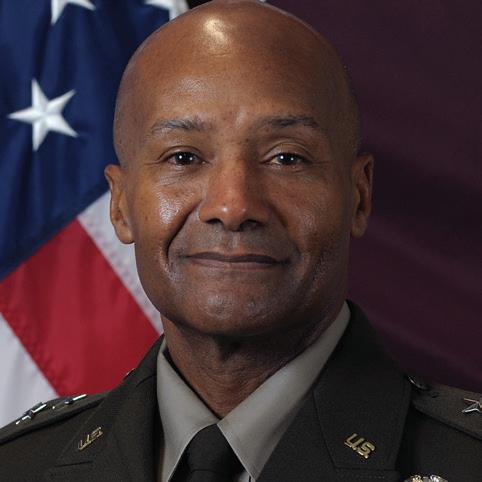
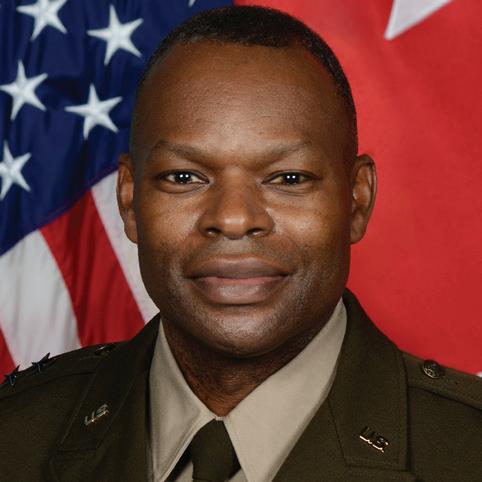
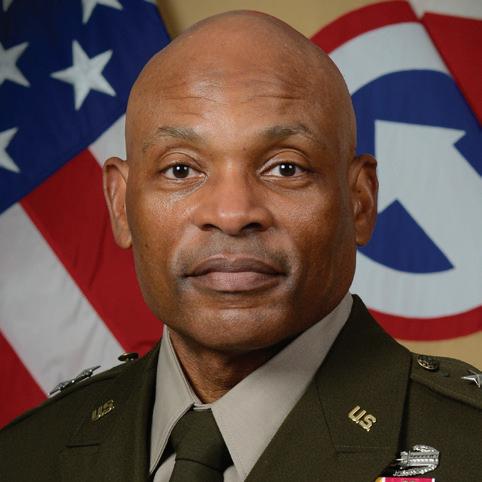
Maj. Gen. Michael J. Talley is the commanding general and commandant of the U.S. Army Medical Center of Excellence. He served in the enlisted ranks from 1983–1989, graduated with honors from the University of Texas at El Paso, and was commissioned as a distinguished military graduate in 1991. He previously served as commanding general of the United States Army Medical Research and Development Command and Fort Detrick and has commanded at every level from company through brigade. He served two OIF combat tours and deployment to Saudi Arabia. He has also held key leadership positions at both combat training centers, Army Special Operations Command, Defense Logistics Agency, Office of the Surgeon General, and Forces Command. Talley is a graduate of the Army Command & General Staff College, Advanced Military Studies Program, and Army War College. He holds two Master of Military Arts & Sciences degrees, a master’s in strategic studies, and a master’s in health services management.
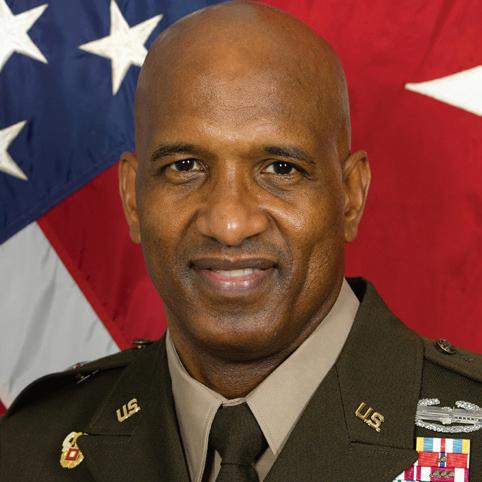
MAJ. GEN. WILLIAM L. THIGPEN
Commanding General, U.S. Army South Maj. Gen. William Thigpen is the commanding general of the U.S. Army South, headquartered at Fort Sam Houston, TX. He is a native of Hampton, VA, and graduated from Virginia State University with a bachelor’s degree in public administration. He was commissioned as an armor officer in the Army from the Trojan Warrior ROTC Battalion. Before assuming command of Army South, he served as deputy director for operations, OT-4, Joint Staff, J-3 National Military Command Center, and Pentagon. Thigpen served as the acting senior commander for the 4th Infantry Division, Fort Carson, and deputy commanding general for Support. Thigpen is a combat veteran of Iraq and Afghanistan who has commanded at every level, from the company through brigade. After commanding the 316th Cavalry Brigade at Fort Benning, GA, he served as a CSA senior fellow at the Center for Strategic and International Studies in Washington, D.C. One of his key staff positions includes aide-de-camp to the vice chief of staff of the Army. Thigpen is a graduate of the National War College. He has a master’s degree in national security and strategic studies and another in business administration from Embry-Riddle Aeronautical University.


Maj. Gen. David Wilson became the Army Sustainment Command commanding general on July 19, 2022. He is a distinguished military graduate of The Citadel, The Military College of South Carolina, and was commissioned in the field artillery in 1991. Wilson is the first African-American graduate of The Citadel to become a two-star general. Assignment highlights include commanding general of the 8th Theater Sustainment Command; director of J/U-4 United States Forces Korea/United Nations Command/deputy director, C-4 Combined Forces Command; 40th chief of ordnance and commandant, U.S. Army Ordnance School; executive officer, Army Material Command commanding general; brigade commander, 406th Army Field Support Brigade; and battalion commander, 121st Brigade Support Battalion, 1st Armored Division. His operational deployments include Operation Restore/Continue
Hope, Operation Uphold Democracy, Operation Desert Thunder, and Operation Iraqi Freedom I and 09–10. In addition to his Bachelor of Science degree from The Citadel, he holds a Master of Science degree in general administration from Central Michigan University and a Master of Science degree in national resource strategy from the National Defense University.
Deputy Commanding Officer at U.S. Army

Col. Amanda Azubuike received her commission from the University of Central Arkansas and earned a bachelor’s degree in communications. She graduated from flight school as a UH-1 pilot. After the Military Intelligence Captain’s Career Course and Fixed Wing Multi-Engine Qualification Course, she served as an RC-12 pilot. After the Public Affairs Officer Qualification Course, Azubuike was assigned to Coalition Forces Land Component Command, where she served as a public affairs officer. After Command and General Staff College, she served as media relations chief and public affairs officer and spent time in Kuwait. Later, Azubuike attended Georgetown University, earning a master’s degree in public relations and corporate communications. She was assigned to community outreach in the Pentagon’s Office of the Chief of Public Affairs. After attending Army War College, she was appointed public affairs director to the 3rd Infantry Division. On promotion to colonel, she was assigned to the Joint Force Headquarters/Military District of Washington as the public affairs director. Next, Azubuike served as the chief of public affairs for the Southern Command. Later, she served as the chief of staff and senior military assistant to the principal deputy in the Office of the Secretary of Defense.
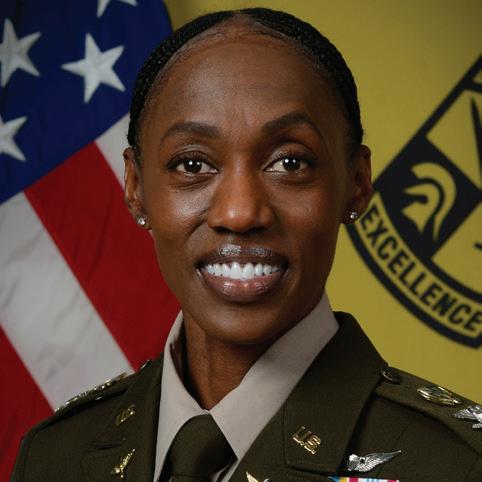
BRIG. GEN. MAURICE O. BARNETT Commanding General, 10th Army Air Missile Defense Command
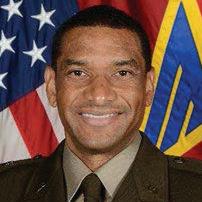
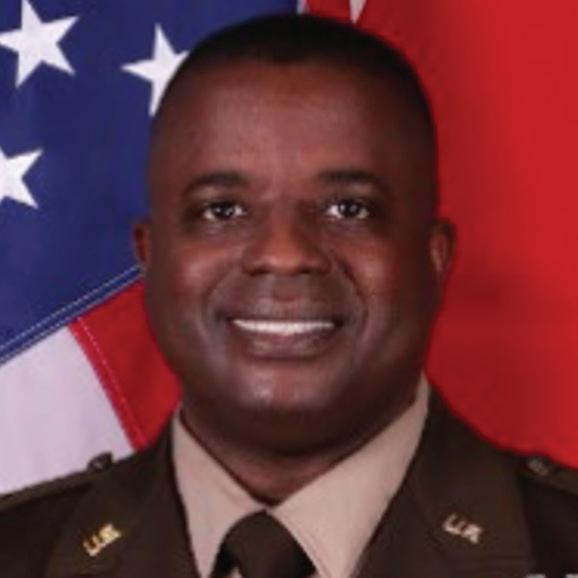
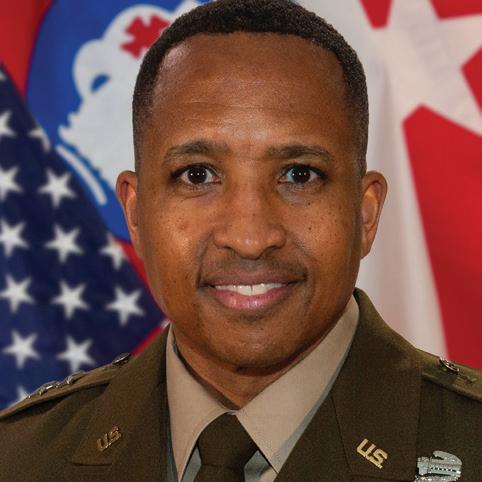
Brig. Gen. Maurice Barnett is the commanding general for the 10th Army Air Missile Defense Command. Before assuming his current position, Barnett served as deputy commanding officer for the Army Cadet Command. Upon graduation from Indiana University, he was commissioned as a second lieutenant in the Air Defense Artillery Corps. He is also a graduate of



the Air Defense Officer Basic and Advanced Courses, Combined Arms Services Staff School, Command and General Staff College, and Marine Corps War College. He holds a master’s degree in strategic studies from the Marine Corps War College and a Master of Science in kinesiology from Indiana University. Barnett has held a variety of leadership and staff positions throughout his career. His initial assignment was with the 4th Infantry Division. Following battery command, Barnett participated in the Army’s Advanced Civil Schooling Program and attended Indiana University. Upon completing his studies, he assumed duty as an instructor in the Department of Physical Education at the U.S. Military Academy. In 2007, Barnett deployed in support of Operation Enduring Freedom, serving as a training officer for the counter-improvised explosive device task force. More recently, he commanded the 30th Air Defense Artillery Brigade and served as executive officer at Headquarters, Department of the Army.
BRIG. GEN. DAPHNE D. DAVIS Deputy Commanding General Support U.S. Army Recruiting Command

Brig. Gen. Daphne Davis was commissioned as an Adjutant General Corps officer upon graduation from the University of Kentucky. She completed the Officers Basic Course and served 11 years as a troop program unit soldier. Davis assumed command of the 1/399th Headquarters Company serving as a company commander. Following that tenure, she served as the 1/399th Battalion operations officer. Upon entering the Active Guard Reserve Program in 2002, Davis was assigned to the 90th Regional Readiness Command, serving as chief, Reserve Personnel Division. Subsequently, she reported to Human Resources Command. While stationed there, she was a career manager for The Army Reserve Active-duty Management Directorate, chief of officer management, and Headquarters and headquarters company commander. Davis moved on to serve in the U.S. Army Reserve Command. Upon completing her tour at Fort McPherson and Fort Bragg, she served as the Adjutant General Division chief in the United States Army Civil Affairs and Psychological Command Headquarters. Davis then served as the battalion commander of the 3-312th Training Support Battalion. Following that command, she served in the Headquarters, Department of the Army, G-1 Directorate of Military Personnel Management, as chief, Integration Policy Branch, and was later assigned to the Army Talent Management Task Force.
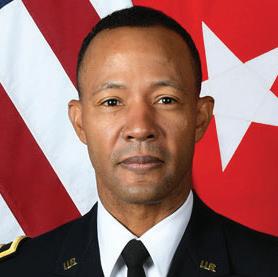
Brig. Gen. Andrew Gainey has served over 27 years as an officer. A South Carolina native, Gainey graduated from the University of South Carolina and was commissioned as a second lieutenant of field artillery. He has completed combat deployments to Iraq and Afghanistan. Gainey’s military education includes the Field Artillery Officer Basic Course, Field Artillery Officer Advanced Course, Command and General Staff Officers Course, and the Marine Corps War College. He holds a Bachelor of Science degree in management, a Master of Science degree in occupational education from Kansas State University, and a Master of Science degree in strategic studies from the Marine Corps War College. Gainey made history as one half of the second set of AfricanAmerican general officer siblings on his promotion.
BRIG. GEN. ANTOINETTE GANT Commander, South Pacific Division


Col. (Promotable) Antoinette Gant assumed duties as the South Pacific Division, U.S. Army Corps of Engineers (USACE) commander and division engineer in July 2021. The region encompasses all or part of 10 states with four operating districts headquartered in Albuquerque, NM; Los Angeles, CA; Sacramento, CA; and San Francisco, CA. A native of Mississippi, Gant graduated from Prairie View A&M University as a distinguished military graduate with a Bachelor of Science in civil engineering and a commission in the Engineer Regiment. Most recently, Gant commanded the USACE South Pacific Border District. She previously served as the combined joint engineer for the Resolute Support and OFS headquarters in Kabul, Afghanistan; military assistant to the assistant secretary of the army—Civil Works, Washington, D.C.; chief of operations for the Engineer Directorate, U.S. Army South, Fort Sam Houston, San Antonio, TX; and the director for the Directorates of Public Works and Installation Support, Area Support Group Kuwait. Other USACE assignments include commander for both the Albuquerque and Louisville Districts. She has received several national and community awards, including the 2021 BEYA Army Stars and Stripes Award and a BEYA Special Recognition Award.
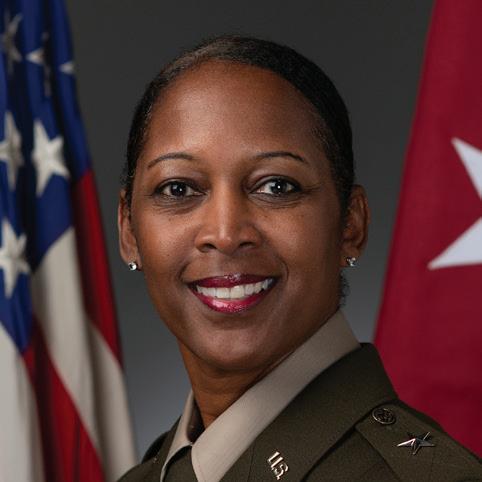
Army’s 26th deputy chief of chaplains



Chaplain (Brig. Gen.) William Green became the Army’s 26th deputy chief of chaplains in August 2019. As the deputy chief of chaplains, Green supports the chief chaplain in leading the Army Chaplain Corps to provide
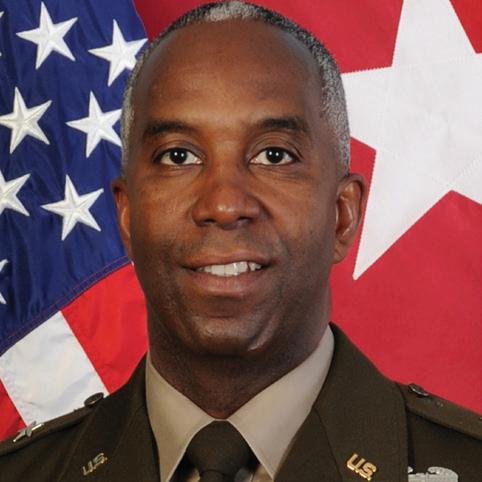
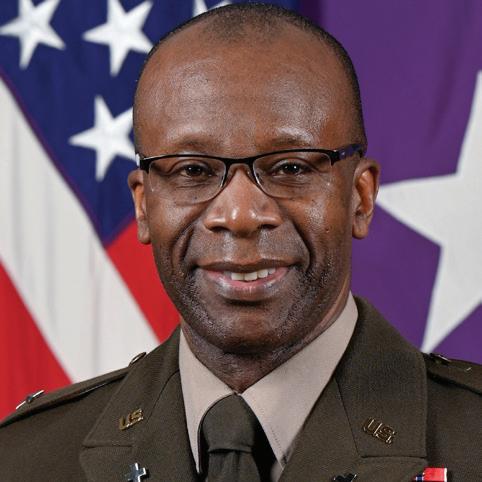
religious support to soldiers, families, and civilians of the U.S. Army. A native of Savannah, GA, Green grew up on Hilton Head Island in South Carolina. He is a distinguished military graduate of Savannah State University with a Bachelor of Science in criminal justice. In 1992, he graduated from Emory University in Decatur, GA, with a Master of Divinity degree from Candler School of Theology. He was endorsed by the National Baptist Convention, U.S.A., Inc., and became an Army chaplain in 1994.
BRIG. GEN. RICHARD A. HARRISON Deputy Chief of Staff G-3/5/7 Training and Doctrine Command (TRADOC)
Brig. Gen. Richard A. Harrison assumed duties as the deputy chief of staff, G-3/5/7 TRADOC on June 15, 2022. TRADOC builds and sustains our highly trained, disciplined, and fit Army. A native of Sunbury, NC, Harrison graduated from Elizabeth City State University in North Carolina with a Bachelor of Science in business administration and a commission in the Air Defense Artillery branch. Most recently Harrison was the commandant of the Air Defense Artillery School and deputy commanding general of Fort Sill, OK, from July 2000 to April 2022. He previously served as the commanding general, Task Force Pickett, in support of Operation Allies Welcome, Fort Pickett, VA; executive officer to the commanding general UNC/CFC/USFK, South Korea; executive assistant to the Joint Staff J-3, Washington, D.C.; and division chief, Mission Assurance Division, Joint Staff J-3, Washington, D.C. Other assignments include commander, 69th ADA Brigade, Fort Hood, TX; commander, 3-4th ADAR, Fort Bragg, NC; and numerous staff positions. He has received the Elizabeth City State University Chancellor’s Legacy Award in 2021 and the ROTC National Hall of Fame in 2016.
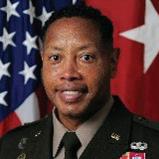
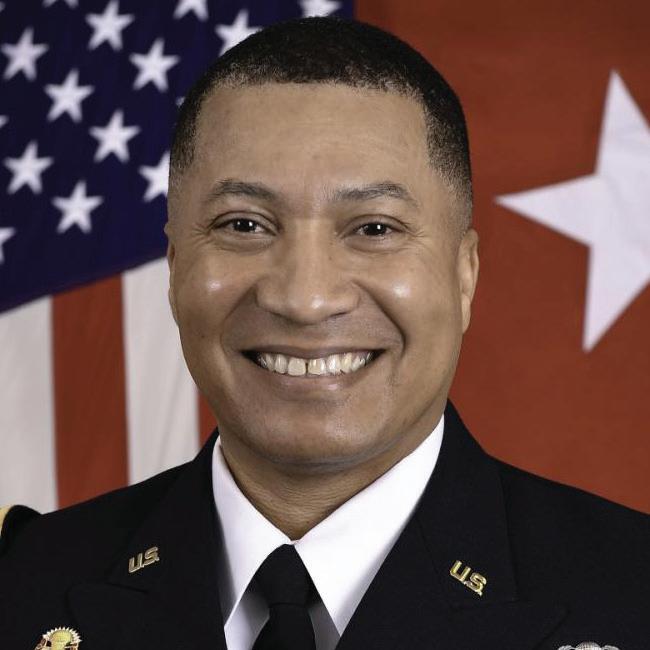
Brig. Gen. Daryl Hood assumed command of the 20th Chemical, Biological, Radiological, Nuclear, Explosives (CBRNE) Command on Sept. 7, 2022, at Aberdeen Proving Ground. He is responsible for staffing, equipping, and training a highly technical, special-purpose formation of 3,500 soldiers and 225 civilians in 16 states on 19 different installations. The command includes the 48th Chemical Brigade, the 52nd and 71st Ordnance Groups (EOD), the 1st Area Medical Laboratory, and the CBRNE Analytical and Remediation Activity (CARA). Hood has served in various command and staff assignments in the United States, Europe, South Korea, the Middle East, and Central Asia throughout his career. Most notably, he served as 3rd Chemical Brigade; commander, 110th Chemical Battalion; and commander, 87th Chemical Company, 4th Squadron (Aviation), 2nd Armored Cavalry Regiment. More recently, Hood served as chief of chemical and commandant U.S. Army Chemical, Biological, Radiological, and Nuclear (CBRN) School from 2019–2021. Hood graduated from the U.S. Army’s Chemical Officer Basic and Advanced Courses, Army Combined Arms Services Staff School, Army Command and General Staff College, and U.S. Air Force Senior Service College.
BRIG. GEN. JASON E. KELLY Commander, U.S. Army Training Center, and Fort Jackson
Brig. Gen. Jason Kelly attended the U.S. Military Academy and graduated with a commission as an engineering officer. He became the U.S. Army Training Center and Fort Jackson commander on Aug. 31, 2022. His previous assignment was as commanding general of the Army Corps of Engineers, South Atlantic Division. Kelly joined the division from the Pentagon, serving as director of the Office of the Chief of Engineers. Before that assignment, Kelly commanded the U.S. Army Corps of Engineers Afghanistan District from 2018 to 2019 and the U.S. Army Corps of Engineers Norfolk District from July 2015 through June 2018. He has held leadership positions with duty in Asia, the Middle East, and the United States, including as commander of the 20th Engineer Battalion in Afghanistan; deputy commander of the 36th Engineer Brigade during Operation Iraqi Freedom/Operation New Dawn; commander of Headquarters and Headquarters

in the U.S. Military
Company, 11th Engineer Battalion, 3rd Infantry Division; assistant operations officer for the 10th Engineer Battalion, 3rd Infantry Division; adjutant for both the 44th Engineer Battalion and the 2nd Infantry Division Engineer Brigade in Korea; plans officer for the 4th Infantry Division Engineer Brigade; and company executive officer in the 588th Engineer Battalion, 2nd Armored Division.
BRIG. GEN. MARK C. QUANDER

79th Commandant, U.S. Corps of Cadets U.S. Military Academy, West Point

Brig. Gen. Mark Quander has served as the commandant of the United States Military Academy cadets since May 2021. He previously served as the 98th commandant of the United States Army Engineer School from 2019 to 2021 and as commander of the Transatlantic Division of the United States Army Corps of Engineers from 2018 to 2019. He has also served in command and staff positions in the U.S., Korea, the Middle East, and Asia. His tours of duty include the: 307th Engineer Battalion, 82nd Airborne Division; 2nd Engineer Battalion, 2nd Infantry Division (Republic of Korea); 326th Engineer Battalion, 101st Airborne Division (Air Assault); 20th Engineer Brigade; and 36th Engineer Brigade. His assignments include observer controller at the Joint Readiness Training Center and Corps engineer for III Corps. At the Department of the Army, he fulfilled duties as director of the Office of the Chief of Engineers. Quander holds a Bachelor of Science degree from the United States Military Academy in civil engineering, a Master of Science from Missouri University of Science and Technology in engineering management, and a Master of Arts from Georgetown University in public policy.

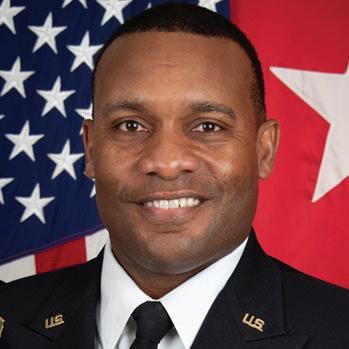
BRIG. GEN. RONALD R. RAGIN Commander, 13th Expeditionary Sustainment Command Brig. Gen. Ronald Ragin is currently assigned as commanding general of the 13th Expeditionary Sustainment Command. His previous assignments include troop commander, 11th Armored Calvary Regiment (Fulda); company commander,
225th Forward Support Battalion, 25th Infantry Division (Light); battalion commander, Group Support Battalion, 3rd Special Forces Group (Airborne); support squadron commander, 1st Special Forces Operational Detachment (Delta); brigade commander, 4th Infantry Division

Sustainment Brigade, 4th Infantry Division, and U.S. Army Operational Test Command. Staff assignments include 11th Armored Calvary Regiment (Fulda); Division Support Command, 101st Airborne Division (Air Assault), 25th Infantry Division (Light); 7th Fleet Command Ship (USS Blue Ridge); 528th Special Operations Support Battalion (Airborne); Joint Special Operations Task Force—Iraq; 7th Special Forces Group (Airborne), Combined Joint Special Operations Task Force— Afghanistan; the United States Special Operations Command; and the Army Materiel Command. His education includes a Bachelor of Science from the University of Texas, a Master of Science in strategic studies from the Naval War College, a Master of Arts in international relations from Troy University, and a Ph.D. in public policy from Walden University. He completed the Harvard National Security Fellowship Program and is a graduate of the Harvard John F. Kennedy School of Government.
Deputy Chief of Staff—Maneuver, Multi-National Corps Northeast (Poland)

Brig. Gen. Monte’ L. Rone assumed duties as deputy chief of staff—Maneuver for Multi-National Corps Northeast in Szczecin, Poland, on July 12, 2022. Rone is a native of Muskegon Heights, MI. He was commissioned as an infantry officer upon graduation from Eastern Michigan University in 1995. Rone has served in airborne, mechanized/armor, and Stryker formations. Rone’s command assignments include commander of the 1st Cavalry Division (Forward), Poznan, Poland, in support of Operation Atlantic Resolve; brigade commander of the 1st Stryker Brigade Combat Team, 4th Infantry Division, Fort Carson, CO, as deputy commander for Train Advise Assist Command—East (TAAC-East), in Afghanistan; and battalion commander of the 2nd Battalion, 12th Cavalry Regiment, 1st Cavalry Division, Fort Hood, TX, where he also served as the commander of Task Force Thunderhorse, Laghman Province, Afghanistan. Rone holds a Bachelor of Business Administration in accounting and auditing from Eastern Michigan University, a Master of Science in public policy administration from Georgetown University, and a master's in strategic studies from the United States Army War College. His operational experience includes deployments to Afghanistan, Iraq, East Africa, and Eastern Europe.
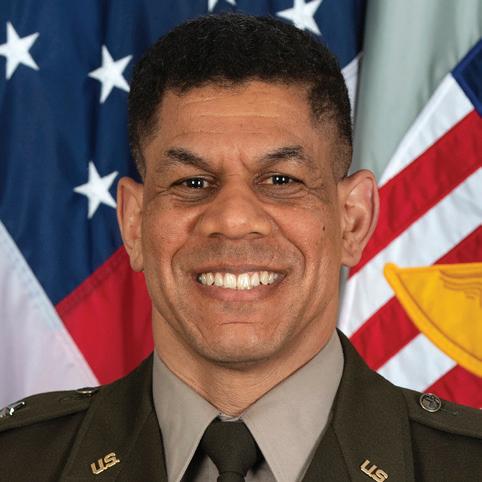
Chief Judge for U.S. Army Court of Criminal Appeals (Individual Mobilization Augmentee)
Brig. Gen. Ronald Sullivan serves as chief judge for
the U.S. Army Court of Criminal Appeals (Individual Mobilization Augmentee). His previous assignments in the Army Reserve include: staff judge advocate for the 377th Theater Sustainment Command (Louisiana); deputy commanding





officer (East) of the U.S. Army Reserve Legal Command (Maryland); commander of the 87th Legal Operations Detachment (LOD) (Utah); command judge advocate for the Central Medical Area Readiness Group (Illinois); deputy commander of the 2nd LOD (Louisiana); deputy team leader and team leader of the 1st LOD (Texas); assistant general counsel at the Army Air Force Exchange Service (Texas); and his first Army Reserve assignment, in 2006, was as a training officer at the U S. Army Trial Defense Service, Defense Counsel Assistance Program (Virginia). In his civilian capacity, he is the chief of acquisition, personnel, and ethics law for the U.S. Army Futures Command, Office of the Staff Judge Advocate in Austin, TX. Sullivan was raised in San Antonio, TX. He earned his Bachelor of Business Administration (information systems) degree from Howard University and was commissioned as a second lieutenant in the U.S. Army in 1993. He earned his Juris Doctor degree from The University of Kansas, School of Law, in 1996.

BRIG. GEN. JACKIE L. THOMPSON, JR. Chief Defense Counsel, Office of Military Commissions Brig. Gen. Jackie Thompson’s career spans over 31 years as a judge advocate and Army officer.
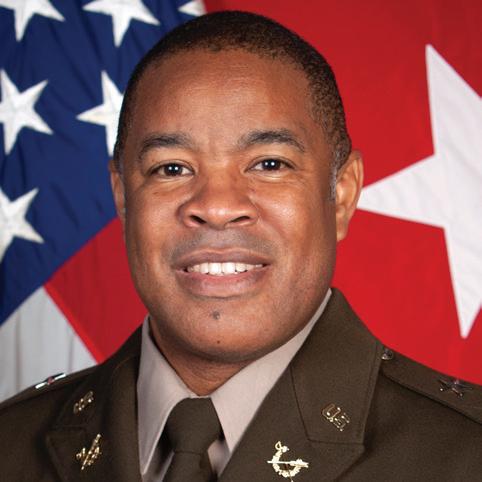
Thompson has served as chief of the U.S. Army Trial Defense Service. Before assuming those duties, he was the staff judge advocate for Fort Benning, GA. Prior, he served as deputy staff judge advocate for U.S. Army Europe, deputy staff judge advocate for Army Central Command, and a brigade judge advocate. Other assignments include service as the chief of administrative law and chief of justice at Fort Jackson, SC; senior defense counsel for U.S. Forces in Northern Iraq; and trial counsel, legal assistance, and tax attorney at Fort Sam Houston, TX. Thompson graduated from Illinois State University with a bachelor’s degree in criminal justice. While a member of the Army National Guard, he was commissioned from Illinois Military Academy Officer Candidate School. He received his Juris Doctor Degree from Northern Illinois University School of Law. Thompson also holds an LL.M. in military law from The Judge Advocate General’s Legal Center
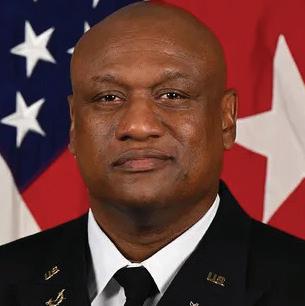
and School U.S. Army. He is a 2010 graduate of the Army Command and General Staff College. Thompson is admitted to practice before the Army Court of Criminal Appeals, the Court of Appeals for the Armed Forces, the U.S. Court of Federal Claims, and the United States Supreme Court.
Retired Master Sgt. Lonnie Coleman, the senior Army instructor for Kirby High School Army JROTC, nominated Cadet C’Azia Hamilton for the Medal of Heroism, the highest Department of the Army medal exclusively awarded to Army ROTC and JROTC Cadets. The medal is presented to those who perform an act of heroism where the “acceptance of danger and extraordinary responsibilities, exemplifying praiseworthy fortitude and courage’”are involved.
in the U.S. Military

Vice Adm. John Fuller is the son of a retired Army colonel. He received his commission from the Naval Academy in 1987. He earned a Bachelor of Science in political science from the academy, a Master of Science in management from the Naval Postgraduate School, and a Master of Arts in national security and strategic studies from the Naval War College. He commanded USS Mason (DDG 87), Task Group—Iraqi Maritime, and Destroyer Squadron 22. His ashore tours have included the U.S. Naval Academy, the Office of the Chief of Naval Operations, the Joint Staff, and the Office of the Secretary of Defense’s staff.
His flag officer assignments include commander, Navy Region Hawaii/commander, Naval Surface Group, Middle Pacific; commander, Carrier Strike Group 1; director of the strategy, policy, and plans (J-5), North American Aerospace Defense Command and U.S. Northern Command; Joint Staff, J-8, deputy director for Force Protection, which included being director of the Joint Integrated Air and Missile Defense Organization, Force Protection Division, Joint Requirements Office for Chemical, Biological, Radiological, and Nuclear Defense, and chairman of the Protection Functional Capabilities Board. Fuller assumed duties as the 42nd Naval inspector general in June 2021.
Rear Adm. Stephen D. Barnett is a native of Columbia, TN, and a graduate of Tennessee State University. He earned his commission at Aviation Officer Candidate School in 1991. Barnett’s sea duty assignments have included Patrol Squadron (VP) 46, USS John C. Stennis (CVN 74), and VP-5. As commanding officer of VP-47 at Kaneohe, HI, he led the squadron on a simultaneous deployment to Japan and Iraq, executing more than 250 missions in support of Operation Iraqi Freedom, completing more than 950 sorties comprising 5,000 hours.
Ashore, Barnett served as a detailer at the Bureau of Naval Personnel, naval flight officer instructor for VP-30, assistant Joint Requirements Oversight Council secretariat, senior program analyst for chief of naval Operations (OPNAV N80), and deputy executive assistant to the vice chief of Naval operations. As a flag officer, Barnett served as commander of the Navy Region Northwest and commander of the Navy Region Southwest. He assumed command of Navy Region Hawaii on June 17, 2021. His decorations include the Legion of Merit, Meritorious Service Medal, Defense Meritorious Service Medal, Joint Service Commendation Medal, Navy Commendation Medal, and Navy Achievement Medal.


Deputy Director for Politico-Military Affairs (Middle East, Africa)



The Joint Staff, Strategy Plans, and Policy (J5)
Rear Adm. Adan Cruz is a native of Brentwood, NY. He graduated from the United States Naval Academy in 1994 with a Bachelor of Science degree in computer science and was commissioned as a surface warfare officer. Cruz is a graduate of the National War College. His sea duty assignments include USS Shiloh (CG 67); USS Oscar Austin (DDG 79); commander, Destroyer Squadron Two Eight (CDS 28); and USS Lake Champlain (CG 57). He has deployed multiple times to the 5th, 6th, and 7th Fleets. He has served as the commanding officer of USS Mason (DDG 87), USS Lewis B. Puller (ESB 3), and the commander of Destroyer Squadron 50/Task Force 55. Shore assignments include flag aide to the commander, Military Sealift Command; action officer in the Navy Staff Surface Warfare Directorate (N-86); future operations director in the staff of U.S. Naval Forces Central Command; director of professional development at the United States Naval Academy; assistant deputy director for politico-military affairs on The Joint Staff; and deputy for combat systems and warfare integration (N-96) on the Navy Staff.
Vice Director for Logistics, Joint Staff, J-4.
Rear Adm. Dion English grew up in Monroeville, AL, and Slidell, LA. He was selected for the U.S. Navy’s Broadened Opportunity for Officer Selection and Training program and graduated from Louisiana State University. He was commissioned through the Naval Reserve Officers Training Corps at Southern University in 1993. He earned a master’s degree in business administration from Old Dominion University and another in national security and strategic studies from Naval War College. He attended the Executive
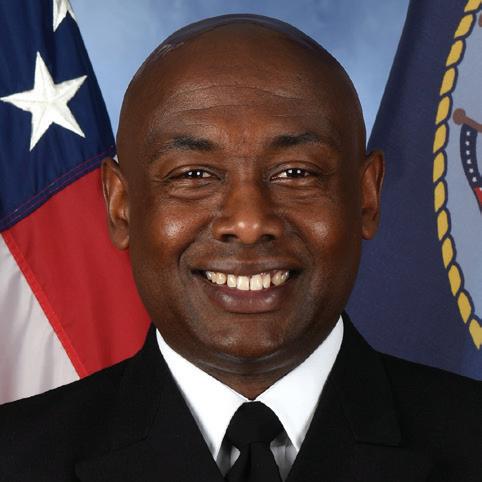
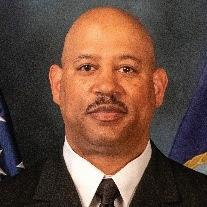
Program in Strategy and Organization at the Stanford Graduate School of Business. His assignments have included USS Scott (DDG 995), USNS San Diego (T-AFS 6), USS Barry (DDG 52), and commanding officer, Explosive

Ordnance Disposal Expeditionary Support Unit ONE; executive assistant to commander, Defense Supply Center Columbus, OH; deputy logistics operations officer, Joint Task Force Civil Support, Fort Monroe, VA; logistics readiness officer, Logistics Current Operations Division, commander, U.S. Pacific Fleet (USPACFLT); director, Supply Corps Detailing; commanding officer, Naval Supply Systems Command Fleet Logistics Center, Sigonella, where the team received the Admiral Stan Arthur Award for Logistics Team of the Year in 2018. Englishserved as the deputy director of supply and distribution, J-44, Joint Staff, Washington, D.C.; and director of Logistics, Fleet Supply, and Ordnance, N-4, USPACFLT.

REAR ADM. KENNETH W. EPPS Commander, Naval Supply Systems Command Weapon Systems Support
Rear Adm. Kenneth Epps is a 1990 graduate of Vanderbilt University and was commissioned through the Reserve Officers Training Corps program. He holds a Master of Business Administration from the University of North Carolina at Chapel Hill and is a recipient of the Frank Hawkins Kenan Award for Excellence. He is a distinguished graduate of the Industrial College of the Armed Forces and earned a Master of Science in national resource strategy. Epps served on USS Kitty Hawk (CV 63), USS Leyte Gulf (CG 55), and USS Carl Vinson (CVN 70) and commanded the Naval Supply Systems Command (NAVSUP) Fleet Logistics Center in Pearl Harbor. Other assignments include instructor and educational counselor, Navy Supply Corps School; aide and flag lieutenant to commander, NAVSUP and chief of Supply Corps; readiness analyst and program objective memorandum development assistant, Office of the Chief of Naval Operations (N-80); action officer, Defense Logistics Agency (J-33); director, Material Budgets, Naval Inventory Control Point—Philadelphia; assistant commander for Financial Management and Comptroller, NAVSUP; chief, Strategy and Readiness Division, Joint Staff (J-4); assistant commander for Supply Operations and Logistics Policy, NAVSUP; assistant professor,
Eisenhower School for National Security and Resource Strategy; and director, Fleet Ordnance and Supply/Fleet Supply Officer (N-41), U.S. Fleet Forces Command.


Rear Adm. Tracy Hines assumed the director’s duties, enterprise networks, and cybersecurity, Office of the Chief of Naval Operations, in May 2022. Hines received her commission through the Limited Duty Officer Program in 1996 and laterally transferred into the Information Warfare community in 2007. She has a business management degree from American InterContinental University and a master’s degree in information technology cyber forensics from Trident University. She has held several operational and ashore assignments, including participation in Operation Enduring Freedom; an individual augmentee tour in Baghdad, Iraq; two executive assistant periods, one to the deputy chief of Naval operations for information warfare and one to the chief of Naval operations; and two commanding officer tours at Naval Computer and Telecommunications Station San Diego and Hopper Information Services in Suitland, MD, respectively. Her qualifications include information warfare officer, surface warfare officer, tactical action officer, officer of the deck underway, conning alongside officer, junior officer of the deck, and surface warfare information center officer. Hines’ awards include the Legion of Merit (3), Bronze Star, Meritorious Service Medal (5), Navy and Marine Corps Commendation Medal (4), and Navy and Marine Corps Achievement Medal (4).
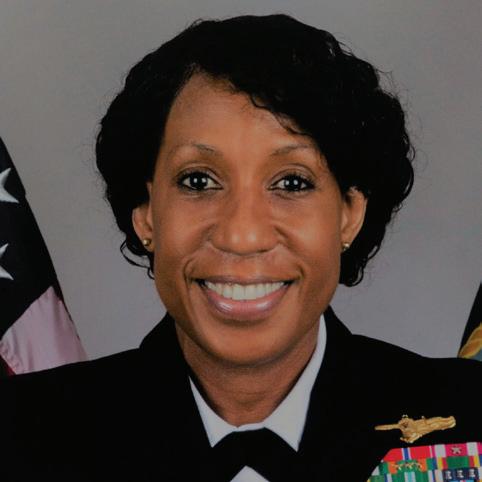
Rear Adm. Alvin Holsey became Navy Personnel Command's commander and deputy naval personnel chief in January 2021. Before his current command, he served as director of Task Force One Navy. Previously, he was commander of Carrier Strike Group One, embarked aboard USS Carl Vinson (CVN 70) from 2018–2020, and served as the inaugural commander of the International Maritime Security Construct/Coalition Task Force Sentinel. In his initial flag officer tour, he served as deputy director for operations
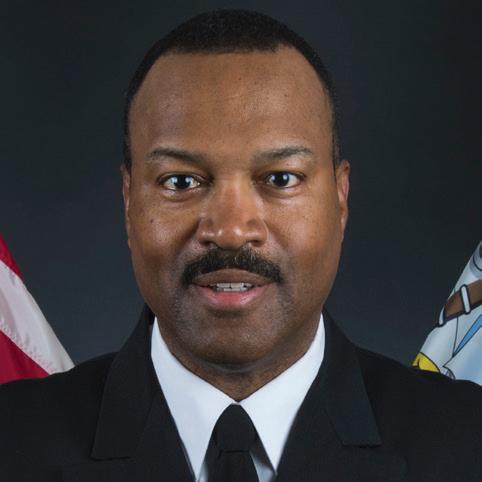
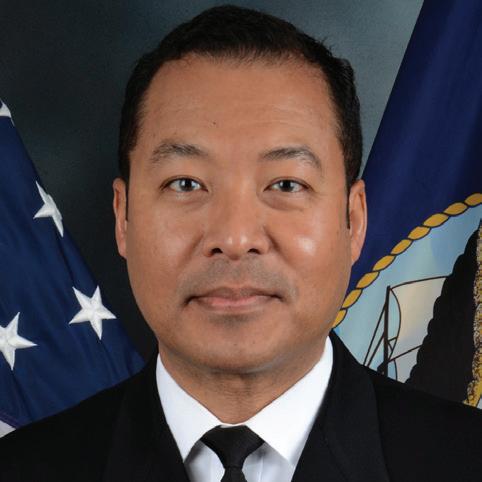
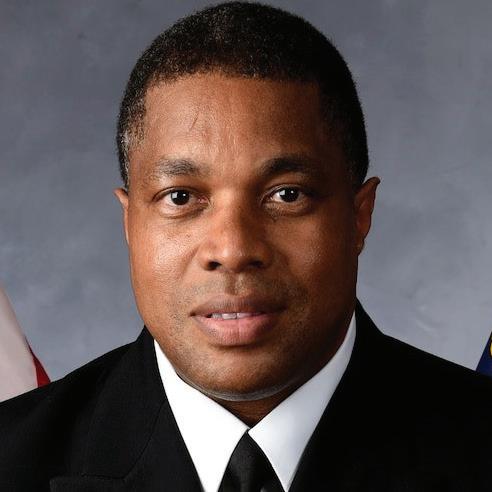
in the U.S. Military


National Military Command Center and Joint Chiefs of Staff. Throughout his career, he has served in various training and operational squadrons and commanded Helicopter Anti-Submarine Squadron Light (HSL-37) and the amphibious assault ship USS Makin Island (LHD 8). His assignments to shore and staff billets have included operations officer on the Joint Chiefs of Staff, J-3, Joint Operations Directorate, European Command, and executive assistant to the chief of Naval operations. Holsey was commissioned through the Naval Reserve Officers Training Corps (NROTC) program at Morehouse College in 1988, receiving a degree in computer science. He earned a Master of Science in management from Troy State University in 1995 and attended the Joint Forces Staff College in 2010.
Rear Adm. Alexis “Lex” Walker took command of the Navy Recruiting Command on March 25, 2022. A native of New York, he began his naval service in 1989 by entering the Broadened Opportunity for Officer Selection and Training (BOOST) Program.
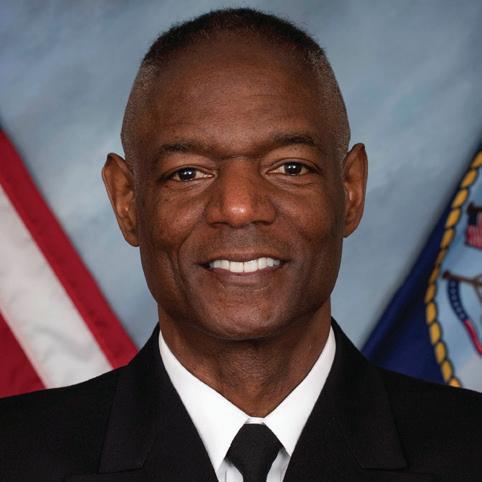
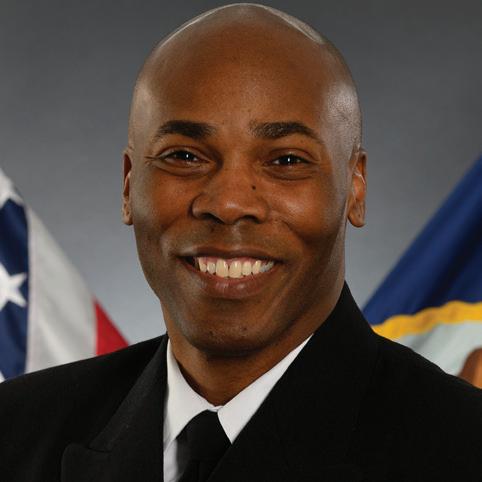
Upon completing BOOST, he attended Jacksonville University, graduated with a Bachelor of Arts, and was commissioned in December 1994. He earned a Master of Arts from George Washington University and a Master of Arts from the U.S. Naval War College. Walker has served various positions at sea aboard USS Robert G. Bradley (FFG 49), USS Hayler (DD 997), USS Cole (DDG 67), and USS Leyte Gulf (CG 55); executive officer of USS Bulkeley (DDG 84); commanding officer of USS Stockdale (DDG 106); and as deputy and commodore of Destroyer Squadron Seven. His shore tours have included Surface Warfare Officers School Command (SWOS); Navy Washington, D.C. intern; post-department head detailer (PERS-411C) at Navy Personnel Command; deputy for congressional affairs at U.S. European Command; warfare integration branch head in OPNAV N91; senior military assistant to the secretary of the Navy; and as deputy chief of legislative affairs at the Navy Office of Legislative Affairs. Walker’s last tour was as commanding officer of Surface Warfare Schools Command.
Rear Adm. Darryl Walker enlisted as an air traffic controller in the U.S. Air Force in 1985. He graduated from Embry-Riddle Aeronautical University, receiving a Bachelor of Science degree in professional aeronautics. He received his commission in the United States Navy through the Aviation Officer Candidate School. Walker
is a graduate of the U.S. Naval War College. His operational tours include the S-3B Viking & EA-6B Prowler, VS-32 deployed onboard USS America (CV 66) and USS Enterprise (CVN 65), and executive officer and subsequent command of VAQ-139 deployed onboard USS Ronald Reagan (CVN 76). Walker also served as the deputy commodore and commodore of the Electronic Attack Wing U.S. Pacific Fleet, flying the EA-18G Growler. His ashore tours include S-3B NATOPS Evaluator at Commander, Sea Control Wing Atlantic; Viking community assignments officer at Commander, Naval Personnel Command; deputy director to PERS-43; NAE diversity director to Commander, Naval Air Forces; Chief of Naval Operations Strategic Studies Group in Newport, RI; the chief of staff to the chief information officer; executive assistant to the vice chairman of the Joint Chiefs of Staff; and executive assistant to the chief of Naval operations.
The United States Navy celebrated its 243rd birthday on October 13. According to the Navy, the theme for 2022 is “Forged by the Sea,” which captures the aspirations of every Sailor’s journey and conveys the notion that every Sailor is strengthened by service in the Navy. It also highlights that the navy has been forged, tempered, and toughened over 243 years of maritime operations. Did you know when the Navy was first formed it had only two armed vessels? Now, there over 490 ships in both active service and the reserve fleet.
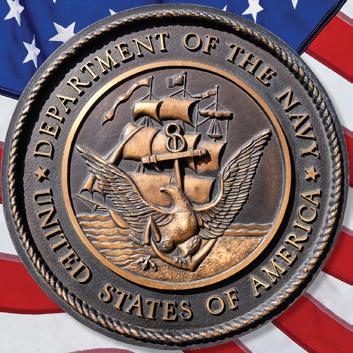



GEN. MICHAEL E. LANGLEY

Commander, U.S. Africa Command Gen. Michael E. Langley, U.S. Marine Corps, became the sixth commander of U.S. Africa Command in August 2022. The command is responsible for all U.S. military operations and activities to protect and advance U.S. national interests in Africa. A native of Shreveport, LA, Langley graduated from the University of Texas at Arlington and was commissioned in 1985. He has commanded at every level from platoon to regiment—including Battery K, 5th Battalion, 11th Marines, in support of Operation Wildfire in the Western U.S.; battalion and regimental commands in 12th Marines forward deployed in Okinawa, Japan; and both the 201st Regional Corps Advisory Command— Central and Regional Support Command—Southwest in support of Operation Enduring Freedom. His command assignments include deputy commanding general II Marine Expeditionary Force and commanding general of 2nd Marine Expeditionary Brigade; commander of Marine Forces Europe and Africa; commanding general of Fleet Marine Force, Atlantic; and commanding general Marine Forces Command and Marine Forces Northern Command. Langley’s staff and joint assignments include serving as a division officer for Marine Corps Institute, Marine Barracks 8th and I; deputy G-1, 1st Marine Division deployed in support of Operation Restore Hope in Somalia; Naval surface fire support requirements officer in the Expeditionary Warfare Division (N-75) and joint integration officer in the Surface Warfare Division (N-76), Office of the Chief of Naval Operations; policy action officer in the Strategic Plans and Policy Directorate, Joint Staff J-5; Iraq desk officer in the Operations Directorate, Joint Staff J-3; deputy executive assistant to the chairman of the Joint Chiefs of Staff; Assessments Branch head, Programs, and Resources, Headquarters, Marine Corps; assistant division commander of 3d Marine Division; deputy director for operations, Joint Staff J-3; assistant deputy commandant for Programs and Resources, Headquarters, Marine Corps; and director for strategy, plans, and policy, J-5, U.S. Central Command.

LT. GEN. BRIAN W. CAVANAUGH Commanding General, Fleet Marine Force, Atlantic Commander, Marine Forces Command

Lt. Gen. Brian Cavanaugh assumed the duties as commanding general of Fleet Marine Force, Atlantic; Marine Forces Command; and Marine Forces Northern Command on Aug. 30, 2022. A native of Baltimore, MD, Cavanaugh earned his commission through the United States Naval Academy in 1990 and was designated a Naval aviator in 1992. He served with HMH-462, HMH-362, and HMX-1. He commanded HMH-362 in Iraq during Operation Iraqi Freedom and MAG-36 during multiple disaster relief efforts in Asia. As a general officer, he served as deputy commander of U.S. Marine Forces Pacific; deputy director for operations, Joint Staff J-3; assistant deputy commandant, programs, Headquarters Marine Corps, Programs and Resources Department; and as commanding general of 1st Marine Aircraft Wing. Cavanaugh’s staff assignments include instructor at Officer Candidates School; aide-de-camp to the chief of Naval operations; Joint Doctrine Branch chief, Joint Staff; executive assistant, vice director Joint Staff; director of the commandant of the Marine Corps Safety Division; and Marine military assistant to the 75th secretary of the Navy. Cavanaugh’s education includes a B.S. in mechanical engineering from the United States Naval Academy, an M.B.A. from Webster University, and a Master of Science in national resource strategy from the National Defense University’s Industrial College of the Armed Forces. He is also an MIT Seminar XXI fellow. Cavanaugh has accumulated over 3,000 flight hours, primarily in the CH-53D/E.
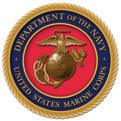
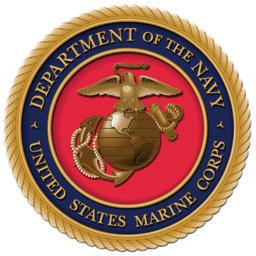
Brig. Gen. Melvin G. Carter serves as director of intelligence, Headquarters Marine Corps. Before his current assignment, Carter served as the intelligence director for the Joint Special Operation Command (2018–2019). His principal command tours include commanding officer, 2d Radio Battalion, and commanding officer, Marine Corps Intelligence Activity. His combat tours include Operation Joint Endeavor with the 26th Marine Expeditionary Unit (Special Operation Capable), Operation Anaconda with the 13th MEU (SOC), Operations Balkan Justice and Restore Freedom with the Joint Special Operations
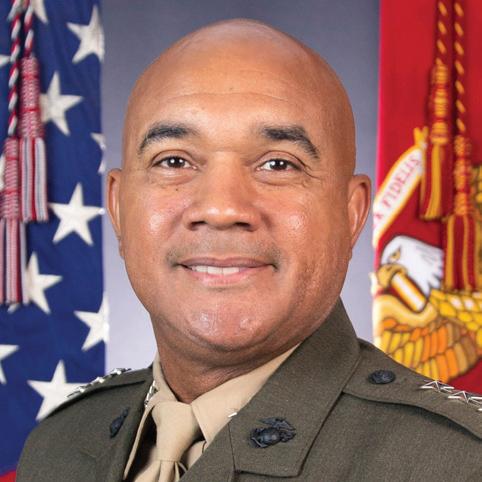
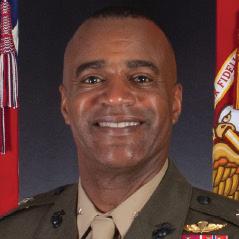
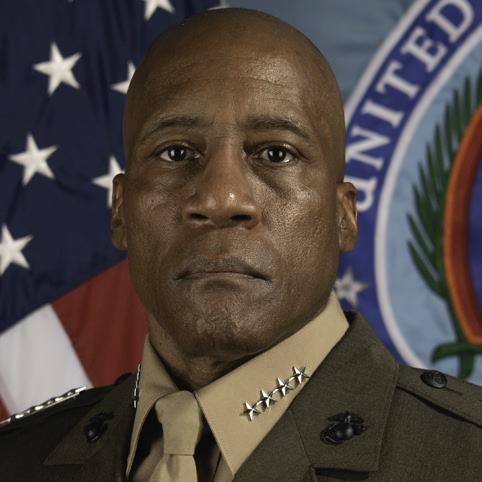
in the U.S. Military


Command, and Operation Iraqi Freedom. Carter also served as the commandant of the Marine Corps National Security Fellow at the John F. Kennedy School of Government, Harvard University, from 2010 to 2011, and the Timothy T. Day Fellow at the Harvard Business School in 2016. He is a distinguished graduate of Morehouse College in Atlanta, GA, receiving his Bachelor of Arts degree in banking and finance. A native of York, PA, Carter enlisted in the Marine Corps in 1985, serving as a radio reconnaissance special exceptional intelligence communicator before earning a commission as a second lieutenant.
Commanding General of Force Headquarters Group
Brig. Gen. Sean N. Day entered the Naval service in 1989 and was assigned to the Academy Preparatory School in Newport, RI. Day was commissioned in 1994 upon graduation from the United States Naval Academy. His command assignments include the 1st and 4th Marine Divisions. His operational and combat deployments include service in Operations Southern Watch, Iraqi Freedom, and Enduring Freedom. Day is a joint qualified officer and an operations and tactics instructor certified by the Marine Corps Tactics and Operations Group. He holds a Bachelor of Science degree from the United States Naval Academy, where he was twice a recipient of the Naval Order of the Prize Award. Day also holds a master’s degree in strategic studies from the United States Army War College. His military awards include the Legion of Merit, Bronze Star, Combat Action Ribbon, Presidential Unit Citation, and other personal, campaign, and service awards. In his civilian career, Day is a business development director for the Next Generation Standards Group of Intel Corporation. He has previously held roles at MBNA Bank, Merrill Lynch, and Nanosys Inc.
BRIG. GEN. ANTHONY M. HENDERSON Deputy Director, Joint Strategic Planning Directorate for Strategy, Plans and Policy (J-5), Joint Staff Brig. Gen. Anthony Henderson graduated from Southern University and A&M College with a degree in history and a Juris Doctorate. An infantry officer, he has deployed worldwide, including Cuba, the Mediterranean, Africa, Asia Pacific, Europe, and the Middle East. Henderson’s
combat experience includes two deployments to Iraq with the 3d Battalion, and 7th Marines, and two tours in Helmand Province, Afghanistan, with Battalion Landing Team 1st Battalion, 6th Marines, and Marine Expeditionary Brigade—Afghanistan.
Henderson has served in several staff tours in the Department of the Navy and Headquarters Marine Corps, including manpower assignments; director of current and future operations, plans, policy, and operations; director of plans and concepts, Marine Corps Warfighting Lab; and strategic advisor and military assistant to the secretary of the Navy. He has also served in the Joint Staff J-3, operations, DDRO, and as special assistant to the chair, Joint Chiefs of Staff.
Henderson served as commanding general 2d Marine Expeditionary Brigade, and deputy commanding general, of II Marine Expeditionary Force. He now serves on the Joint Staff, J-5 Strategy, Plans, and Policy as the deputy director of Joint Strategic Planning.
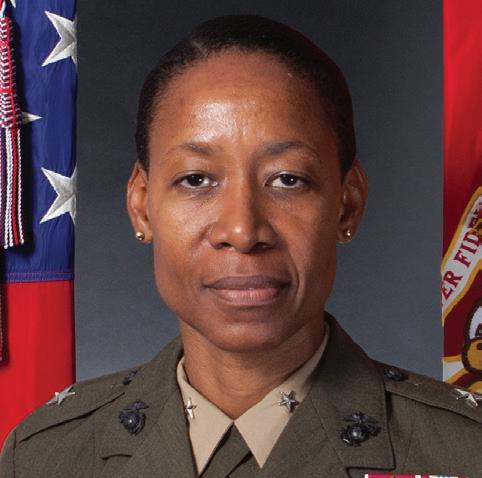
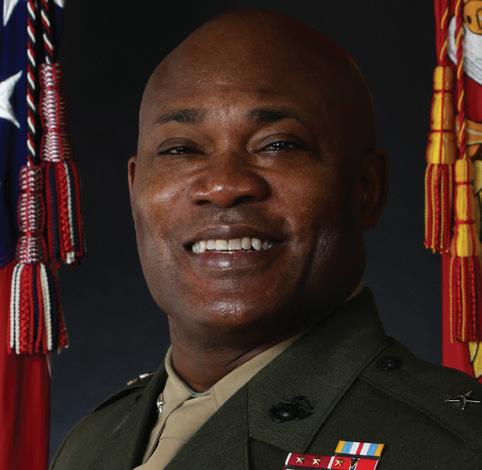
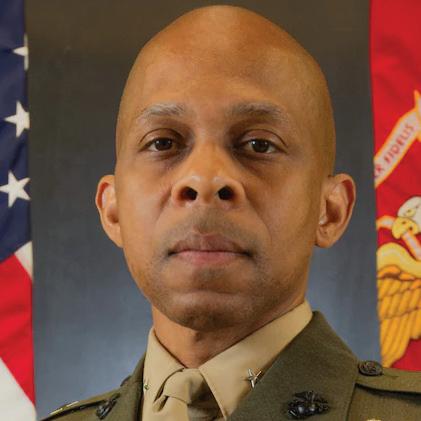
BRIG. GEN. LORNA MAHLOCK
Assistant Deputy Commandant for Information, Director, Command, Control, Communications, and Computers (C-4)
Office of the Chief Information Officer for the Marine Corps


Brig. Gen. Lorna Matlock is the assistant deputy commandant for information, and director of the command, control, communications, and computers (C-4), leading the Office of the Chief Information Officer for the Marine Corps. Before her current assignment, she served as deputy director of Marine Corps Plans, Policy, and Operations and commanding officer of Marine Air Control Group 18, Okinawa, Japan. Born in Kingston, Jamaica, she immigrated to Brooklyn, NY, and enlisted in the Marine Corps. She was selected for the Marine Corps Enlisted Commissioning Education Program, graduated from Marquette University, and was commissioned in 1991.
Designated as an air traffic control officer, she earned certifications as a Federal Aviation Administration (FAA) tower local controller and a Marine aviation weapons and tactics instructor. She has commanded and led at various levels and in combat, including Operation Southern Watch and Iraqi Freedom. She holds a master’s degree in adult and higher education from the University of Oklahoma at Norman; a master’s degree in national security and strategic studies with distinction from the Naval Postgraduate School in Newport, RI; a master’s degree in strategic studies from the U.S. Army War College; and a master’s certificate in information operations from the Naval Postgraduate School. She is also a United Kingdom Defense College Higher Command and Staff graduate.
Brig. Gen. James A. Ryans is currently serving as the assistant division commander for the 1st Marine Division. He enlisted in the Marine Corps in 1988 and was commissioned in 1995. Ryans served as a platoon commander and executive officer at

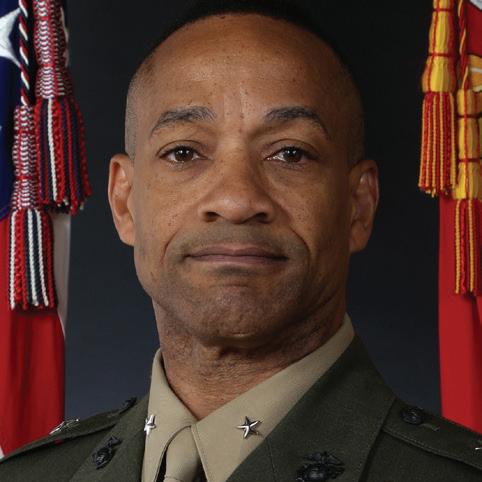
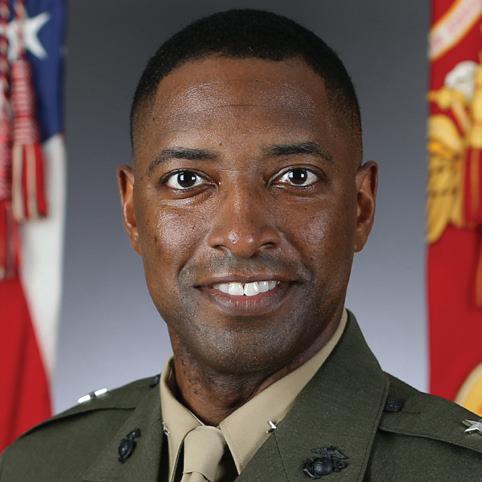
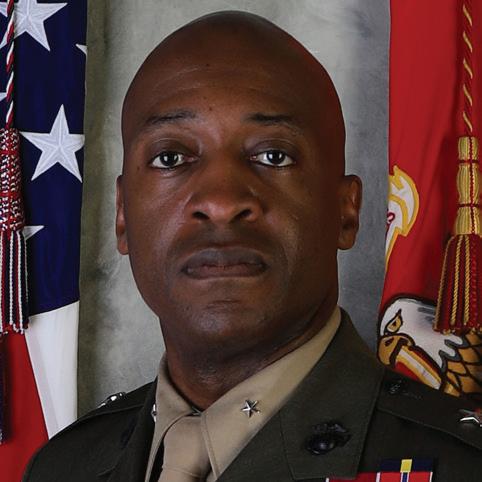
the 1st Battalion, 8th Marines, deploying with the 26th Marine Expeditionary Unit. He also served as Company F’s commanding officer and Headquarters and Service Company in 2d Battalion 8th Marines, deploying to combat in support of Operation Iraqi Freedom with Task Force Tarawa and Afghanistan in support of Operation Enduring Freedom. He commanded 3d Battalion 6th Marines at the battalion level and deployed to Okinawa, Japan, to support the Unit Deployment Program. Ryans was the Headquarters Battalion's commanding officer and 8th Marine Regiment. He became deputy commander of Task Force Southwest, deploying in support of Operation Freedom’s Sentinel and the Resolute Support Mission in Afghanistan. Ryans began his academic pursuits with a Bachelor of Science in physics from Jacksonville University in 1995. He recently added a military fellowship at the Council on Foreign Relations in New York (2021).

Brig. Gen. Ahmed Williamson is the director of the Manpower Plans & Policy, Headquarters Marine Corps. Williamson is a native of Upper Marlboro, MD. He attended the U.S. Naval Academy; upon graduation and commissioning in May 1994, he was assigned to serve as a communications and information systems officer. Williamson has commanded communications units at the platoon, company, and battalion level and has performed with Marine Division, Marine Expeditionary Force, and Joint Special Operations units, deploying in support of operations in Iraq and Afghanistan several times. Williamson’s supporting establishment positions include a myriad of assignments in training and education, including service as a company officer and Naval leadership/Naval science instructor at the Naval Academy (2000–2002) and as the commanding officer of the Marine Corps Officer Candidates School in Quantico (2017–2019). His experience on higher echelon
and Joint duty staff included an assignment with U.S. Special Operations Command (2009–2011) and positions in the Pentagon with the Joint Staff J-6 Communications Directorate, followed by an assignment with the Headquarters Marine Corps C-4 Department. Before his current appointment, Williamson served as the military assistant to the assistant commandant of the Marine Corps (ACMC).
BRIG. GEN. CALVERT L.
Assistant Division Commander, 2d Marine Division Brig. Gen. Calvert Worth Jr. hails from St. Louis, MO, and is a 1989 graduate of the University of MissouriColumbia. He was commissioned via the U.S. Marine Corps Officer Candidates Course in 1991. He has served in a variety of assignments in the Fleet Marine Forces, including commanding officer of 1st Battalion, 6th Marines; commanding officer of the 6th Marine Regiment and Special Purpose Marine Air Ground Task Force Crisis Response—Africa; commander of Task Force Southwest 20.1 in Afghanistan; and as the assistant division commander of the 2d Marine Division. Worth’s B-billet assignments include duty at The Basic School as an instructor, staff platoon commander, and instructor at the Infantry Officer Course; service as the commanding officer at recruiting station Detroit, MI; and duty as the director of U.S. Marine Corps Enlisted Professional Military Education. Joint service assignments include service as a military assistant to the Department of Defense executive secretary in the Office of the Secretary of Defense; Marine military assistant to the undersecretary of the Navy; Joint Staff J-3, J-35 Regional Operations as the division chief, Joint Operations Division—CENTCOM; and most recently as the director of strategy, policy, and plans (J-5) in U.S. Southern Command.
Did you know that the Marines are divided into four groups? The operating forces that do the actual fighting, the headquarters for leadership, the supporting establishment that provides logistical support, and the Marine Corps Reserve.
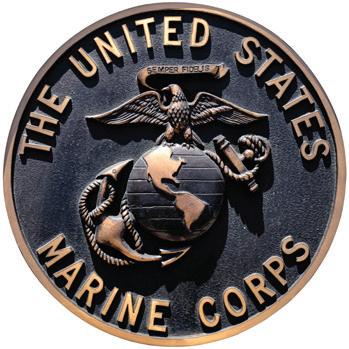



Q.

Rear Adm. Michael Johnston assumed duty as the Coast Guard’s Ninth District commander in 2021. He is the senior commander for the Great Lakes and Saint Lawrence Seaway. This area encompasses a 1,500-mile border and 6,000 Coast Guard active duty, reserve, and civilians in eight states. Johnston previously served as assistant commandant for acquisition and chief acquisition officer (CAO). As CAO, he directed efforts across personnel, finance, contracting, and R&D activities to execute the service’s portfolio. Johnston graduated from the Coast Guard Academy with a Bachelor of Science in electrical engineering. After serving two consecutive tours, he attended the Georgia Institute of Technology to complete a Master of Science in electrical engineering. He then served as project manager and senior network engineer for the Vessel Traffic Systems and Differential Global Positioning System. He served as an aide to the commandant of the Coast Guard for two years. During this time, his work helped restore the nation to normalcy following the 9/11 terrorist attacks. He also helped to transition the Coast Guard into the Department of Homeland Security. Johnston returned to coordinating operations with partner agencies and restructuring a unit into a sector command. Following this assignment, he reported as commanding officer of the Electronics Systems Support Unit in New Orleans, LA, just two months before Hurricane Katrina. He coordinated response, recovery, and repair efforts for all commandand-control systems across the Gulf Coast from Mexico to Florida.
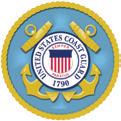
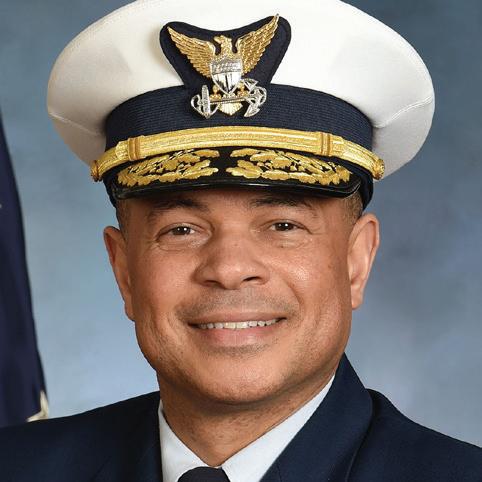
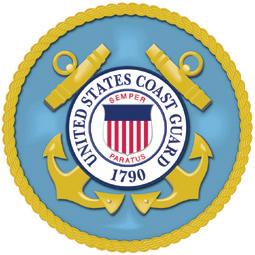
Brown,
is the chief of staff of the Air Force. As chief, he serves as the senior uniformed Air Force
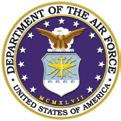
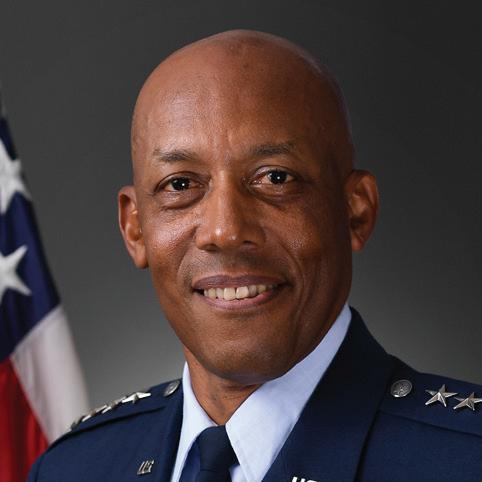
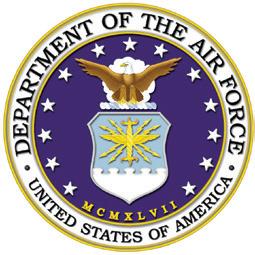

officer responsible for organizing, training, and equipping 689,000 active-duty, Guard, Reserve, and civilian forces serving in the United States and overseas. As a member of the Joint Chiefs of Staff, the general and other service chiefs function as military advisers to the secretary of Defense, the National Security Council, and the president of the United States. Brown was commissioned in 1984 as a distinguished graduate of the Reserve Officers' Training Corps (ROTC) program at Texas Tech University. He has served in various positions at the squadron and wing levels, including an assignment to the U.S. Air Force Weapons School as an F-16 Fighting Falcon instructor. His notable staff tours include aide-de-camp to the chief of staff of the Air Force; director, Secretary of the Air Force and Chief of Staff Executive Action Group; and deputy commander of U.S. Central Command. He also served as a national defense fellow at the Institute for Defense Analyses in Alexandria, VA. Brown has commanded a fighter squadron, the U.S. Air Force Weapons School, two fighter wings, and U.S. Air Forces Central Command. Before serving as the Air Force chief of staff, Brown was the commander of the Pacific Air Forces and air component commander for the U.S. IndoPacific Command. Brown is a command pilot with more than 2,900 flying hours, including 130 combat hours.

GEN. ANTHONY J. COTTON Commander, United States Strategic Command Commander, Air Forces Strategic—Air, U.S. Strategic Command Gen. Anthony J. Cotton is the commander of Air Force Global Strike Command and commander of Air Forces Strategic—Air, U.S. Strategic Command (AFGSC), Barksdale Air Force Base, LA. AFGSC provides strategic deterrence, global strike capability, and combat support to U.S. Strategic Command and other geographic combatant commands. The command comprises more than 33,700 professionals operating at two numbered air forces; 11 active-duty, Air National Guard, and Air Force Reserve wings; and the Joint Global Strike Operations Center. Weapon systems assigned to AFGSC include all U.S. Air Force intercontinental ballistic missiles and bomber aircraft, UH-1N helicopters, E-4B National Airborne Operations Center aircraft, and the U.S. Air Force NC3 weapons system. Cotton entered the Air Force through the ROTC program in 1986 after earning a bachelor’s degree in political science from North Carolina State University. He has commanded at the squadron, group, and wing levels. He served as deputy director of the secretary and chief of staff of the Air Force Executive Action Group, as senior military assistant to the undersecretary of defense for intelligence, as deputy director of the National Reconnaissance Office, and as commander and president of Air University. He was also the vice commander and commander of the 341st Missile Wing; Malmstrom Air Force Base, MT; the commander of the 45th Space Wing, and the director of the Eastern Range, Patrick Air Force Base, FL. Before his current assignment, Cotton served as the deputy commander AFGSC and deputy commander of Air Force Strategic— Air, United States Strategic Command, Barksdale, LA.
LT. GEN. RICHARD M. CLARK Superintendent, U.S. Air Force Academy
Lt. Gen. Richard Clark is superintendent of the U.S. Air Force Academy, Colorado Springs, CO. He directs a four-year regimen of military training, academics, and athletic and character development programs leading to a Bachelor of Science degree and a commission as a second lieutenant in the United States Air Force and the United States Space Force. Clark graduated from the U.S. Air Force Academy in 1986. His commands include the 34th Bomb Squadron, Ellsworth
Air Force Base, SD; 12th Flying Training Wing, Randolph Air Force Base, TX; Eighth Air Force, Barksdale Air Force Base, LA; and joint functional component commander for global strike, Offutt Air Force Base, NE. He has also served as a White House fellow in Washington, D.C.; the commandant of Cadets, U.S. Air Force Academy; senior defense official/defense attaché, Cairo, Egypt; and as the commander, Third Air Force, Ramstein Air Base, Germany. Before his current assignment, Clark served as the deputy chief of staff for strategic deterrence and nuclear integration at Headquarters U.S. Air Force, the Pentagon, Arlington, VA.
LT. GEN. STACEY T. HAWKINS Commander, Air Force Sustainment Center Air Force Materiel Command
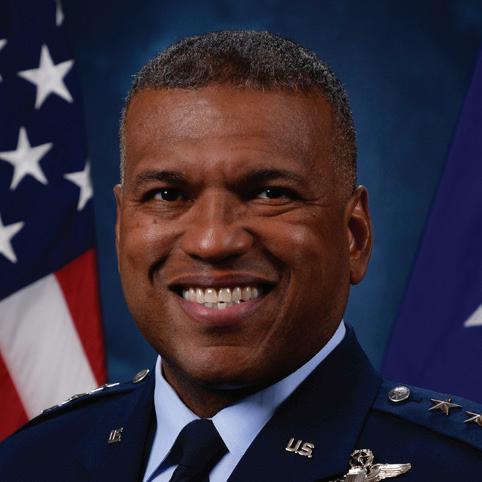
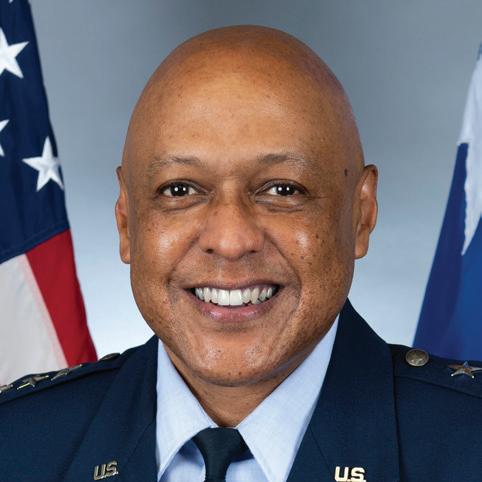
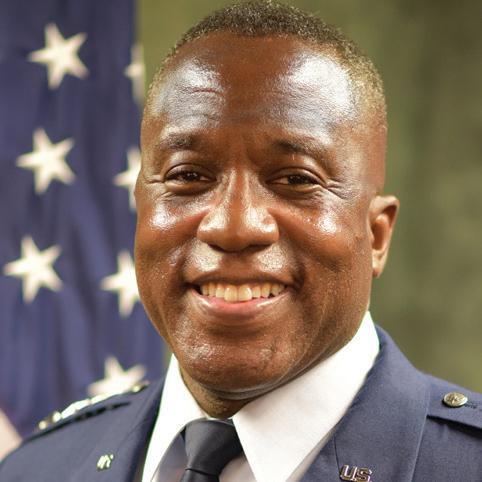
Lt. Gen. Stacey Hawkins is the Air Force Sustainment Center (AFSC) commander, Air Force Materiel Command, Tinker Air Force Base, OK. AFSC is a global organization composed of more than 40,000 Total Force airmen. The center delivers end-to-end life cycle sustainment and logistics for aircraft, missiles, propulsion systems, aerospace commodities, and weapons system software to preserve Department of Defense warfighting readiness. AFSC also manages and executes the Air Force supply chain; delivers modern software solutions through agile and development, security, and operations methodologies; provides comprehensive installation management; and projects expeditionary capabilities to the Joint Force, the nuclear enterprise, interagency operations, U.S. allies, and coalition partners. The Art of the Possible mission culture underpins how AFSC optimizes its world-class people, facilities worth $27.2 billion across three installations, and a $26.8 billion spare parts inventory to generate $16.6 billion in annual revenue from maintenance and supply chain operations. Hawkins is a native of Bastrop, LA, and was commissioned from the U.S. Air Force Academy in 1991. Previously, he led operational logistics in various assignments, including warfighting theaters across southwest Asia, the Horn of Africa, and the Korean Peninsula. He also commanded a squadron, expeditionary maintenance group, air base wing, and air logistics complex.
LT. GEN. RANDALL REED

Deputy Commander, Air Mobility Command


Lt. Gen. Randall Reed is deputy Air Mobility Command, Scott Air Force Base, IL. The command serves as the U.S. Transportation Command air component with a fleet of 1,100 aircraft operating from more than 100 locations worldwide to project, maneuver, and sustain the Joint Force, allies, and partners. Subordinate commands include the 18th Air Force, the U.S. Air

 by Anna Volkwine
by Anna Volkwine
WASHINGTON – In August 2021, the U.S. Army’s xTech Program launched a unique event — the Historically Black Colleges and Universities and Minority Serving Institutions Faculty Competition — to identify and fund a diverse group of innovators who are historically underrepresented in the S&T community to plant their seeds of innovation across the Army science and technology landscape.
Led by the Office of the Assistant Secretary of the Army for Acquisition, Logistics and Technology, xTechHBCU Faculty was the first competition in the program’s history to target and fund research from this diverse group of innovators from the S&T talent pool. More than 80 HBCU and MSI faculty members shared their research with the Army for future application and to potentially earn cash prizes to continue their projects.
In January 2022, xTech named three winners of the HBCU Faculty competition: Howard University-Pritchett Lab, Jackson State University and University of Texas at San Antonio. The winning teams had never worked with the Army prior to xTechHBCU, and the program was influential in getting their research off the ground for future Army application.
The xTech program launched a second HBCU competition in fall 2022, this time

for undergraduate students who want to solve Army problems, receive entrepreneurship training through the Accelerator program and explore potential defense career paths. Students submitted research proposals on climate change technology, health technology or artificial intelligence and machine learning, demonstrating how their research goes hand-in-hand with Army mission priorities.
Finalists were selected from the initial round of submissions, and participated in an 8-week Accelerator program. Final pitches and winner announcement will take place at the xTech booth during the 2023 BEYA STEM Conference, 9-11 February 2023.
xTech connects the Department of Defense with eligible businesses and organizations with the intent to understand the spectrum of worldclass technologies being developed commercially that may benefit DOD programs, integrate commercial innovators into the DOD science and technology ecosystem, and provide mentorship and expertise to accelerate, mature and transition technologies of interest to the government.
The xTech program holds several competitions per year, from open-topic competitions such as xTechSearch, to technology-specific competitions targeting specific Army needs and challenges. For all competition information, go to https:// www.xtechsearch.army.mil/.
The Office of the Assistant Secretary of the Army for Acquisition, Logistics and Technology provides the American Soldier with a decisive advantage in any mission by developing, acquiring, fielding and sustaining the world’s finest equipment and services, and by leveraging technologies and capabilities to meet current and future Army needs. For more information, go to https://www.army.mil/asaalt/.
The innovation lifecycle begins when a creative idea is planted as a seed and given the right resources to help it grow.
in the U.S. Military



Force Expeditionary Center, the 618th Air Operations Center, 17 wings, and two groups. Approximately 107,000 active-duty Air National Guard, Air Force Reserve Airmen, and civilians provide global command and control, inter-theater and intra-theater airlift, air refueling, aeromedical evacuation, and air mobility support, as well as residential and senior leader air transport in support of national interests. Reed graduated from the U.S. Air Force Academy in 1989. He commanded numbered air force wing, two expeditionary operations groups, and a flying training squadron. Additionally, he held various joint, headquarters, and base-level positions, including assignments in strategic airlift, special operations air refueling, and coordinated logistics spanning Operation Desert Storm to Operation Allies Refuge. He also served as the senior defense official and defense attaché Ankara, Turkey. He is a U.S. Army Light Fighter Air Assault School graduate and a command pilot with more than 3,500 hours in the C-141B, KC-135R/T, B-1B, RC135V/W, E-8C, C-130, C-5A, and C-5M aircraft.
LT. GEN. BRIAN S. ROBINSON
Air Education and Training Command Commander Joint Base San Antonio-Randolph, Texas

Lt. Gen. Brian Robinson is the Air Education and Training Command commander at Joint Base San Antonio-Randolph, TX. He is responsible for the recruitment, training, and education of Air and Space Force personnel. His command includes Air Force Recruiting Service and Air University. The command operates more than 1,400 trainers, fighters, and mobility aircraft, 24 wings, and 11 installations. It trains more than 293,000 students annually with approximately 60,000 active-duty, Reserve, Guard, civilian, and contractor personnel. Before assuming his current role, Robinson served as deputy commander Air Mobility Command, responsible for U.S. Transportation Command’s air component, executing the air mobility mission in support of the Joint Force, allies, and partners with a fleet of 1,100 aircraft. Robinson has held staff assignments at Joint Staff, Headquarters Air Force Staff, Air Mobility Command, and the U.S. Air Forces Central 609th Combined Air Operations Center. He has commanded at the squadron, wing, operational, and global 618th AOC levels. Robinson earned his Bachelor of Science degree in computer science from Philadelphia University in 1987. He received his commission from Air
Force Office Training School in 1987.
MAJ. GEN. TROY E. DUNN
Commander, Air Force Personnel Center Joint Base San Antonio-Randolph, Texas.
Maj. Gen. Troy E. Dunn is the commander of the Air Force Personnel Center (AFPC), Joint Base San AntonioRandolph, TX. AFPC provides commanders worldwide with skilled airmen and guardians to conduct Air Force and Joint missions.
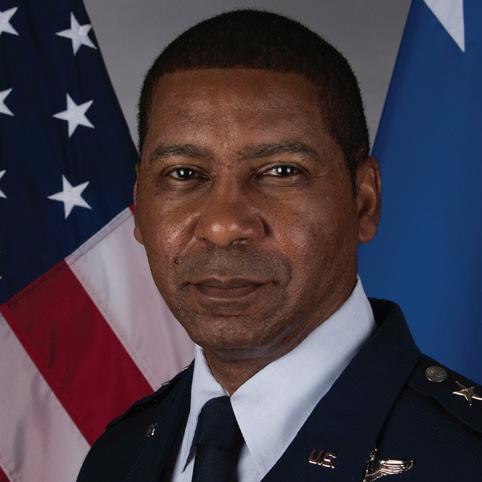
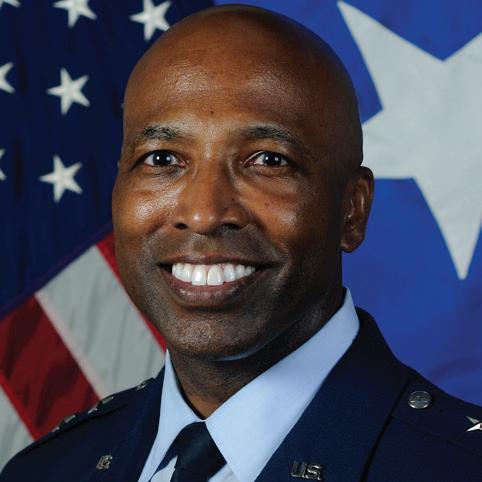
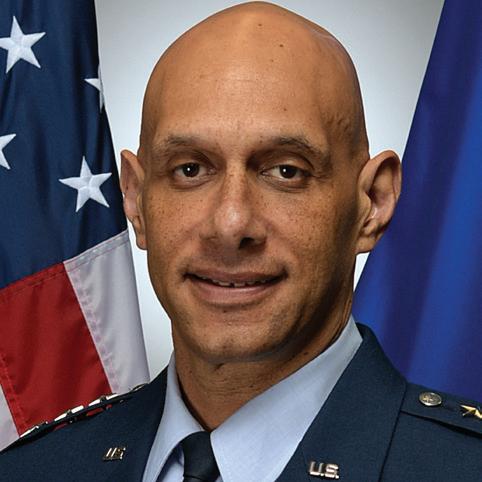
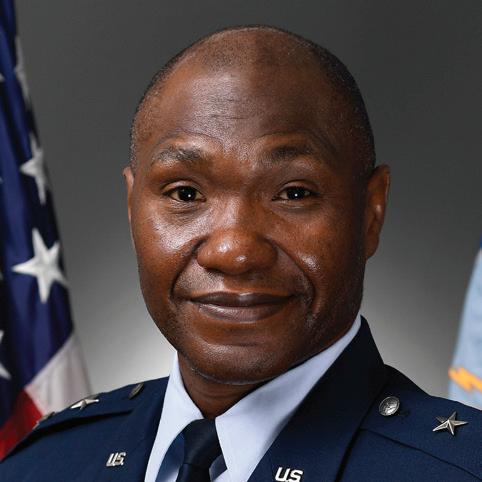
Additionally, AFPC executes programs covering the entire life cycle of military and civilian personnel for the Department of the Air Force, from accession through retirement, including readiness, growth, development, and deployment. AFPC’s diverse workforce of approximately 2,200 military members, civilians, and contractors is responsible for worldwide operations for 2.3 million total force airmen, guardians, retirees, and family members. Dunn was commissioned from the U.S. Air Force Academy in 1993 with a degree in political science. He has held several leadership, staff, and command positions at the base, major command, Air Staff, and Joint Staff levels. Dunn served as an aidede-camp to the U.S. Transportation Command and Air Mobility Command Command's Commanders. He was selected as a Congressional fellow in the Office of Sen. Trent Lott and a distinguished national security team member in the Office of the U.S. Senate Minority Whip. His command tours include squadron, group, and the air base wing at the U.S Air Force Academy.
MAJ. GEN. RODNEY D. LEWIS Deputy Director for Force Protection, J-8 Joint Chiefs of Staff, Headquarters U.S. Air Force Maj. Gen. Rodney Lewis is deputy director for force protection, J-8, Joint Chiefs of Staff, Headquarters U.S. Air Force, the Pentagon, Arlington, VA. Lewis leads three Force Protection divisions, including the Joint Integrated Air and Missile Defense Organization, responsible for the advocacy and integration of joint integrated air and missile defense (IAMD) capabilities; the Force Protection Division, which identifies and develops standard requirements for asset and personnel protection; and the Joint Requirements Office for Chemical, Biological, Radiological, and Nuclear Defense, Chairman’s Controlled Activity. Lewis also serves as the chair of the Functional Capabilities Board. He earned his
commission in 1991 upon graduation from the U.S. Air Force Academy. He was selected as the General John Hester Award winner for displaying the highest degree of loyalty, integrity, and courage in his graduating class. Before his current position, Lewis served as the director for strategy, posture, and assessments and deputy chief of staff for strategy, integration, and requirements at Headquarters Air Force, the Pentagon, Arlington, VA. He is also systems acquisitions certified Level II in program management, testing, and evaluation. He is certified in systems acquisition Level I in planning, research, development, and engineering.
MAJ. GEN. ADRIAN L. SPAIN Chief of Staff, Headquarters U.S. European Command Maj. Gen. Adrian L. Spain is the chief of staff, Headquarters U.S. European Command, Patch Barracks, Stuttgart, Germany. He exercises day-today supervision of the staff, is responsible for management of all matters involving USEUCOM daily operations, and provides counsel and advice to the commander, deputy commander, and civilian deputy on all matters affecting the command. Maj. Gen. Spain also conducts regular coordination with and between the Office of the Secretary of Defense staff, Joint Staff, other combatant commands, component commands, and the USEUCOM staff. Spain entered the Air Force in 1994 through the ROTC program, graduating from Villanova University with a bachelor’s degree in electrical engineering. He is a command pilot with more than 2,300 hours in multiple aircraft, primarily with the F-15C and F-22. He is a 2001 U.S. Air Force Weapons School graduate and F-15C flying award winner. As weapons officer for the 58th Fighter Squadron, he led the nation’s first Operation Noble Eagle deployment to the National Capital Region and the first missions under wartime rules of engagement while deployed for Operation Iraqi Freedom in 2003. He would later serve as an instructor at the U.S. Air Force Weapons School in the 433rd Weapons Squadron. Spain has served as commandant of the U.S. Air Force Weapons School, building the next generation of Air Force leaders and tactical experts across 18 squadrons, six significant commands, and all Air Force warfighting disciplines.
BRIG. GEN. TERRENCE ADAMS
Director, Cyberspace Operations and Warfighter Communications, Office of the Deputy Chief of Staff for Intelligence, Surveillance, Reconnaissance, and Cyber Effects Operations



Brig. Gen. Terrence Adams is the director, cyberspace operations and warfighter communications, office of the deputy chief of staff for Intelligence, Surveillance,
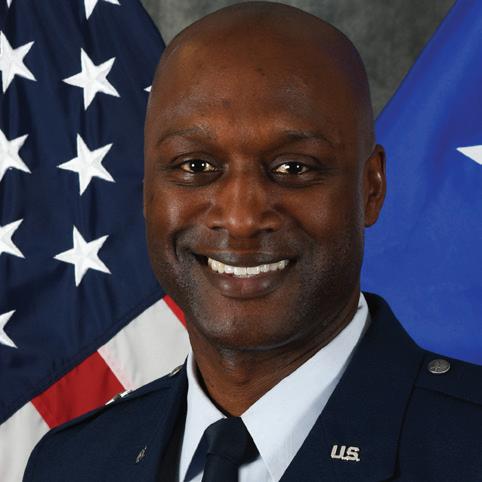
Reconnaissance, and Cyber Effects Operations, Headquarters U.S. Air Force, the Pentagon, Arlington, Virginia. As director, he is responsible for integrating cyberspace warfare capabilities into the joint fight through strategic vision, policy, guidance, and resource advocacy. Adams was born in Tuskegee, Alabama, and enlisted in the Army as a private (E-1) after high school. After serving in the Army for six years, he entered the Air Force through the Reserve Officer Training Corps at Alabama State University - Detachment 019 after graduating from Auburn University in Montgomery, Alabama. He commanded six times at the squadron, group, and wing levels, three of these commands while deployed. Most recently, he served as commander 628th Air Base Wing Joint Base Charleston, South Carolina. Adams deployed to Seeb Air Base, Oman; Kirkuk AB, Iraq; Ali AB, Iraq; and Al Udeid AB, Qatar, in support of operations Southern Watch, Iraq Freedom, Enduring Freedom, New Dawn, and Combined Joint Task Force Horn of Africa. He has held a variety of positions at squadron, group, wing, major command, air staff and joint levels.
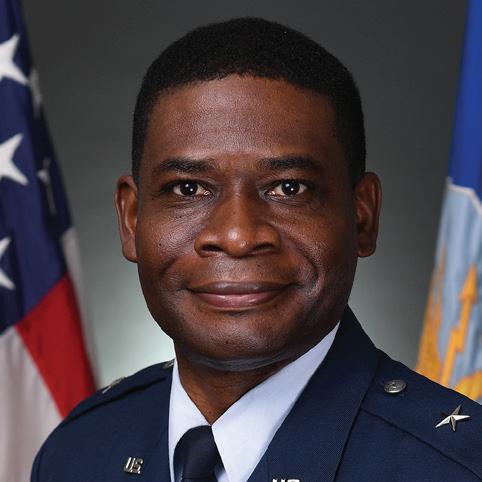
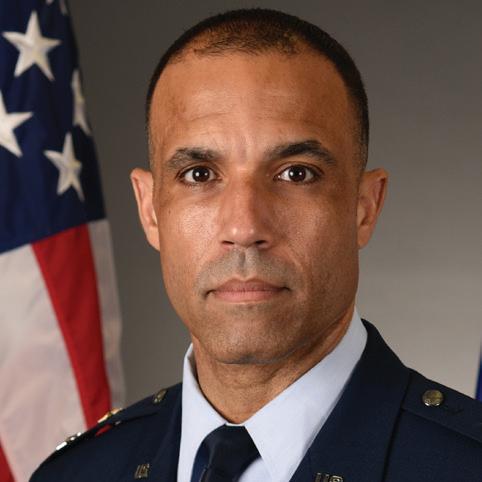
BRIG. GEN. KENYON K. BELL Director of Logistics and Engineering, Headquarters Air Force Global Strike Command Brig. Gen. Kenyon Bell is the director of logistics and engineering at Headquarters Air Force Global Strike Command, Barksdale Air Force Base, LA. He leads more than 350 professionals across nine divisions. He integrates strategy, policy, resources, performance management, and capital development meant in support of the more than 12,800 maintenance, munitions, supply, transportation, and civil engineering personnel who serve the command. He is responsible for integration, advocacy, and oversight of the nation’s largest nuclear weapon storage facility; its Minuteman III intercontinental ballistic missiles; nuclear command, control, and communication weapons systems; B-1, B-2, and B-52 bombers, while also performing lead command functions for the Air Force’s UH-1N helicopter fleet, the E-4B National Airborne Operations Center aircraft. Bell provides combatant commanders with combat-ready forces and equipment to conduct strategic nuclear deterrence and global strike operations. Bell was born in Columbia, SC, and received his commission from the U.S. Air Force Academy in 1995. He has commanded units stateside and overseas

at the squadron, group, and wing levels. Bell has served in multiple staff positions, including assignments at Headquarters Air Force and The Chairman’s Joint Staff, as well as aide-de-camp to the commander, U.S. Forces Japan, and 5th Air Force.

BRIG. GEN. ROY W. COLLINS
Director, Security Forces, Deputy Chief of Staff, Logistics, Engineering, and Force Protection Headquarters U.S. Air Force

Brig. Gen. Roy Collins is director of security forces and deputy chief of staff for Logistics, Engineering, and Force Protection, at Headquarters U.S. Air Force, Arlington, VA. He is the focal point for ensuring the physical security of Air Force nuclear assets and planning and programming for more than 38,000 active-duty and reserve component security forces at locations worldwide. He provides policy and oversight for protecting Air Force resources from terrorism, criminal acts, sabotage, and acts of war. He also ensures that security forces are trained, equipped, and ready to support contingency and exercise plans. Collins joined the Air Force in May 1995 as a United States Air Force Academy graduate. He served on the Air Mobility Command staff as chief of the Antiterrorism and Force Protection Branch and the Air Combat Command’s director, Commander’s Action Group. He has commanded the 95th Security Force Squadron at Edwards Air Force Base, CA, and the 341st Missile Security Forces Squadron at Malmstrom Air Force Base, MT, and then served as the deputy commander for the 341st Security Forces Group, Malmstrom Air Force Base. Collins commanded the 5th Mission Support Group, Minot Air Force Base, ND, and the 37th Training Wing, Joint Base San AntonioLackland, TX.
BRIG. GEN. GAIL E. CRAWFORD Director of the Operations and International Law Domain Air Force Judge Advocate General’s Corps Department of the Air Force, Joint Base Andrews, Maryland

Brig. Gen. Gail Crawford is director of the Operations and International Law Domain, Air Force Judge Advocate General’s Corps, Department of the Air Force, Joint Base Andrews, MD. In that capacity, Crawford oversees the provision of legal services to the Air Force and Space Force on


air and international law, space law, cyberspace and information law, environmental law and litigation, and aviation and admiralty tort matters. She leads a team of 100 judge advocates, civilian attorneys, and paralegals at 15 locations. Crawford received a direct appointment as an Air Force judge advocate in January 1997 after serving eight years of active duty enlisted. She has deployed in support of operations Iraqi Freedom and Enduring Freedom. She has served as a civil litigation attorney, a defense counsel, and a staff judge advocate at the wing, center, and primary command levels. Crawford is admitted to practice law before the Supreme Court of Florida, the United States Court of Appeals for the Armed Forces, and the United States Supreme Court.
BRIG. GEN. ALFRED K. FLOWERS, JR. Director, Manpower, Personnel and Resources and Chief of the Medical Service Corps, Office of the Air Force Surgeon General
Brig. Gen. Alfred Flowers, Jr. is director of manpower, personnel, and resources, and chief of the Medical Service Corps, Office of the Air Force Surgeon General. He advises the Air Force surgeon general on planning, programming, budgeting, and
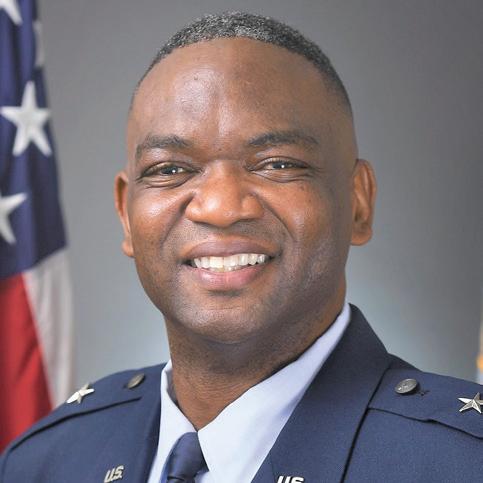
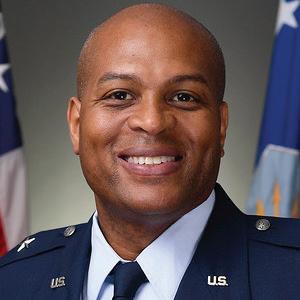
executing a $42 billion Defense Health Program portfolio and a $6.1 billion annual budget supporting 2.6 million patients and 76 military treatment facilities. He is also responsible for personnel policy, force development, and staffing requirements for more than 40,000 activeduty officers, enlisted and civilian personnel, and all Air Force medical education and training worldwide. As the Medical Service Corps chief, Flowers is the senior healthcare administrator in the Air Force. He is responsible for developing and managing 1,800 activeduty, Guard, and Reserve healthcare administration professionals in the corps. Flowers received a direct commission into the Medical Service Corps and graduated from Commissioned Officer Training School in 1997. He has served in various aide-de-camp, fellowship, and command positions at the squadron, center, field operating agency, and headquarters level, including the Office of the Secretary of Defense and NATO. He is board-certified by the American Academy of Medical Administrators and is a member of the American College of Healthcare Executives.
BRIG. GEN. OTIS C. JONES
Commander, 86th Airlift Wing, and Installation Commander Ramstein Air Base, Germany
Brig. Gen. Otis Jones is the commander of the 86th Airlift Wing (AW) and the installation commander of Ramstein Air Base, Germany. As the installation host, the 86th AW supports the headquarters for U.S. Air Forces in Europe—Air Forces Africa, Third Air Force, two tenant
wings, and more than 120 mission partners to include the integration and caring for the greater Kaiserslautern Military Community and its 56,000 U.S. service members and their families. As the 86th AW commander, he led a wing composed of seven groups and 30 squadrons across four bases in Germany, Spain, Belgium, and Portugal. The 86th AW’s mission is to build airmen, project power, and support partners. The wing conducts the United States Air Forces in Europe—Air Forces Africa’s only airlift, airdrop, and aeromedical evacuation flying operations, providing rapid mobility and expeditionary combat support for military operations. Jones has served as a flight examiner and instructor aircraft commander in the C-130E Hercules and C-17A Globemaster III. He has flown combat sorties supporting worldwide missions. As vice superintendent of the U.S. Air Force Academy, he served as the superintendent's chief operations officer and executive advisor. He was the principal coordinating agent for all command matters.
Chief of Staff, Headquarters Pacific Air Forces Joint Base Pearl Harbor-Hickam, Hawaii
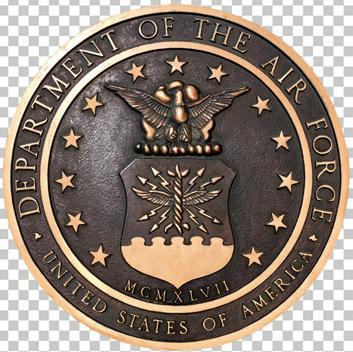




Brig. Gen. Brandon Parker is Headquarters Pacific Air Forces chief of staff, Joint Base Pearl Harbor-Hickam, HI. He develops plans, policies, and procedures to ensure the efficient operation of the Headquarters PACAF staff and the seamless interface with subordinate commands and agencies. Parker is a 1996 graduate of the U.S. Air Force Academy. Before becoming chief of staff, he deployed with the Combined Joint Task Force—Operation Inherent Resolve, Union III Iraq. Parker commanded the 7th Bomb Wing, Dyess Air Force Base, TX, and served as vice commander of the Bomb Wing, Barksdale Air Force Base, LA. He oversaw the 23rd Bomb Squadron, Minot Air Force Base, ND. His staff assignments include the Air Force Colonels Management director and a joint planning officer at Headquarters U.S. Strategic Command, Plans and Policy Directorate. Parker also deployed in support of Operations Enduring Freedom and Iraqi Freedom. He graduated from the U.S. Air Force Weapons School of Advanced Air and Space Studies, Air Command and Staff College, and served as a national defense fellow at Harvard’s Kennedy School of Government. Parker is a command pilot with more than 2,800 hours in bomber aircraft and more than 380 combat hours.
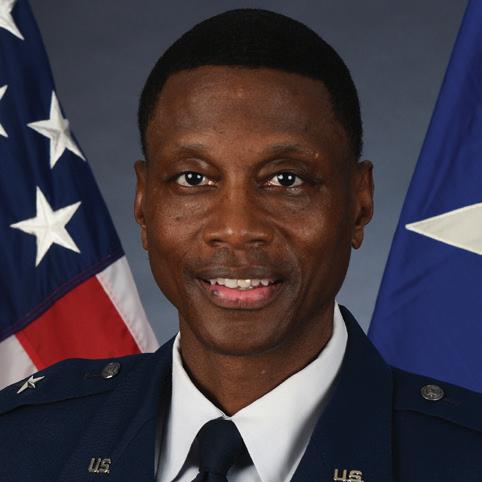

Do you know the specialized programs designed to help you become an officer?
1. The Airman Scholarship and Commissioning Program helps enlisted Airmen attend college with a $15,000 scholarship.
2. Scholarships for Outstanding Airmen enable commanders to select outstanding enlisted Airmen to attend college with a $15,000 scholarship.
3. The One-Year Professional Officer Course-Early Release Program offers active-duty Airmen who can complete bachelor’s degree requirements within one year an opportunity to become full-time students to complete that degree.
4. The Professional Officer CourseEarly Release Program offers activeduty Airmen who can complete bachelor’s degree requirements within two years an opportunity to become full-time students to complete that degree.
5. Enlisted Airmen can also apply to attend Officer Training School. To be eligible, Airmen must have a baccalaureate degree or be a senior at a college or university accredited by one of the six regional accreditation commissions recognized by the U.S. Department of Education.

in the U.S. Military



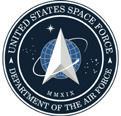
MAJ. GEN. DAVID N. MILLER, JR. Director of Operations, Training and Force Development (J3/7), Headquarters United States Space Command
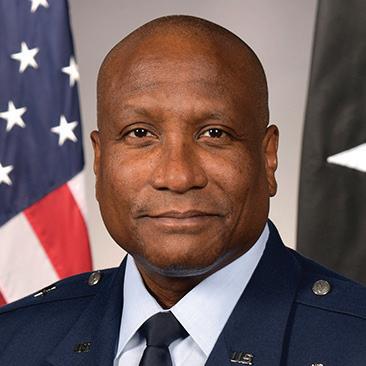
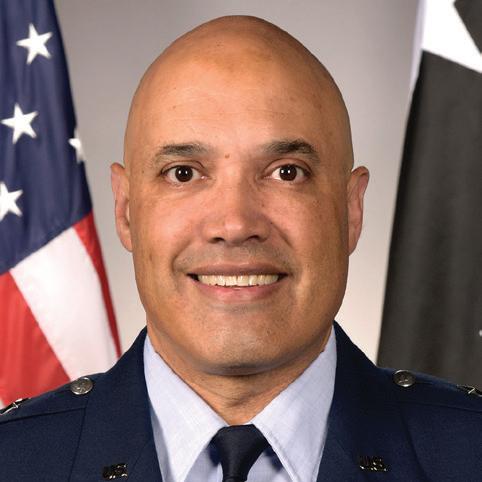
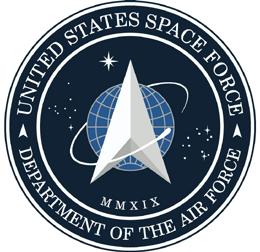
Maj. Gen. David Miller is director of operations, training, and force development (J-3/7), at Headquarters United States Space Command, Schriever Space Force Base, CO. U.S. Space Command is one of 11 unified commands under the Department of Defense. It is responsible for deterring conflict, defending the U.S. and allied freedom of action in the space area of operations, delivering combatrelevant space capability to the joint/combined force, and developing space forces to advance U.S. and allied interests in, through, and from the space domain. As the J-3/7, he is responsible for executing full-spectrum space operations, maintaining credible space deterrence capabilities, providing analytical planning support, the combatant command’s participation in joint and combined exercises, and education, training, and assessments of assigned and attached space forces. Miller was commissioned in 1993 and is a graduate of Lafayette College in Easton, PA. He has operational experience across space power disciplines and has held various operational leadership and staff positions. During his career, Miller has commanded airmen and guardians at the squadron, group, and wing levels, including the 2nd Range Operations Squadron, Vandenberg Air Force Base, CA; the 21st Operations Group, Peterson Air Force Base, CO; and the 460th Space Wing, Buckley Air Force Base, CO.
Brig. Gen. Devin R. Pepper is the deputy director of the Strategy, Plans, and Policy Directorate, United States Space Command, Peterson Space Force Base, CO. In this position, he is responsible for developing military strategies, issuing strategic guidance, planning military campaigns and contingency operations, and formulating policy supporting the combatant commander’s responsibilities outlined in the Unified Command Plan. Pepper enlisted in the USAF in 1989 and received his commission through the Officer Training School in 1996. He is a career space and missile operations officer. He has commanded the Air Force Element Operations Squadron at Royal Air Force Menwith Hill, United Kingdom; deputy commander and commander, 21st Operations Group; the 460th Space Wing; and the Buckley Garrison. Pepper’s staff assignments include Headquarters U.S. Space Command, U.S. Strategic Command; Air Force Global Strike Command; Air Combat Command; Eighth Air Force; and Seventh Air Force. He also served in the Pentagon as an Air Force strategic policy intern in the Office of the Assistant Secretary of the Air Force for Equal Opportunity and the Office of the Deputy Secretary of Defense. Pepper deployed in support of Operation Iraqi Freedom and is a United States Air Force Weapons School graduate.
The Adjutant General for the State of Nevada Maj. Gen. Ondra L. Berry serves as the adjutant general for the State of Nevada. He is the senior uniformed Nevada National Guard officer responsible for formulating, developing, and coordinating all policies, programs, and plans affecting
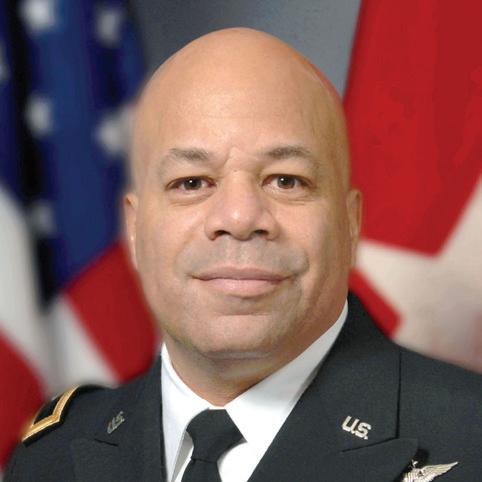
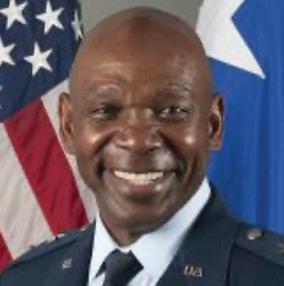
more than 4,700 Nevada Army and Air National Guard personnel. Appointed by the governor of the State of Nevada, Berry is the principal advisor on all National Guard issues, responsible for both the federal and state missions of the Nevada National Guard, and serves as the official channel of communication with the National Guard Bureau, Department of the Army, Department of the Air Force, Nevada Division of Emergency Management and State Partnership Program.
Before his current position, Berry was the assistant adjutant general—air, Nevada National Guard and served as the sssistant to the director of National Guard Bureau A-1, service component level personnel director for over 107,000 ANG members. He manages component Headquarters, Numbered Air Force, and Major Command level support in formulating and coordinating policy and executing manpower, personnel, services, and training programs. This includes force management, formal training allocation, database and systems administration, modification and analysis, services, manpower and organization, policy formulation, and implementation. Berry received his commission from the Air National Guard Academy of Military Science in 1990.
Commander, 167th Theater Sustainment Command

Maj. Gen. Sylvester Cannon has served as commander 167th Theater Sustainment Command since October 2020. He graduated from the University of Alabama with a bachelor’s degree in accounting and later earned an M.B.A. from Troy University. His military education includes a master’s degree in strategic studies from the United States Army War College. Professional qualifications include the Military Police Officer Basic Course, Military Police Officer Advanced Course, United States Army War College, Maneuver Enhance Brigade Pre-Command Course, Dual Status Commander Course (NORTHCOM), Harvard University, General and Flag Officer Homeland Security Executive Seminar, and Interim Guard Senior Leader Training (IGSLT). Previous assignments include assistant adjutant general, commander, 135th Sustainment Command, Birmingham, AL; commander, 135th Sustainment Command, Birmingham, AL; assistant adjutant general, Joint Force Headquarters, Montgomery, AL; command safety officer, Joint Force Headquarters, Montgomery, AL; brigade commander, 226th Maneuver Enhancement Brigade, Mobile, AL; division mobility chief, 135th Expeditionary Sustainment Command, Birmingham, AL; mobility officer, 135th Expeditionary Sustainment Command, Birmingham, AL; and comptroller, 167th Theater Sustainment Command, Anniston, AL. His civilian occupation is senior manager at the Alabama Department of Revenue, Montgomery, AL.
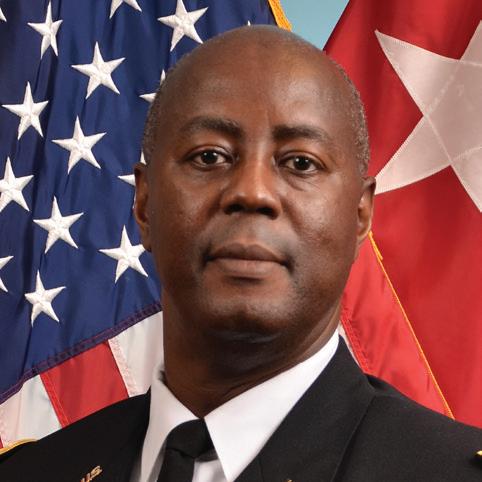
MAJ. GEN. JOHN C. HARRIS, JR. The Adjutant

Maj. Gen. John Harris is the adjutant general Ohio National Guard, Joint Force Headquarters, Columbus, OH. Harris assumed these duties on Jan. 14, 2019. Appointed by the governor of Ohio, Harris serves as the governor’s principal adviser on all National Guard procedures and is responsible for federal and state missions. The Ohio National Guard consists of the Ohio Army National Guard, Ohio Air National Guard, Ohio Military Reserve, and Ohio Naval Militia, totaling more than 16,000 personnel. Harris began his military career in 1981 when he enlisted in the Ohio Army National Guard. He received a commission in 1984 through Officer Candidate School. He has commanded at the platoon,

in the U.S. Military

detachment, company, squadron, and Joint Force Headquarters levels. His recent assignments include assistant adjutant general—Army, chief of staff (Joint Force Headquarters), deputy chief of staff for personnel (Joint Force Headquarters), and commander of Task Force Lancer in Kosovo.


MAJ. GEN. KODJO KNOX
Adjutant General of the Virgin Islands National Guard
Maj. Gen. Kodjo KnoxLimbacker currently serves as the adjutant general of the Virgin Islands National Guard. Knox-Limbacker first enlisted in the Georgian National Guard as an infantry soldier. Upon completing the Army Reserve Officer
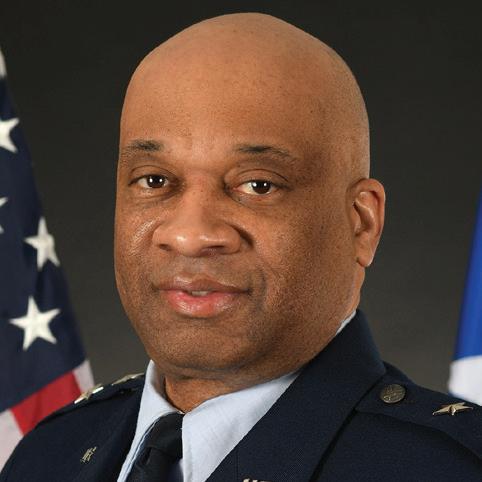
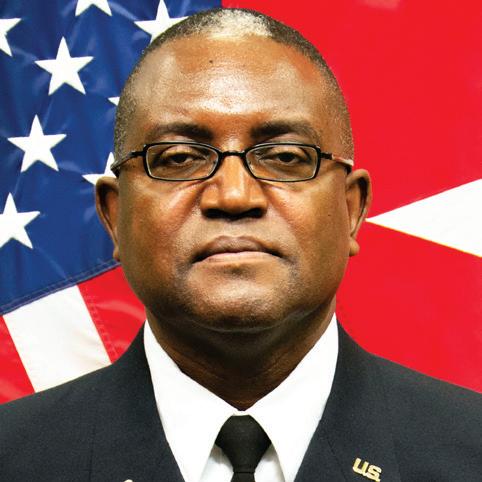
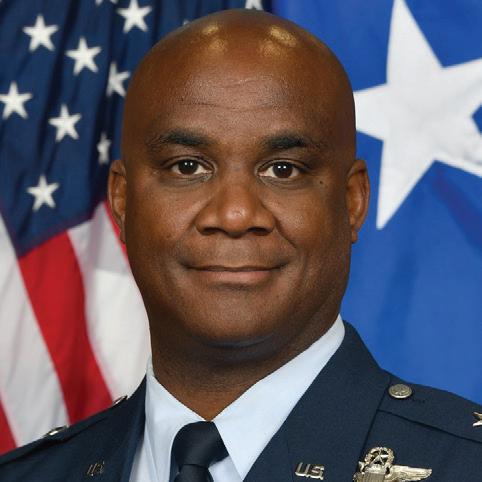
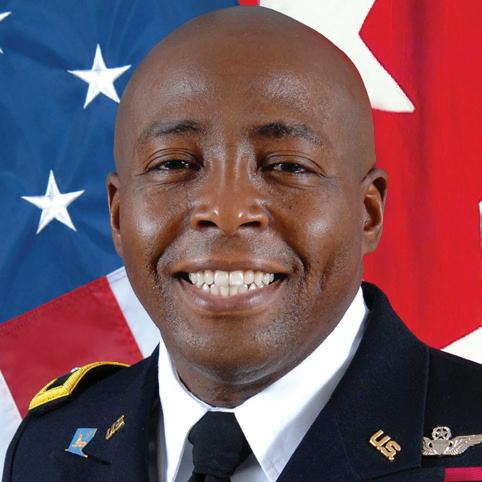
Training Corps program at Augusta State University, he was commissioned as a second lieutenant of Army Aviation in the active-duty Army. He graduated from U.S. Army Flight School as a UH-1 Iroquois pilot in 1996. Later he transferred to Army fixed-wing aviation flying the C-12, RC-7, and U-21, among others. As an Army aviator, Knox-Limbacker has logged over 2,700 flight hours, including tours in Africa, Afghanistan, Bosnia and Herzegovina, Kosovo, and South America. After serving in the Pentagon, Knox-Limbacker was sent on a special assignment to the Virgin Islands. Knox-Limbacker was announced as the next adjutant general of the Virgin Islands by Gov. Albert Bryan on Jan. 15, 2019. Formally assuming the role of adjutant general in May 2019, KnoxLimbacker was unanimously confirmed by the Virgin Islands Legislature on July 12, 2019. Knox-Limbacker was promoted from colonel to brigadier general on Sept. 11, 2019. On July 30, 2020, he received federal recognition for this promotion. In June 2021, Knox-Limbacker was promoted to the Virgin Islands rank of major general.
GEN.
Chief of Staff, Kentucky Air National Guard Deputy Chief of the Joint Staff, Joint Force Headquarters Kentucky National Guard
Maj. Gen. Charles Walker is the chief of staff Kentucky Air National Guard and deputy chief of the Joint Staff, Joint Force Headquarters Kentucky National Guard. He serves as the principal advisor to the adjutant general for coordinating policy, guidance, and direction of the Commonwealth's 8,000 Army and air guardsmen. Walker is dual-hatted as the director of the Office of Complex Investigations, National Guard Bureau. The Directorate is responsible
for conducting administrative investigations into allegations of sexual assault. He is a special advisor to the deputy judge advocate general of the United States Air Force. Walker received his commission as a second lieutenant through the Air Force Reserve Officer Training Corps at Auburn University in December 1990. He served seven years on active duty, primarily in personnel and communications (now cyber) positions, including a joint assignment with the United States Military Entrance Processing Command. He attended law school during his final active-duty assignment and separated in 1998 to pursue a civilian legal career. In 2004, he resumed military service in the Air Force Reserve as a Judge Advocate General’s Corps member. In 2005, Walker joined the Kentucky Air National Guard as a staff judge advocate.
BRIG. GEN. JEFFREY R. ALEXANDER
Chief of Staff of the Michigan Air National Guard
Brig. Gen. Jeffrey Alexander is chief of staff of the Michigan Air National Guard. A 1990 Naval Reserve Officers Training Corps graduate from North Carolina State University, Raleigh, he graduated from Naval flight school at Naval Air Station Corpus Christi, TX, in 1992. Alexander flew multiple fixed-wing and rotary aircraft in the Navy before conducting an inter-service transfer to the Air Force in 1999, after which he flew the E-3 Airborne Warning and Control System at Tinker Air Force Base, OK. In 2003, he transferred to Barksdale Air Force Base, LA, where he was instrumental in establishing an Air Force Cyberspace Air Operations Center and Cyber integration into the Air Force Warfare Center. In 2008, he was transferred to U.S. Strategic Command/Joint Functional Component Command for Global Strike at Offutt Air Force Base, NE. While there, he created operational directives for deterrence and conducted full-spectrum informational global plans. He retired from active duty in 2011 and has since served in the Massachusetts and Michigan Air National Guards.
Brig. Gen. James A. Benson serves as the Joint Staff, Delaware National Guard director. Benson was commissioned into the Delaware National Guard in 1992 as a second lieutenant, Signal officer. In his
more than 30 years of service, he has held several key positions such as commander, 259th Signal Company (Tropo), Delaware National Guard; operations officer/ security team chief and operations officer, J-4 liaison officer, National Guard Bureau, J-3 Joint Operations Center; S-3 action officer, Headquarters and Headquarters Department 198th Integrated Theater Signal Battalion; and before his current assignment, commander, 261st Theater Tactical Signal Brigade. Benson deployed in support of both Operation Iraqi Freedom and Operation Enduring Freedom. Benson earned his bachelor’s degree at the University of Delaware, a master’s degree at Wilmington University, and a master’s degree in strategic studies at the United States Army War College. In addition to his military career, Benson has over 18 years in the civilian sector working with emergency management, most recently as an emergency management consultant with the United States Department of Transportation and the United States Department of Agriculture. He volunteers and mentors students at Woodley Hills Elementary School in his spare time.
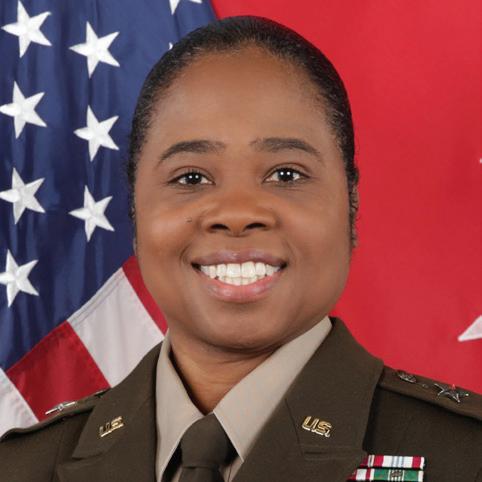



Brig. Gen. Birckhead received her commission as a distinguished military graduate of the Reserve Officers Training Corps (ROTC) at Hampton University. She completed the Chemical Officer Basic Course and served in the U.S. Army Reserves. In 1994, she was appointed to the Maryland Army National Guard. She served as director of legislative liaison for the Maryland National Guard until assuming command of the Maryland Army National Guard in 2018. Birckhead simultaneously commanded the state Guard and Task Force Capital following the attack on the Capitol. Maryland’s governor appointed Birckhead to lead Maryland’s COVID-19 vaccine Equity Task Force in January 2021. She is also the deputy commanding general—Reserves Affairs at the United States Army War College. In her civilian capacity, Birckhead serves as a senior advisor in the Bureau of Trust Funds Administration at the Department of the Interior. Birckhead began her civilian career working in several positions on Capitol Hill. She left to take a job working for the National Guard as the state equal employment opportunity manager. Birckhead was a special agent and special agent in charge of the Defense Security Service before returning to the Office of Personnel Management, followed by the Department of the Interior.
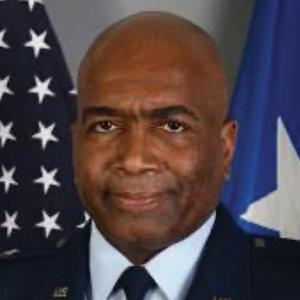
Brig. Gen. Robert Bowie is a special assistant to the director of the Air National Guard for the assistant secretary of Air Force Energy, Installations, and Environment at Headquarters Air Force. He advises a senior executive service fourstar equivalent and four deputy assistant secretaries as a trusted agent, providing a uniform perspective of the reserve component. He serves as an interface for the Air National Guard, ensuring infrastructure communication, basing, environmental, energy, community partnership, and safety policy. Additionally, he interprets the Office of the Secretary of Defense guidance for SAF/IE to support the development of climate policy and action plans for the department of the Air Force. Bowie was commissioned through the Reserve Officers’ Training Corps after graduating from Carnegie Mellon University in 1998. Throughout his career, he has served in various operational and Headquarters Air Force staff assignments as a civil engineer, having served on active duty before entering the Air National Guard. Bowie has commanded at the squadron and group level and as vice wing commander. He has overseen and held leadership roles for three presidential inaugurations serving as the interim director for the District of Columbia Construction and Facilities Management Office and as a senior joint planner supporting the District of Columbia COVID-19 response.
Brig. Gen. Rodney Boyd was appointed as the assistant adjutant general for the Illinois Army National Guard on July 1, 2021. His previous assignment was as the associate chief of staff, J-4 (wartime), United States Forces Korea. He serves as the principal assistant to the adjutant general in all matters of supervision and management of the Illinois Department of Military Affairs and the Illinois Army National Guard, which consists of 10,000 citizen soldiers. Boyd began his military career as a Marine Corps reservist in 1982. After completing his obligation with the Marines, he joined the Illinois Army National Guard. In 1989, Boyd attended the Illinois Army National Guard Officer Candidate
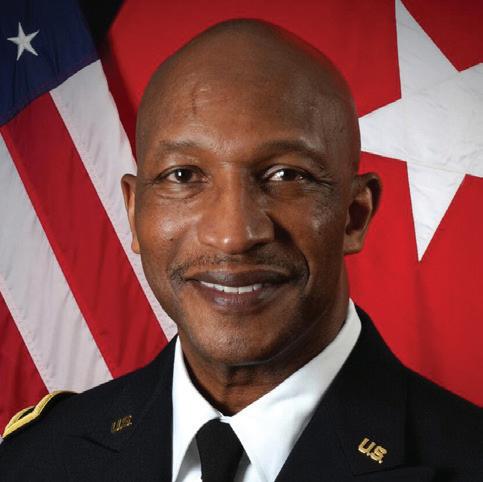
in the U.S. Military


School. Upon completion in 1990, he was commissioned as a second lieutenant in the Quartermaster Corps. Boyd has held many leadership and staff positions during his more than 35 years of service, including commander, Headquarters and Headquarters Company, 405th Brigade Support Benelux; commander, 108th Sustainment Brigade; and J-5, director of strategic plans and policies. Boyd received a bachelor’s degree in criminology from Northern Illinois University, a Master of Arts degree in education from the University of Illinois at Chicago Circle, and a second Master of Arts degree in strategic studies from the U.S. Army War College.
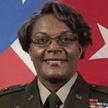
Brig. Gen. Felicia Brokaw has served in an array of positions of increasing responsibility over a career spanning more than 34 years. Brokaw is currently assigned as the assistant chief of staff J-4 (wartime), United States Forces Korea. Her military career began as an enlisted soldier with the 38th Military Police Company for five years. She then received her commission as a second lieutenant in May of 1992 from the Indiana Military Academy Officer Candidate School. Her prior assignments include garrison commander of Atterbury—Muscatatuck Urban Training Center, the deputy United States property and fiscal officer, deputy chief of staff for logistics J-4, surface maintenance manager, installation transportation officer, S-2/S-3 operations officer, telecommunication manager, logistics officer, supply management officer, and commander at all levels up to brigade. Her civilian education includes an associate’s degree in computer programming, a Bachelor of Science in computer technology, a Master of Science in management, and a Master of Arts in strategic studies. Brokaw resides in Indianapolis, IN, with her husband David. They have three adult children—Katie (Brandon) McNeely of Bloomington, IN; Ian, who resides in West Lafayette, IN; and Felice, who’s a senior at Purdue University—and one grandchild, Jordan.
BRIG. GEN. DAVID V. COCHRAN Assistant Adjutant General, Commander West Virginia National Guard
Brig. Gen. David Cochran earned a bachelor’s degree in civil engineering from the Air Force Academy. Since then, he has spent more than 30 years in the military— including over two decades with the West

Virginia National Guard. Cochran balances his service as a drill status guardsman with his civilian job as a pilot for United Airlines. Cochran was commissioned in May 1989 through the U.S. Air Force Academy and graduated a year later from pilot training at Vance Air Force Base, OK. As an active-duty pilot, Cochran was involved in several global missions. His initial active-duty tour with the C-130E and C-130H3 aircraft at Little Rock Air Force Base, AR, involved European, Southwest Asia-Middle East, and Eastern African deployments supporting Desert Calm, Restore Hope, and other contingencies. He had a follow-on assignment to Andrews Air Force Base as a flight commander within a C-21 squadron that entailed duties within the group. Before his promotion to the assistant adjutant general, Cochran served as the director of operations for the West Virginia National Guard. He previously served in the 167th Airlift Wing as deputy commander of both the Operations Group and Maintenance Group and as commander for the 167th Operations Support Flight, 167th Airlift Squadron.
BRIG. GEN. MARLON E. CROOK, SR. Intelligence & Cyber Effects Operations Director Air National Guard Bureau
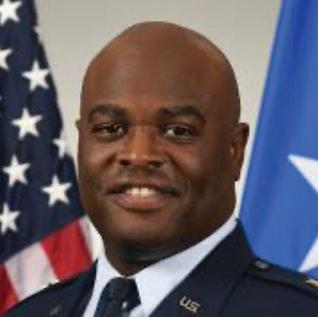
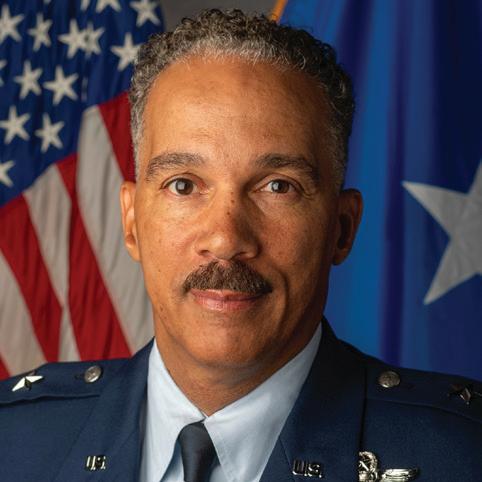
Brig. Gen. Marlon Crook is the intelligence and cyber effects operations director of the Air National Guard (ANG) Bureau A-2/6 Joint Base Andrews. As the director, he oversees a portfolio to include intelligence, cyber forces, and systems architecture, including fixed-base and expeditionary information networks and security supporting and enabling over 108,100 military and civilian personnel assigned to ninety wings and 175 units throughout the 50 states, the District of Columbia, Puerto Rico, Guam, and the Virgin Islands. As the ANG senior intelligence officer and CIO, Crook is responsible for governance and policy implementation. Crook earned his commission in 1993 through the University of Notre Dame Army Reserve Officer Training Corps (ROTC) program. He has commanded at the squadron and group levels. He has significant leadership experience in various Operational, Air Staff, Command, and key Joint Staff assignments. Before his current position, he was the principal deputy director of National Guard Bureau A-2/3/6/10 Operations. He has also served as director of the National Guard Bureau, responsible for the human capital management of over 3,770 federal civil service employees, Army National Guard Title 10 Active Guard Reserve, and Air National Guard Statutory Tour personnel.
BRIG. GEN. AARON R. DEAN II The Adjutant General District of Columbia Army National Guard Brig. Gen. Aaron Dean has received many awards during
his military career. His state awards include the District of Columbia National Guard Distinguished Service Medal, Meritorious Service Medal, Major General Charles Southward Leadership award, and the Army Physical Fitness Badge.
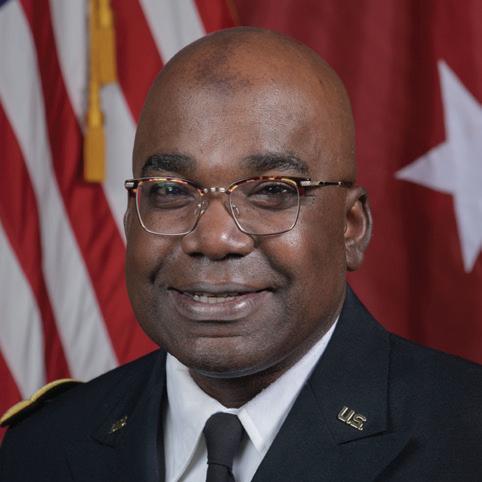
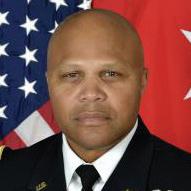
His other awards include the Bronze Star, Meritorious Service Medal with two oak leaf clusters, Joint Service Commendation Medal, Army Commendation Medal with two oak leaf clusters, Army Achievement Medal with one oak leaf cluster, Army Reserve Achievement Medal, National Defense Service Medal with one oak leaf cluster, Southwest Asia Service Medal with bronze star, Iraq Campaign Medal, Global War on Terrorism Medal, Armed Forces Reserve Medal with M Device, Army Service Ribbon, Overseas Service Ribbon with one oak leaf cluster, Reserve Overseas Training Ribbon, Kuwait Liberation Medal and Combat Action Badge. His military education included the Military Police Officer Basic Course, 1987; Military Police Officer Advanced Course, 1994; Combined Armed Services School, 1995; Command General Staff College, 2000; and the National War College, 2008. Dean received an Army ROTC Commission from Washington State University in 1984. Upon commissioning, he we appointed as an air defense section leader.
Brig. Gen. Shawn Harris is the senior defense official assigned to the U.S. Embassy in Tel Aviv, Israel. Before his current position, Harris was the chief of staff, Kosovo Forces (KFOR) principal coordinator, and executive coordinating agent
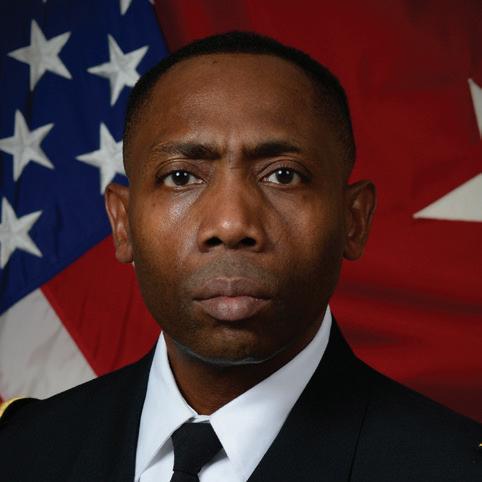
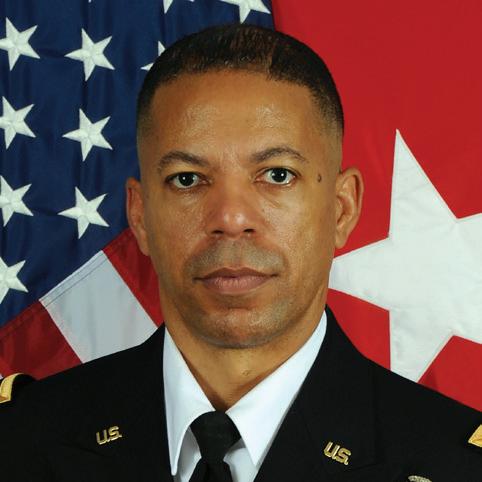

for the KFOR commander. The chief of staff exercises control and supervision of the entire Headquarters staff. He communicates for the commander with other headquarters and directs liaison activities. He supervises and maintains executive control of the headquarters staff in Pristina, Kosovo, with the principal duty being that of running the Headquarters. He liaises with the United Nations Mission in Kosovo (UNMIK), the NATO Headquarters in Tirana, Albania, and The Joint Forces Command in Naples, Italy. As an executive coordinating officer of a large multi-national headquarters with staff drawn from about 28 different nations, the post extends beyond the normal duties of a chief of staff. He maintains situational awareness of all political, social, and economic aspects of the development of Kosovo as a
democratic society. He is in daily contact with staff from the United Nations Mission in Kosovo, the European Union Rule of Law, and the Kosovo Police.
Assistant Adjutant General-Army


Brig. Gen. David Jenkins began his military career as an ROTC cadet at South Carolina State University and received his commission in 1990. Jenkins has served in the South Carolina National Guard for the past 28 years. Jenkins’ latest assignment was chief information officer G/J-6. Jenkins deployed to Afghanistan in 2004 and has supported numerous federal and state missions over the past 15 years, including hurricanes, floods, and other natural disasters. Jenkins holds a Bachelor of Science degree in electrical engineering from S.C. State, a master’s degree in international business (executive M.B.A.) from Xavier University in Cincinnati, OH, and a master’s degree in strategic studies from the Army’s Senior Staff College in Carlisle, VA. Jenkins’ formal military education includes the Signal Officer Basic and Advanced Courses, Combined Arms and Services Staff School, Command and General Staff Officer School, the Advanced Joint Staff College, and the U.S. Army War College. In his civilian career, Jenkins works for Lexmark International as the senior director of strategic operations and technical delivery.
Brig. Gen. Paul L. Minor became the assistant adjutant general—Army, Massachusetts National Guard in June 2022. The career chaplain, who also serves as a copastor at the All Saints’ Church in Belmont, MA, was directly commissioned in 1996 and has served as chaplain for the Headquarters, Camp Edwards Training Site; Headquarters, 1st Battalion, 182nd Infantry Regiment; Headquarters, 26th Infantry Brigade; Headquarters 3rd Battalion, 126th Aviation Regiment; among others, serving most recently as the senior chaplain, Joint Force Headquarters—Massachusetts, Hanscom Air Force Base. Minor served overseas as a chaplain in Camp Buerhring, Kuwait and served two tours in Guantanamo Bay, Cuba. His awards and decorations include the Legion of Merit, Meritorious Service Medal, Joint Service Commendation Medal, and
in the U.S. Military


Army Commendation medal (with one bronze oak leaf cluster). Minor earned his bachelor’s degree at Boston University, master’s degrees at Protestant Episcopal Theological Seminary in Virginia and Northcentral University in Massachusetts, and a master’s degree in strategic studies at the United States Army War College.
BRIG. GEN. LELAND SHEPHERD
Commander, Arkansas Army National Guard
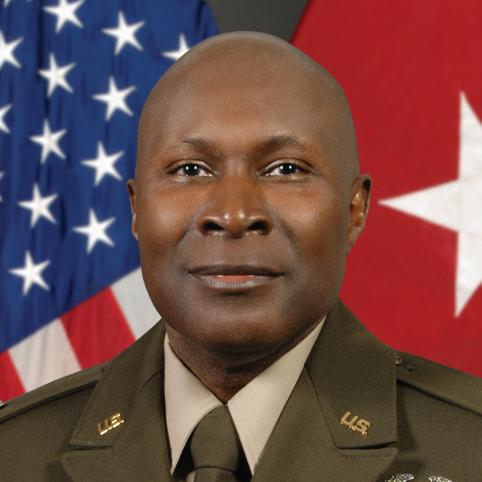

Brig. Gen. Leland Tony Shepherd, the land component commander for the Arkansas Army National Guard, began his military career in the Army Reserves in 1992. In 1997, he enrolled in Officer Candidate School, where he received his commission and was appointed second lieutenant in the Arkansas Army National Guard in August 1998. His leadership positions include two Iraq tours as a Signals officer, battalion executive officer for the brigade special troops battalion, systems chief, and deputy G-6 officer; commander of second and 3rd Battalions, 233rd Regional Training Institute; and commander, 233rd RTI Regiment. His most recent role was deputy chief of staff—G-6. His military awards include the Army Legion of Merit, the Bronze Star, the Combat Action Badge, and the Meritorious Service Medal with two oak leaf clusters. Additionally, Shepherd was awarded the prestigious Order of Mercury, Bronze. He earned his bachelor’s degree in organizational management from Philander Smith College, a master’s degree in information technology management from Webster University, and a master’s degree in strategic studies from the U.S. Army War College. He received his doctorate in executive leadership from the University of Charleston.
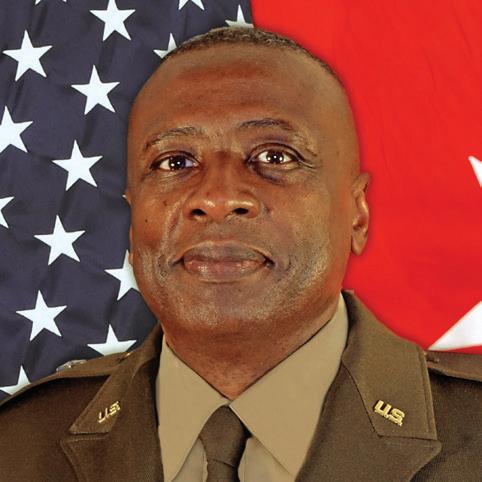
BRIG. GEN. MONIE R.
Deputy Adjutant General—Army at Camp Mabry Brig. Gen. Monie Ulis serves as the deputy adjutant general— Army at Camp Mabry. He assists the adjutant general in exercising command responsibilities and is the principal advisor. The deputy adjutant general also works with the chief of the Joint Staff to prepare the state for emergencies, manmade or natural disasters, and military mobilizations. He enlisted in the Army in 1985 and joined the Texas National Guard in 1989. He was commissioned through the State Officer Candidate School program as an infantry officer in 1992. Ulis received a Bachelor of Arts in liberal arts from the University of the State of
New York, a Master of Science in information technology from Touro University, and a master’s degree in national security strategy from the National War College. Ulis has served in various assignments, including deputy G-1, Army National Guard Readiness Center; commander, 136th Maneuver Enhancement Brigade; and assistant deputy, military personnel policy for the assistant secretary of the Army, Manpower, and Reserve Affairs. Ulis previously served as commander of Operation Lone Star, securing the southwest border. Before his current assignment, Ulis served as director, Joint Staff for the Texas National Guard.
GEN. CHRISTOPHER
Assistant Adjutant General and Commander of the West Virginia Air National Guard
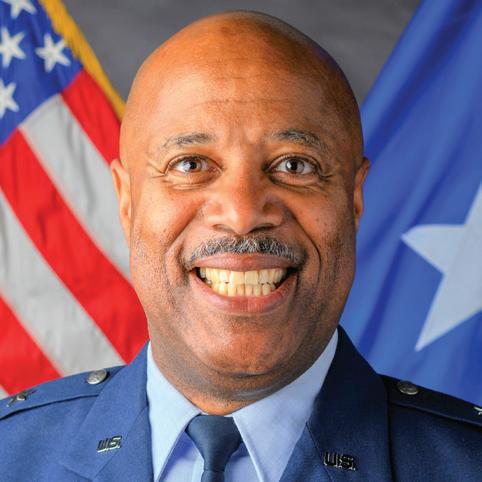
Brig. Gen. Christopher Walker is the assistant adjutant general and West Virginia Air National Guard commander. The West Virginia Air National Guard has over 2,100 members and consists of the 130th Airlift Wing and the 167th Airlift Wing. As the assistant adjutant general—air and commander, Walker provides command and control over all Air National Guard (ANG) forces assigned to the state and is the principal advisor to the adjutant general. Walker began his Air Force career as a 1988 U.S. Air Force Academy graduate. After Undergraduate Navigator Training at Mather Air Force Base in 1989, he served as a C-130 navigator in weather reconnaissance and tactical airlift squadrons, including an assignment as an airdrop planner in the Balkans Combined Air Operations Center and various contingencies. In 1997, Walker left active duty to join the ANG. In 2019, he served as dual-status commander of Joint Task Force— World Scout Jamboree, commanding 1,000 soldiers, airmen, sailors, and DOD civilians, providing security, logistics, and medical assistance to over 45,000 scouts and support staff from over 150 countries. Walker is an expert navigator with over 5,200 hours in WC-130 and C-130E/H/H3 aircraft, including over 400 combat and combat support hours. S






THE SENIOR EXECUTIVE SERVICE (SES) is a corps of men and women who administer public programs at the top levels of the federal government. They serve in key positions just below top presidential appointees, forming a vital link between these appointees and the rest of the workforce. SES members serve in positions that are primarily managerial and supervisory; they operate and oversee government activity in approximately 75 federal agencies. Selection to the SES is based on leadership qualifications and criteria established by the Office of Personal Management, which manages the federal executive personnel system. The SES was established by Title IV of the Civil Service Reform Act of 1978 and went into effect on July 13, 1979.

The Honorable Ronald S. Moultrie was sworn in as under secretary of Defense for Intelligence & Security in June 2021. He exercises authority, direction, and control on behalf of the secretary of Defense over all intelligence and security organizations within the Department of Defense, including the National Security Agency (NSA), the Defense Intelligence Agency, the National GeospatialIntelligence Agency (NGA), National Reconnaissance Office (NRO), the Defense Counterintelligence and Security Agency, and intelligence components of the combatant commands and military services. He also serves as the defense intelligence director in the Office of the Director of National Intelligence (ODNI). Prior, Moultrie’s 36-plus-year career included leadership positions in the national intelligence community (NIC). He retired from the Defense Department in 2015 as director of operations at the NSA. Moultrie’s other roles included serving as a senior Central Intelligence Agency (CIA) senior intelligence service member. He rejoined NSA as a senior executive, remaining until retirement. More recently, Moultrie was a senior advisor to the secretary of the Navy. He led the crafting of a digital roadmap to optimize the department’s focus on cybersecurity, data analytics and infrastructure, and emerging technologies such as AI/ machine learning, 5 and 6G, and quantum computing.
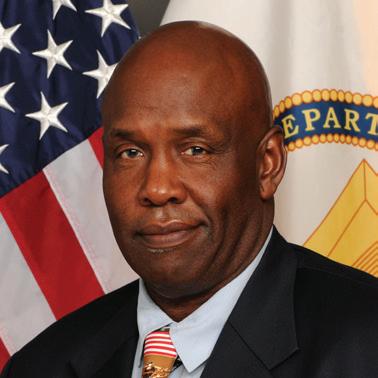
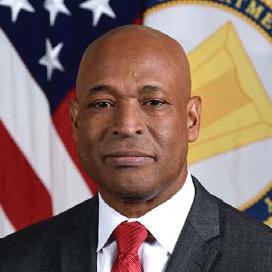
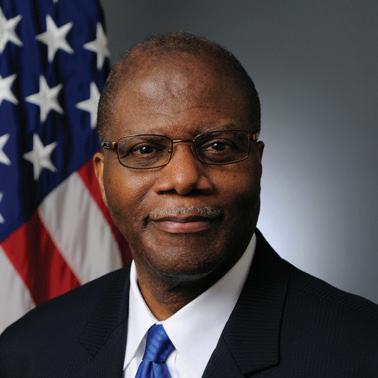
Director of Financial Operations and Accounting (FOA) Office of the Deputy Assistant Secretary of the Army (Financial Operations and Information)
Natasha N. Anderson is currently serving as the director of financial operations and accounting (FOA) with the office of the deputy assistant secretary of the Army (Financial Operations and Information) as of Aug. 15, 2021.
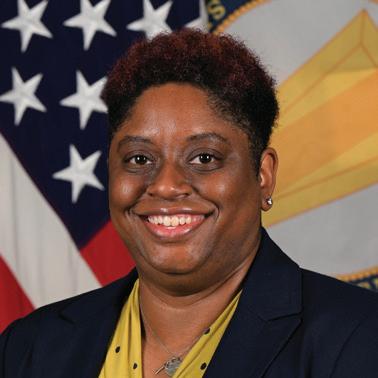
In this role, she is responsible for all ongoing financial management
initiatives for policies, programs, and procedures designed to establish, implement, and maintain Army’s accounting, auditing, risk management, and financial reporting activities. Anderson was previously appointed as the director of general fund audit readiness for FOA in August 2017, where she was responsible for the execution of the Army’s General Fund financial statement audits and corrective action efforts stemming from those audits. Anderson has served as both contractor support and civilian personnel within FOA since January 2011. As a manager with Kearney & Company, Anderson was responsible for establishing and executing Army’s Financial Improvement and Audit Readiness plan as a contractor with FOA before joining the government team as a staff accountant. Anderson joined the federal government as an accountant in June 2004 at the Bureau of Alcohol, Tobacco, Firearms, and Explosives (ATF) after graduating cum laude from McDaniel College.
Deputy Assistant Secretary of the Army (Equity and Inclusion Agency) Office of the Assistant Secretary of the Army (Manpower and Reserve Affairs)
Anselm A. Beach assumed the duties of deputy assistant secretary of the Army— Equity and Inclusion Agency on Nov. 10, 2019.
He serves as the secretary of the Army’s designated proponent for
diversity and inclusion, civil rights, equal employment opportunity, military equal opportunity, career programs, and policy and oversight of Army command programs. Beach directs the daily operation and execution of one of the most comprehensive complaints adjudication process, proactive management, and prevention programs within the federal government. Beach previously served as the acting executive director of the Privacy and Diversity Office, U.S. Customs and Border Protection, Department of Homeland Security. In this Senior Executive Service position, he served as a principal advisor to the commissioner on highly sensitive and complex workforce issues. He led five divisions: Diversity and Equal Employment Opportunity Division, Privacy, Freedom of Information Act Division, Custody Support and Compliance Division, and Mission Support Division, to serve over 60,000 employees.
Director, Operations and Readiness, G-3 U. S. Army Materiel Command (HQ AMC)
Kevin J. Bostick provides mission command over daily operations by integrating global support functions and systems supporting joint warfighters across the spectrum of Army operations. His responsibilities include plans, procedures, readiness, equipping, Army prepositioned stocks, logistics readiness center, field maintenance, depot maintenance, and petroleum. Bostick executes the strategic direction, priorities, policies, and guidance of the Army Materiel Command (AMC) headquarters commanding general, the deputy commanding general, the executive deputy to the commanding general, and G-3 manages, monitors, directs, and coordinates standards-based skill and skill progression training and training programs at Formal Learning Centers and integrates Training Command staff supporting efforts and synchronization of resources.
Chief of the Civil Works Programs Integration Division U.S. Army Corps of Engineers
Selected to the Senior Executive Service in June 2019, Stacey Brown is chief of the Civil

Works Programs Integration Division for the U.S. Army Corps of Engineers. She is responsible for developing, defending, and executing the U.S. Army Corps of Engineers Civil Works Program. This position entails close coordination with senior administration officials, Congressional leaders, and project partners. Initially, she served as chief of the planning and policy division for the U.S. Army Corps of Engineers and as the chief of the Mississippi Valley Division and Southwestern Division Regional Integration Teams. In that position, she was responsible for ensuring that plans and investigations undertaken by the Army Corps of Engineers were properly formulated and responsive to the legislative and executive authorities governing the restoration, conservation, and development of the nation’s water and related land resources.
Brown earned a Bachelor of Science in civil engineering, a Bachelor of Arts in English, and a minor in engineering management from Tufts University.
Yvette K. BourcicotActing Assistant Secretary of the Army Manpower and Reserve Affairs, Washington, D.C.
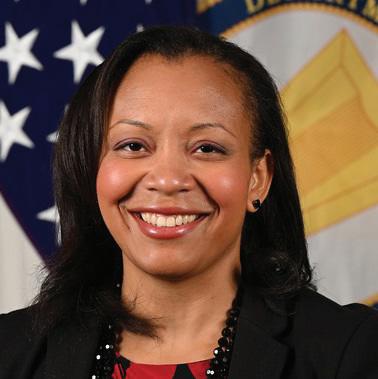
Yvette K. Bourcicot serves as the acting assistant secretary of the Army for manpower and reserve affairs. In this role, she is the principal advisor to the secretary of the Army on all matters related to the Army People Strategy. She manages manpower, personnel, and Reserve Component affairs for the Department of the Army. She advises the Army secretary on policy and oversight of human resources, training, readiness, mobilization, military health affairs, force structure, manpower management, equal opportunity, employment opportunity, marketing, and other critical matters. Bourcicot was an Air Force ROTC scholar at Princeton University. She was also a Dean’s Scholar in Georgetown University’s Funded Legal Education Program. After spending a decade in the Air Force as a career officer, Bourcicot started a law firm
in Washington, D.C. before joining the Office of the Army General Counsel, the chief lawyer for the Army. Over the next decade, Bourcicot held various senior roles in defense policy and legal counsel in the Defense Department. Her corporate functions include policy communications at Facebook, Airbnb, and Match Group, Inc. Her military awards and honors include the Meritorious Service Medal, Air Force Commendation Medal, and Army Commendation Medal.
Chief Military Programs Integration Division, HQUSACE US Army Corps of Engineers
Theodore Brown was appointed to the Senior Executive Service in January 2009. In September 2022, he announced his new position as the chief of military programs in the Integration Division of Headquarters U.S. Army Corps of Engineers. He is responsible for executing worldwide military programs and integrating engineering, construction, real estate, and environmental activities in support of the Department of Defense, federal agencies, and foreign nations. From November 2017 to September 2022, Brown served as the director of regional business, South Atlantic Division, USACE. Before this assignment, he was the planning and policy division chief. He also served as the leader of the Mississippi Valley Division and Southwestern Division Regional Integration Team in Headquarters. Brown has a long and extensive history with the Corps of Engineers. He began his service as a junior fellow in 1983. Over the last three decades, Brown has dedicated his career to the U.S. Army Corps of Engineers and served in various positions throughout his career in the Huntington District, Huntington, WV; Ohio River Division, Cincinnati, OH; Nashville District, Nashville, TN; Headquarters, Washington, D.C.; and now South Atlantic Division, Atlanta, GA.
Deputy Assistant Secretary of the Army (Training, Readiness, and Mobilization)
Eugene Collins has served as the deputy assistant secretary of the Army for training readiness and mobilization since 2019. He supports the assistant secretary of the

Army for manpower and reserve affairs by formulating plans, programs, policies, and general practices for the Army’s all-volunteer force, both active and reserve components. He exercises secretariat oversight, direction, and organization of training, readiness, and mobilization across the Army. In conjunction with the Army staff, he develops, implements, and reviews all policies and programs of mobilization, demobilization, and accessibility of the Reserve Component’s readiness resourcing and reporting; training institutions and support; training aids and devices; individual and unit training; and professional leadership education and development. He also serves as the advisor to the Army Reserve Forces Policy Committee, a general officer advisory group to the secretary of the Army, to integrate its recommendations into the planning efforts of the Department of the Army staff. Collins entered the Senior Executive Service in 2007 and is a 26-year Air Force veteran, retiring as a colonel and a Bronze Star combatproven aircraft maintenance and logistics leader.
Albert Curry, Jr. Deputy, Materiel Readiness U.S. Coast Guard Headquarters
Eugene Collins has served as the deputy assistant secretary of the Army for training readiness and mobilization since 2019.
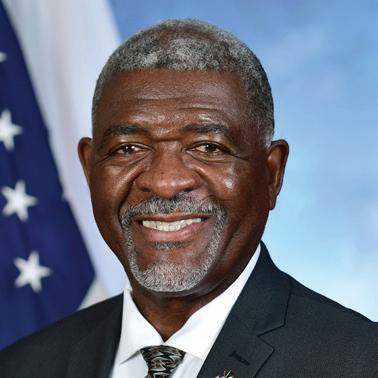
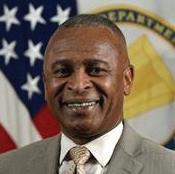
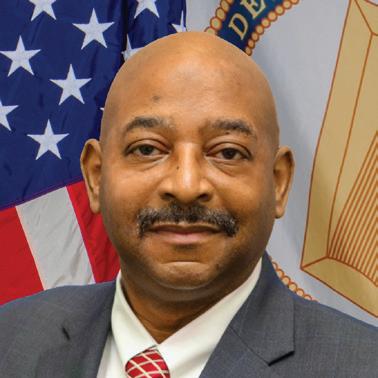
He supports the assistant secretary of the Army for manpower and reserve affairs by formulating plans, programs, policies, and general practices for the Army’s all-volunteer force, both active and reserve components. He exercises secretariat oversight, direction, and organization of training, readiness, and mobilization across the Army. In conjunction with the Army staff, he
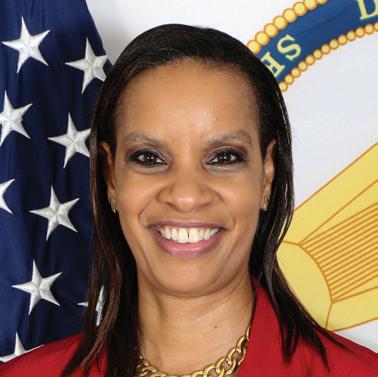
develops, implements, and reviews all policies and programs of mobilization, demobilization, and accessibility of the Reserve Component’s readiness resourcing and reporting; training institutions and support; training aids and devices; individual and unit training; and professional leadership education and development. He also serves as the advisor to the Army Reserve Forces Policy Committee, a general officer advisory group to the secretary of the Army, to integrate its recommendations into the planning efforts of the Department of the Army staff. Collins entered the Senior Executive Service in 2007 and is a 26-year Air Force veteran, retiring as a colonel and a Bronze Star combatproven aircraft maintenance and logistics leader.
Dr. Juanita M. Christensen
Director, U.S. Army Combat Capabilities Development Command, Aviation, and Missile Center, Redstone Arsenal, Alabama
Dr. Juanita Christensen was selected for Senior Executive Service in February 2015. She became the executive director of the U.S. Army Combat Capabilities Development Command Aviation & Missile Center (AvMC) at Redstone Arsenal, AL, in November
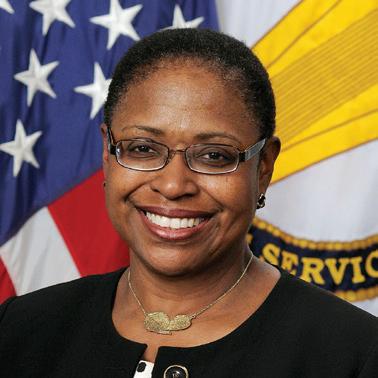
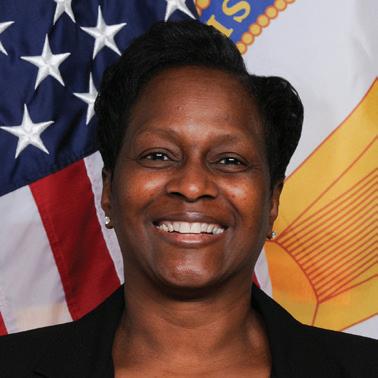
2017. The Aviation & Missile Center comprises approximately 12,000 military and civilian professional, scientific, and support personnel and manages a combined mission and reimbursable customer-funded budget of $3.9 billion annually. The director manages aviation and missile plans and executes technical research, engineering programs, and technical demonstrations. During her robust career, she has served in various engineering positions, including director of the Engineering Analysis Directorate, U.S. Army Space and Missile Defense Command, Technical Management Division chief, Project Management Office for Unmanned Aircraft Systems, and PEO Aviation. She moved to AvMC in 2012 as deputy director of the Aviation Development
Directorate and became director of the Weapons Development and Integration Directorate in 2015. Christensen received her B.S. in computer engineering from the University of Illinois, her M.A. in computer resource and information systems management from Webster University, and her doctorate in business, organizational leadership from the University of Phoenix.

As of June 6, 2022, Robert Cook started a new appointment as the principal deputy assistant secretary of the Army, Financial Management and Comptroller. Cook will have a significant role in strategic planning, workforce development, financial operations (including audibility), and financial systems improvement. He will also advise the assistant secretary of the Army, Financial Management and Comptroller, on all Army Security Agency and Financial Management and Comptroller matters. Cook spent over 26 years as an Army finance officer and has extensive experience in the private sector as a monetary management executive. He most recently served as a partner at Kearney and Company, one of the country’s largest certified public accounting firms that provide financial, information technology, and prosgram management services focused on the federal government. Before that, he was a director in Grant Thornton’s federal practice, providing audit and audit support services to the DOD and the Social Security Administration. His other private industry experience included serving as director, government services, Lockheed Martin Information Technology, where he led the outsourced DOD military retired pay operations—with a workforce of over 650 personnel who provided retired pay services for 2.2 million military retirees and their annuitants globally.
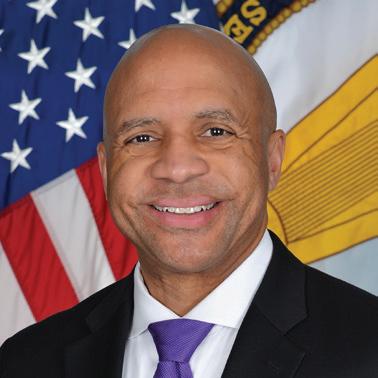
Deputy Command Counsel
U.S. Army Materiel Command (AMC)
Bobbi Davis serves as the Deputy Command counsel to the U.S. Army Materiel Command (AMC). She supports
the AMC Command counsel in the management and oversight of the Office of the Command Counsel. She is a legal and business advisor to the AMC commander, staff, and subordinate organizations in delivering, integrating, and synchronizing sustainment capabilities. Before this assignment, Davis served as the deputy chief counsel of Aviation and Mission Command (AMCOM), supporting the chief counsel and the AMCOM Command and staff in executing aviation and missile programs valued at over $20 billion annually. In her first assignment as a Department of the Army civilian, Davis served as the deputy chief counsel for the Expeditionary Contracting Command providing expeditionary contracting legal support across the full spectrum of military operations for Army service component commands and federal agencies. Davis served on active duty as a judge advocate (JA) for 23 years, retiring as a lieutenant colonel in 2015.
Julius Gamble
Assistant Deputy Chief of Staff/CIO, G6 Army Forces Command
Julius Gamble serves as the assistant deputy chief of staff/CIO, G-6, for Army Forces Command. In this role, he is responsible for exercising broad authority and leadership on all matters within the G-6 functional area of Command, Control, Communications, and Information Systems for the Army’s largest major command. Previously, Gamble served as the deputy portfolio acquisition executive for the U.S. Border Patrol, Customs and Border Protection (CBP), and Department of Homeland Security (DHS), where he was responsible for the governance, execution, and cybersecurity compliance of an acquisition technology portfolio valued at more than $2 billion annually. Before joining CBP, Gamble served as the deputy CIO for the City of Baltimore and the executive officer to the DHS chief information officer. Gamble has been an adjunct faculty
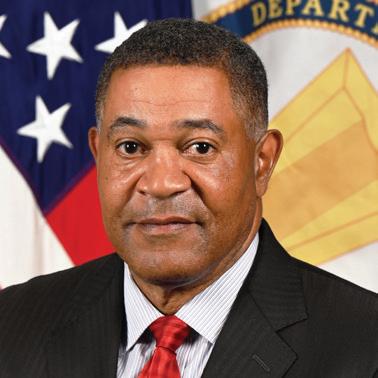
member for the University of Maryland’s Master of Science in Cybersecurity Technology Program since 2016. Gamble earned a Master of Science in information systems from American University, a Master of Divinity from Howard University, and a Bachelor of Science in business from Bowie State University.
Dr. Eric L. MooreDirector, U.S. Army Combat Capabilities Development Command
Dr. Eric Moore is the director of the U.S. Army Combat Capabilities Development Command (DEVCOM) Chemical Biological Center (CBC), the primary Department of Defense (DOD) technical organization for non-medical chemical and biological defense. He is an expert in chemical and biological defense and medical countermeasures and is a former Army officer. Moore entered the Senior Executive Service on Aug. 21, 2016 as a Tier 1 SES and was promoted to Tier 2 SES on Oct. 29, 2017. As the director of DEVCOM CBC, Moore oversees many of the nation’s key chemical and biological defense research and engineering projects, both classified and unclassified. In this role, Moore builds partnerships across the DOD, other government agencies, industry, and academia to enhance warfighter readiness and response to chemical and biological threats. He previously served as the chair and national lead of the Chemical, Biological, and Radiological (CBR) Memorandum of Understanding Assess Working Group and Inform Working Group. As chair, Moore led CBR MOU efforts between the United States, United Kingdom, Canada, and Australia to enable warfighters to detect, prevent, protect against, and respond to global CBR threats.
Chief Information Officer (CIO)/G6 U.S. Army Corp of Engineers
Dovarius Peoples was selected for the Senior Executive Service in January 2016. He was assigned as chief information officer (CIO)/G-6 in 2019 with the U.S. Army Corp of Engineers (USACE). In this role, he serves as the principal advisor to the

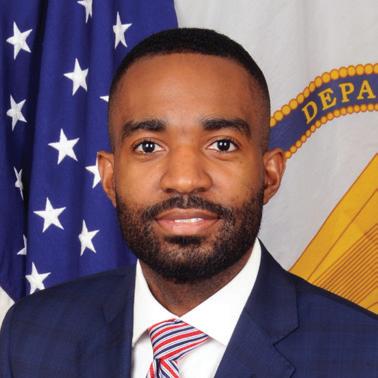
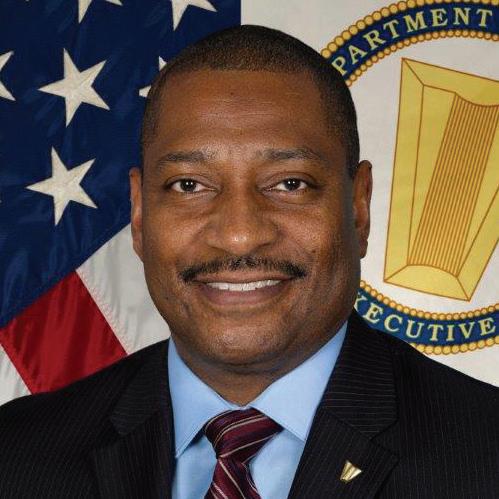
commanding general on information technology and is responsible for all aspects of information resource management and technology for USACE. Prior, he served as the deputy to the commanding general, Army Network Enterprise Technology Command. In this capacity, he provided senior technical leadership, ensuring Army theater-level networks were integrated into the Army’s portion of the Department of Defense Information Network and enterprise constructs. The command employed over 14,000 military, civilian, and contractors worldwide, with an annual budget of more than $1.4 billion. Previous assignments include information systems security engineer, National Security Agency; Information Assurance Division chief, USCYBERCOM J-6; lead architecture engineer, Mobility PMO, Defense Information Systems Agency; deputy director operations, U.S. Army Information Technology Agency; deputy director cyber solutions, Joint service provider Pentagon; and associate chief information officer, Office of Personnel Management.
Levator Norsworthy Deputy General Counsel—Acquisition

Levator Norsworthy Jr. was appointed to the Senior Executive Service in 1998 and currently serves as deputy general counsel (acquisition), where he assists the general counsel in providing advice and counsel to all Army secretariat officials, including the secretary of the Army, the Army acquisition executive, the Army chief information officer, and their staff. The provision of legal advice encompasses various functional areas such as federal procurement law, major weapon system acquisition, military construction, research and development, developmental and operational testing, logistics, international cooperative programs, security assistance, competitive sourcing, and contingency contracting.
Denise Council-Ross was selected for the Senior Executive Service in August 2022. She assumed the position of principal deputy general counsel for the Army on Aug. 1, 2022. CouncilRoss serves as the first assistant to the general counsel and is the number two attorney in the Department of the Army. Her duties include providing legal and policy advice to the secretary of the Army, the under secretary, five assistant secretaries, the secretariat, and other senior Army leaders. Before her new appointment, Council-Ross served as acting general counsel for the Office of the General Counsel, Department of Defense Education Activity. She facilitated a global educational mission by providing high-quality and timely legal advice, counsel, effective advocacy, and creative problemsolving. Council-Ross served over 20 years in the United States Army Judge Advocate General’s Corps (JAGC). At the time of her retirement in 2010, Council-Ross served as an assistant to the general counsel, U.S. Army, where she assisted the deputy general counsel (acquisition) in providing advice and counsel to all Army Secretariat officials, including the secretary of the Army, the Army acquisition executive, the Army chief information officer, and their staffs.
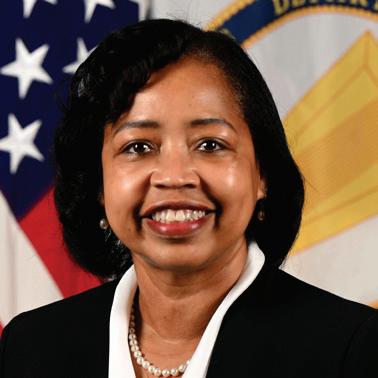
Director, Cybersecurity Integration and Synchronization Directorate, Headquarters Department of the Army, Deputy Chief of Staff (DCS) G-6.
Christopher I. Thomas is the director of the Cybersecurity Integration and Synchronization Directorate, Headquarters, Department of the Army, deputy chief of staff (DCS) G-6, beginning July 18, 2022. Thomas has had roles of increasing responsibility in the federal government cyber and IT space, most recently as IT director for the Office of the Deputy Chief of Staff,
G-9, from January 2019 to July 2022. Thomas was appointed to the Senior Executive Service in 2019. As the cybersecurity director, Thomas will serve as the principal advisor to the G-6 and other senior Army leaders on integrating all aspects of IT and cybersecurity strategy within the G-6. He is responsible for developing strategy, policy, and guidance for the Army’s ongoing cybersecurity and information assurance efforts. Thomas holds a master’s degree in information assurance from Capitol College and a Bachelor of Science degree in liberal studies (computer information systems) from Excelsior College. He is a certified information system security professional and Microsoft certified systems engineer, recipient of the National Defense University’s Chief Information Officer certificate and National Security Telecommunications and Information Systems Security Instruction and Committee on National Security Systems 4011-4016 certificates.
Brian Wood Executive Director, U.S. Army Aviation and Missile Logistics Center Army Aviation and Missile Command
Brian Wood is the executive director of the U.S. Army Aviation and Missile Logistics Center. His federal civilian career began in 1985 as an Army Materiel Command (AMC) intern in the contracting and acquisition career field. Wood, a native of Pulaski, TN, graduated from Memphis State University with a bachelor’s degree in business administration. While working, he continued his education at Alabama A&M University, earning a master’s degree in business administration. He also completed the Advanced Program in Logistics and Technology from the
University of North Carolina at Chapel Hill and the Senior Executive Fellows executive education program at the Harvard University Kennedy School of Government. Wood is a member of the Army Acquisition Corps. He has held numerous leadership positions within the Army Aviation and Missile Command (AMCOM) and the Army Materiel Command, including serving as the director of AMCOM G-3 and as deputy director of the Army Logistics Center (ALC) Supply Chain Management Directorate (SCMD). He has also served as the associate director for commercial operations, ALC-SCMD; director of Strategic Sourcing and Integrated Operations, AMCOM Integrated Materiel Management Center; and director of AMCOM’s Office of Continuous Improvement.
Max WycheDeputy Chief of Staff G-1 HQ U. S. Army Materiel Command
Appointed to the Senior Executive Service in 2015, Max Wyche is currently the deputy chief of staff, G-1, for the U.S. Army Materiel Command (AMC). In this position, he serves as one of the lead players in sustaining, training, and renewing the Materiel
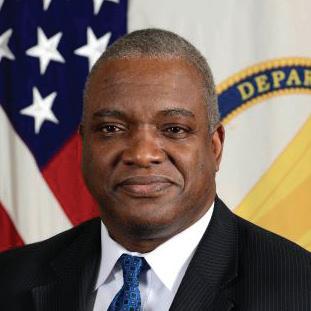
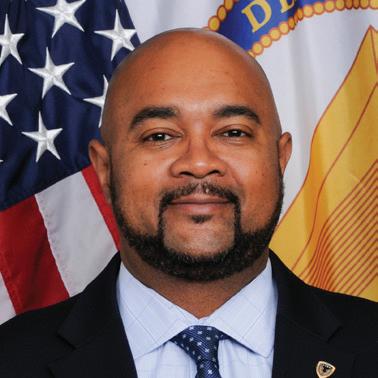
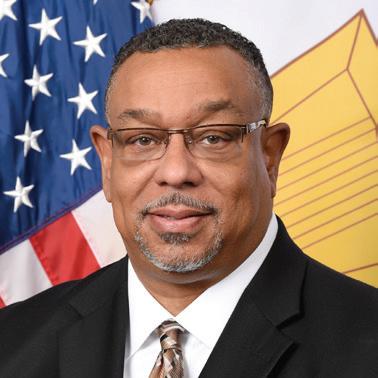
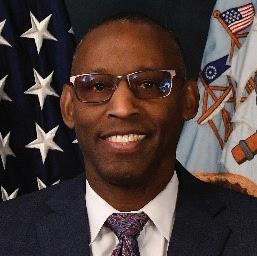
Command’s 185,000-plus civilian workforce. His portfolio of programs includes civilian and military personnel management, total force development and training, occupational health and safety, quality of life, and installation Soldier and Family Programs. Before his current assignment, Wyche was the executive director of strategic programs and advisory services, defense civilian personnel advisory services (DCPAS), a Defense Human Resources Activity component. Wyche was responsible for policies and program development affecting over 800,000 Department of Defense civilian employees. Additionally, he was responsible for managing civilian senior executive management programs, leadership, learning and development, strategic analysis and reporting, strategic human capital planning, human capital program assessment, accountability, and enterprise recruiting and outreach.
Acting as Assistant for Missile Production, Assembly & Operations

Tracy Arnold-Berrios is the assistant for missile production, assembly, and operations at Strategic Systems Programs (SSP). She is responsible for the strategic vision, policy, and plans for infrastructure across the enterprise, ensuring their sustainment and recapitalization to support the critical nuclear mission. Arnold-Berrios was promoted to the Senior Executive Service in 2019 and has extensive experience in design, development, production, and life-cycle management. She led several organizations through program planning, budgeting, and international program management. She joined Strategic Systems Programs in 2000, where she managed concurrent design and production activities, including the demonstration validation of the first successful launch of Tomahawk missiles from an Ohio class submarine. Arnold-Berrios earned a Bachelor of Science degree in chemical engineering from Northwestern University, a master’s in engineering administration degree from George Washington University, and is a graduate of the Defense Systems Management College Program Manager’s Course. Her awards include the Department of Navy Meritorious Civilian Service Award and the Navy Superior Civilian Service Award. She is a member of the Acquisition Professional Community.
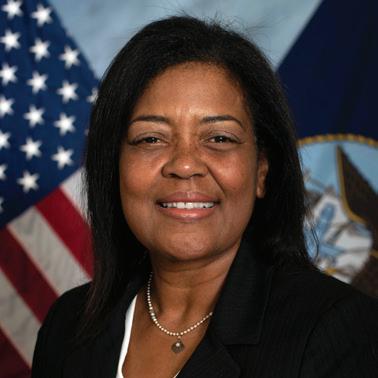
Executive
Commander, Navy Installations Command
Timothy Bridges is the executive director for Commander, Navy Installations Command (CNIC), providing shore capability to sustain the fleet, enable the fighter, and support the family. Before his time with the Navy, he served
in the Air Force for more than 40 years as an active-duty civil engineer and a member of the Senior Executive Service. His previous assignment was as the Air Force assistant deputy chief of staff for logistics, engineering, and force protection. Commissioned in 1979 as a distinguished graduate of the Air Force ROTC program at the Virginia Military Institute, he earned a bachelor’s degree in civil engineering. He engaged in the design, planning, contract and environmental management, and civil engineering operations. Bridges served twice as a base civil engineer squadron and installation commander. He also served as an Air Force ROTC assistant professor. He held various staff positions at the major command and Headquarters Air Force levels in the readiness, energy, environmental, and resources arenas. Bridges retired from active duty at the rank of colonel in July 2006 and entered the Senior Executive Service. In his civilian capacity, he has focused on installation and mission support.
Karen Davis Executive Director, Industrial Operations Naval Sea Systems CommandKaren M. Davis serves as the executive director for industrial operations, at Naval Sea Systems Command (NAVSEA), where in addition to directorate leadership, her principal responsibilities include executive oversight and support of the public naval shipyards and the Navy’s Supervisors of Shipbuilding and Repair organizations, collectively encompassing more than 38,000 civilian and military personnel. Davis’s immediate past position was executive director, Program Executive Office (PEO) Aircraft Carriers. She was the senior civilian leading a $50 billion portfolio for designing and constructing Gerald R. Ford-class aircraft carriers and executing mid-life refueling complex overhauls for Nimitz-class aircraft carriers. She previously served as executive director, Joint Special Operations Command, Fort Bragg, NC, where she led resourcing, support, and business integration matters for forces conducting special operations in protecting the homeland and U.S. interests abroad. Before this position, she served three years as NAVSEA’s executive director for surface
warfare, responsible for a $15 billion portfolio for fleet support of surface ships, inactive ships, foreign military sales, and ship transfer programs. Davis’s initial SES assignment was as director of Integrated Combat Systems, PEO Integrated Warfare Systems, leading engineering of integrated combat solutions for Navy surface combatants, amphibious ships, and aircraft carriers.
Executive Director Public Private Partnership Audit-Level Reviews Office of the Assistant Secretary of the Navy (Energy, Installations, and Environment)
The Honorable Eric K. Raven, under secretary of the Navy, appointed Donjette L. Gilmore auditor general of the Navy, effective June 19, 2022. The auditor general is the senior audit official responsible for internal audit development and implementation for the Department of the Navy’s (DON) $160 billion budget for 600,000 military and civilian personnel. With a $50 million operating budget, she provides executive direction and supervision of Naval Audit Service (NAVAUDSVC) audits worldwide. From Oct. 28, 2019 to June 18, 2022, as executive director, public private partnership (PPP) audits, she created DOD’s/DON’s first-ever oversight of independent, objective, and timely audits of the DON’s roughly $10 billion privatized family housing portfolio. She assessed the partner’s long-term financial viability to ensure continued quality, safe, well-maintained housing for sailors, Marines, and their families. From Jan. 31, 2017 to Feb. 3, 2019, she served as both acting auditor general and deputy auditor general of the Navy, validating $1.97 billion in savings, the largest savings in Navy and NAVAUDSVC history. From July 2010 to November 2015, as director, accounting and finance policy (now financial policy and reporting), Office of the Under Secretary of Defense (Comptroller), responsible for the roughly 7,200-page DOD Financial Management Regulation (FMR), she modernized the DOD FMR, optimizing business operations for about 2.2 million DOD and countless external users at zero cost.
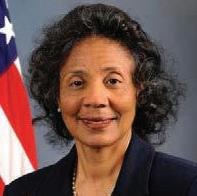
Director,
Leslie Joseph was appointed to the Senior Executive Service in October 2021 as the director of total force manpower after 20 years of civilian service. In this role, she serves as the principal advisor on all matters of military and civilian human capital management across 10 regions and 70 installations. Joseph is tasked with shaping the strategic direction, policy, and program support for the effective and efficient talent acquisition and management of a workforce of approximately 54,000 military, civilian, and contractors worldwide. Before this assignment, Joseph served as staff director to the deputy assistant secretary of the Navy (civilian personnel), who made sound recommendations on the strategic outlook for human capital; human resources service delivery; and diversity, equity, and inclusion, affecting the approximately 280,000 Navy civilian employees. A Texas native, Joseph is a Prairie View A&M University graduate with a Bachelor of Science degree in health and psychology and a Master of Education degree in adult and higher education from the University of Oklahoma. She is a member of the Society for Human Resource Management and Zeta Phi Beta Sorority, Incorporated.

Mobola A. Kadiri
Deputy Assistant Secretary of the Navy (Financial Operations)

Department of the Navy
Mobola Kadiri is the deputy assistant secretary of the Navy (financial operations). She is responsible for the Department of the Navy accounting and financial management operations oversight, policy, and
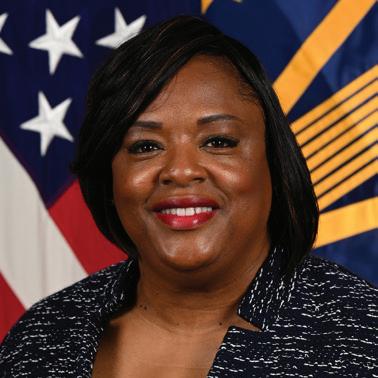
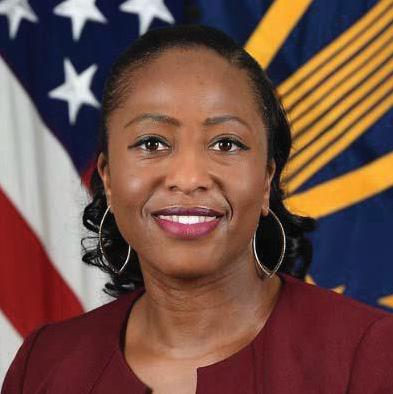
compliance, including audit remediation, financial reporting, integrated risk management, supporting financial management systems modernizations and data innovation. A strong diversity, equity, and inclusion advocate, Kadiri established and hosts a monthly Women in Financial Operations forum to empower, connect, and support women. Previously, Kadiri was the director of financial improvement and audit remediation in the Office of the Under Secretary of Defense (Comptroller). She was responsible for planning and implementing the Department of Defense audit remediation strategy and providing audit guidance throughout DOD. She led changes to impact programs, people, technology, and processes, driving efficiencies across the DOD. Kadiri served as a Navy program manager for pay and disbursing operations. She supported federal agencies as an auditor and consultant in the private sector. A mother of two boys, Kadiri graduated from the University of Maryland with a bachelor’s degree in accounting and an M.B.A. She holds professional certificates as a certified defense financial manager and DOD Financial Management Certification Program, Level 3.
Alonzie Scott III was appointed to the Senior Executive Service in September 2020 as the director of mission support, the Office of Naval Research (ONR). He is responsible for human capital, command
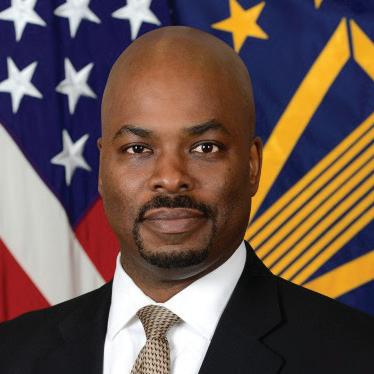
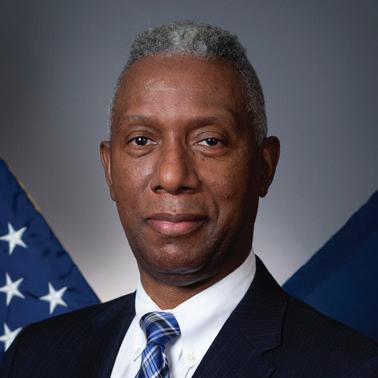
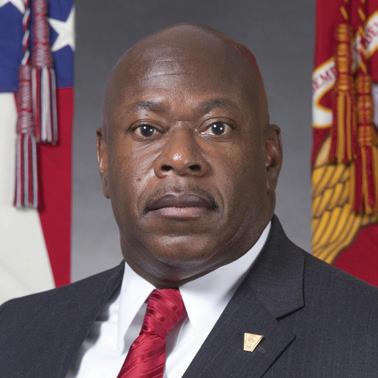

logistics, information technology infrastructure, facility management, security, small business, and performance improvement across the ONR enterprise. Before this position, Scott served as the Enterprise Talent Management Office/Senior Executive advisor at the Naval Surface Warfare Center in Philadelphia, PA. He was also director of the Enterprise Talent
Management Office and Senior Executive Management Office at the Naval Sea Systems Command (NAVSEA). Scott created innovative talent management; human capital; recruiting; quality of life; and science, technology, engineering, and math (STEM) programs throughout his career. His diverse and successful portfolio of work spans a 38-year career. He earned numerous awards such as the Navy Civilian Superior and Meritorious Service Awards, the Black Engineer of the Year (BEYA) Navy Senior Executive Service Winner, a special recognition award for Outstanding Leadership, OPM Best Practice for Executive Leadership, Command Excellence, and Navy Meritorious Unit Commendation Awards. Scott received bachelor’s and master’s degrees from the University of West Florida, where he serves on the Board of Trustees and as chair of the Student Affairs Committee.
Jimmy D. Smith assumed responsibilities as director of the Small Business Program in June 2019. He serves as the chief advisor to the secretary on all small business matters. Smith has been charged with overseeing small business acquisition policy, strengthening government and private sector partnerships, and fostering opportunities to leverage small businesses as a strategic advantage for the benefit of our warfighters. Smith received a Bachelor of Science degree in mechanical engineering in 1990 from Tuskegee University. His graduate-level studies included environmental engineering, marine engineering, and business management. He also possesses four executive leadership certificates from the Cornell University School of Industrial and Labor Relations and two other executive business certificates from the University of North Carolina at Chapel Hill’s Kenan-Flagler Business School. His awards include the Secretary of Defense Vanguard Award for Leadership Exemplified in Small Business Management in 2021, four Navy Meritorious Civilian Service Awards, two Navy Superior Civilian Service Awards, the 2020 and 2016 BEYA Stars and Stripes Award Winner, and
the Blacks-In-Government Department of Defense Civilian Meritorious Service Award in 2019.
Carl Shelton, Jr.
Deputy Inspector General Headquarters U.S. Marine Corps
As the deputy inspector general of the Marine Corps, Carl Shelton is the principal advisor to the deputy Naval inspector general for Marine Corps matters/inspector general of the Marine Corps (IGMC) with full authority to act in all matters within the mission of the IGMC. He is the senior civilian authority for promoting Marine Corps combat readiness, institutional integrity, effectiveness, discipline, and credibility through impartial and independent inspections, assessments, inquiries, investigations, teaching, and training. Acting under the authority, direction, and control of the secretary of the Navy, the IGMC is responsible for investigating and reporting on the efficiency of the Marine Corps and its preparation to support military operations by combatant commands. Shelton has gained extensive inspector general experience over the past 10 years, and he is certified by the Association of Inspectors General. Prior to assuming his current position, Shelton began his career as an infantry officer in the United States Marine Corps and retired after 30 years of faithful service. He holds a Bachelor of Arts degree in political science from Rutgers University and a master’s degree in national security strategy.
Assistant Director Deputy Commandant for Information U.S. Marine Corps (USMC)
Renata Spinks currently serves as the deputy director of the Command, Control, Communications, and Computers (C4) Department at Headquarters Marine Corps. In this capacity, she also serves as the deputy chief information officer and senior information security officer for the Marine Corps. Spinks was appointed to the Senior
Executive Service in August 2021, having previously served as the first cyber technology officer at Marine Forces Cyberspace Command (MARFORCYBER). She led the USMC mobile and remote workforce technical and operational buildout focused on cyber security as a foundational guide. Before Spinks’ assignment to MARFORCYBER, her career path included serving in the U.S. Treasury Department and the Department of Homeland Security. She is a decorated combat veteran, having done with the 28th Combat Support Hospital, U.S. Army 44th Medical Command. Spinks holds a B.S. in information systems, an M.S. in technology management, multiple information technology industry certifications, and is pursuing her Doctor of Engineering in cybersecurity analytics at George Washington University. She is the 2020 Stars & Stripes Becoming Everything You Are (BEYA) SES of the Year and an avid community service STEMINIST.
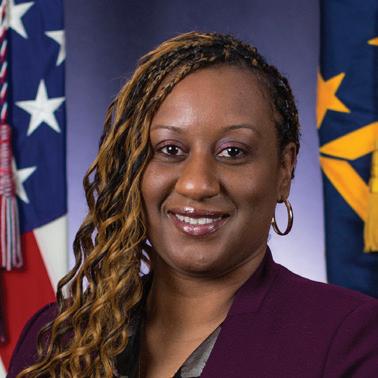
Director of Resource Integration, Deputy Chief of Staff for Logistics, Engineering, and Force Protection, Headquarters U.S. Air Force, Arlington, Virginia

Anthony Baity serves as the director of resource integration and deputy chief of staff for logistics, engineering, and force protection, Headquarters U.S. Air Force, Arlington, VA. He is responsible for the planning, programming, and budgeting of weapons systems sustainment, equipment and logistics, and installation resource requirements. As part of the Air Force corporate structure, Baity monitors operations and maintenance performance, working capital funds, and investment programs, participates in programs and financial review groups, and advocates for financial adjustments to optimize force readiness. He oversees the preparation and defense of these Air Force programs for the Office of the Secretary of
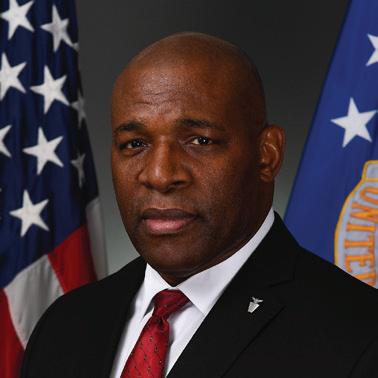
Defense, Office of Management and Budget, and Congress. He is also responsible for enterprise-wide logistics technology vision, strategy, advocacy, and policy. He oversees logistics transformation, agile planning and technology insertion, and development and implementation of innovative logistics concepts and capabilities. Baity is a career logistician with extensive experience at numerous wings, significant commands, and Headquarters Air Force. Before his current position, Baity provided executive leadership and direction for organizing, training, and equipping more than 180,000 logisticians who maintain and support mission generation and the aerospace weapons system inventory.
Director, Budget Investment Office of the Assistant Secretary of the Air Force for Financial Management and Comptroller
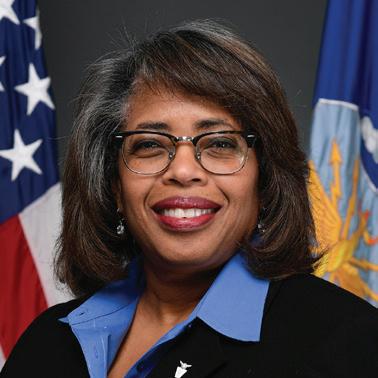
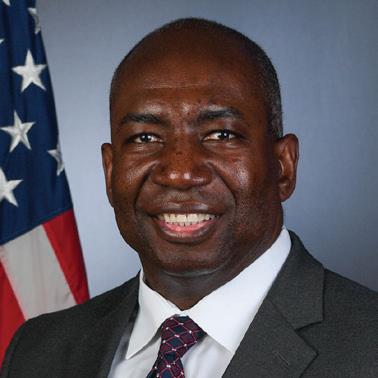
Teresa Bickett, a member of the Senior Executive Service, is director of budget investment, Office of the Assistant Secretary of the Air Force for financial management and comptroller, Washington, D.C. Bickett plans, directs, and supervises the budget formulation and financial execution of Air Force procurement, research, development, test and evaluation, military construction, family housing, and base realignment and closure appropriations that total more than $67 billion annually. Bickett entered federal civil service in 1985 as a logistician at Kelly Air Force Base in San Antonio, TX. She moved to Wright-Patterson Air Force Base, OH, in 1992 and has held various financial management and logistics leadership positions at Headquarters Air Force Materiel Command, Air Force Lifecycle Logistics Center, and the Air Force Research Laboratory. Before her current role, she served as deputy director of financial management at Headquarters Air Force Materiel Command, WrightPatterson Air Force Base. She was the command’s chief financial civilian and was responsible for financial planning and the full-scale execution of more than 35 percent of the Air Force appropriated budget, including the Air Force’s research, development, test, acquisitions, and
sustainment programs.
Dr. Gerald D. Curry
Director, Air Force Review Boards Agency
Office of the Assistant Secretary of the Air Force for Manpower and Reserve Affairs
Dr. Gerald Curry is the director of the Air Force Review Boards Agency, Office of the Assistant Secretary of the Air Force for Manpower and Reserve Affairs. He is responsible for managing and operating multiple military and civilian appellate processes that ensure due process, equity, fairness, and fair treatment for all applicants. He oversees the Air Force Personnel Council, Air Force Board for Correction of Military Records, Air Force Civilian Appellate Review Office, Air Force Security Protection Directorate, and the Department of Defense Physical Disability Board review. Curry has served for more than 37 years in the federal government, including multiple Air Force assignments as well as the chief of staff at the Defense Security Service, and Department of Energy, where he entered the ranks of SES as the deputy associate undersecretary for security, in the Office of Associate Under Secretary Environment, Health, Safety, and Security. He was responsible for department-wide security policy development, oversight, and execution. Additionally, his responsibilities influenced international and domestic nuclear security standards and policies.
Deputy Director of logistics, Engineering, and Force Protection
Headquarters Air Mobility Command, Scott Air Force Base, Illinois
Elizabeth Foster is the deputy director of logistics, engineering, and force protection at Headquarters Air Mobility Command. Foster assists the director in the leadership, management, and integration of total force logistics, engineering, and force protection activities across the global mobility Air Force enterprise. The
directorate also directly supports the 18th Air Force, Air Mobility Command’s sole warfighting
Numbered Air Force, and the U.S. Air Force Expeditionary Center, the Air Force’s Center of Excellence for en route contingency response, and partnership capacity-building mission sets. Foster began her career in 1980 at the Marine Corps Logistics Base in Albany, GA. She entered the Air Force in 1982 at Kelly Air Force Base, TX, as a professional Administrative Civil Service Exam trainee and has more than 30 years of logistics and supply chain management experience. She served in several supervisory positions at Kelly Air Force Base until the C-5 workload transferred to Robins Air Force Base, GA. While at Robins Air Force Base, she served as the chief of the C-5 Sustainment Division. She also served as the chief of the Supply Programs Branch at the Pentagon in Arlington, VA. Before her current assignment, she was chief of the Resource Integration Division, Headquarters Air Mobility Command, Scott Air Force Base, IL.
Timothy A. Gerald Deputy Director of Security Forces, Deputy Chief of Staff for Logistics Engineering and Force ProtectionTimothy A. Gerald, a member of the Senior Executive Service, is the deputy director of security forces and deputy chief of staff for logistics, engineering, and force protection
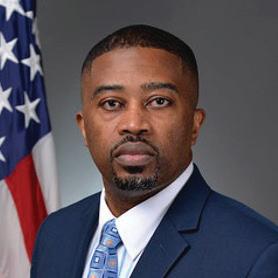
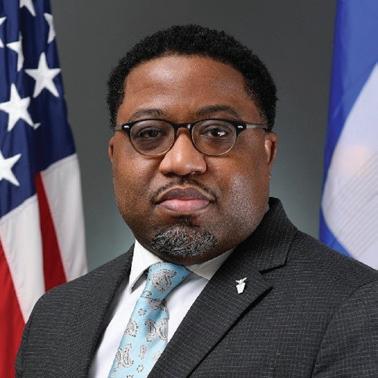
at Headquarters U.S. Air Force. He is responsible for supporting the director of security forces by providing executive leadership, direction, broad technical knowledge, and executivelevel strategic continuity for a worldwide force of 38,000 active-duty and Reserve component security forces personnel conducting base defense operations, including physical
security, antiterrorism, force protection, and policing. He also serves as the senior Air Force civilian and functional manager overseeing all matters concerning utilization, development, and career field management of the 4,600-person department of the Air Force civilian police force. Finally, he serves as the senior authorizing official for all security forces technology systems. Before his current position, Gerald served as the chief of the Requirements and Readiness Division, deputy chief of staff for logistics, engineering, and force protection, Headquarters, Air Force. Gerald enlisted in the Air Force in September 1985 and graduated from the Security Specialist and Air Base Ground Defense courses as an honor graduate. He served 22 years on active duty and held various positions in the security force’s care career field as well as special duty assignments as an Airman Leadership School instructor and as a ceremonial guardsman with the United States Air Force Honor Guard.
Director of Enterprise Information Technology Office of the Chief Information Officer
Venice M. Goodwine, a member of the Senior Executive Service, is the director of enterprise information technology within the Office of the Chief Information Officer for the Department of the Air Force, comprised of the U.S. Air Force and U.S. Space Force. As the director of enterprise information technology, she leads management, planning, governance, and resourcing for enterprise IT for the department’s $7 billion Information and Cybersecurity enterprise. She has more than 28 years of information technology experience spanning private industry, active and reserve military service, and the federal civilian government. Her experience includes leading large IT organizations, developing agency-wide strategy and policy, establishing governance, overseeing cyber security operations, and executing acquisition and program management. Before this role, Goodwine was the chief information security officer for the United States Department of Agriculture, a cabinet-level agency. As the USDA CISO, she oversaw $208 million in cybersecurity
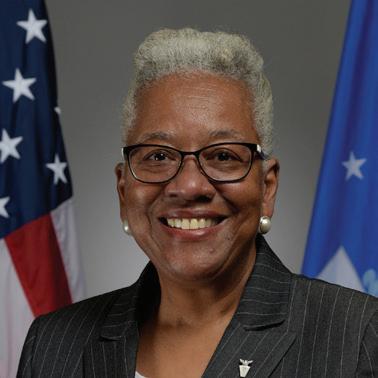
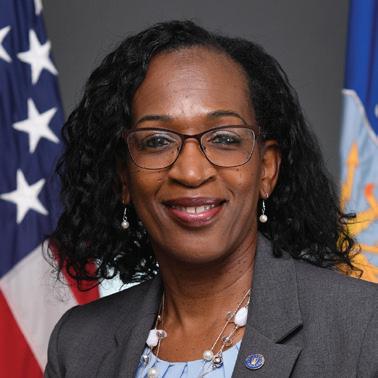
expenditures throughout the agency each year. She raised the agency’s FITARA cyber score from an F to a B. She led the agency to achieve a single unified security operations center by consolidating 128 federal and contractor FTEs, 57 processes, and 11 tools, valued at more than $8.2 million.

Director, Headquarters Air Force Information Management Office of the Administrative Assistant to the Secretary of the Air Force
Dr. Keith Hardiman is director of Headquarters Air Force information management, Office of the Administrative Assistant to the Secretary of the Air Force, Arlington, VA, and the Headquarters Air Force chief information officer and liaison to the Pentagon Architecture Council. He also manages the Air Force Declassification Office, Air Force Publications Distribution Office, and Headquarters Air Force multimedia services. His leadership responsibilities include HAF’s Records Management, Freedom of Information Act, and Privacy Act Programs, along with information technology policy and portfolio compliance. Before his current position, Hardiman served as the technical director and chief data officer for the Logistics Chief Information Officer Support Division, Directorate of Resource Integration, deputy chief of staff for logistics, engineering, and force protection, Headquarters U.S. Air Force. In this capacity, he was the technical expert consultant for the Directorate and assisted in developing and executing CIO strategic initiatives supporting enterprise logistics information technology.
Chief Scientist, National Air and Space Intelligence Center Wright-Patterson Air Force Base
Duane W. Harrison, a Defense intelligence senior-level executive, is the chief scientist National Air and Space Intelligence Center (NASIC), the Air Force analysis center for foreign air, space, and specialized intelligence. As chief scientist, Harrison guides the four-person center’s analytic production mission, ensuring timely delivery of relevant intelligence data
products and services to Air Force and joint operational warfighters, acquisition and force modernization communities, and senior defense and intelligence community policymaking customers. Harrison entered federal service in 2001 as a command, control, communications, and computers and information operations analyst at NASIC. He has served as the senior intelligence analyst for both the Signals Analysis Squadron and the Counterspace Analysis Squadron at NASIC. His extensive career includes details of a U.S. intelligence community, particularly program activity of the Office of the Director of National Intelligence joint duty assignment as the Defense Intelligence Agency and the Missile Defense Agency representative.
Russell Hudgins currently serves as the intelligence director of the Space Warfighting Analysis Center (SWAC). The SWAC was established in 2021 to develop and provide authoritative force design guidance for the United States Space Force. As the SWAC intelligence director, Hudgins ensures SWAC force design analyses are executed across the center in the proper context to the evolving adversary threats and challenges to the mission effectiveness of national security space services and leads the direction and execution of threat assessment analyses in close coordination with the United States Space Force, Department of Defense, and intelligence community mission. Hudgins entered federal service in 2004 as an imagery analyst at the National GeospatialIntelligence Agency (GEOINT), where he served until 2017 in several analytic and liaison positions, and most recently as the senior GEOINT officer for space and counter space analysis in the Office of Counterproliferation, including two joint duty assignments supporting the Central
Intelligence Agency and Office of the Director of National Intelligence. Before his current position, Hudgins served as the senior intelligence advisor to the Space Security and Defense Program (SSDP). At the Space Security and Defense Program, Hudgins led the development of intelligence support plans for all SSDP activities.
Principal Cyber Advisor for the Department of the Air Force U.S. Air Force and U.S. Space Force
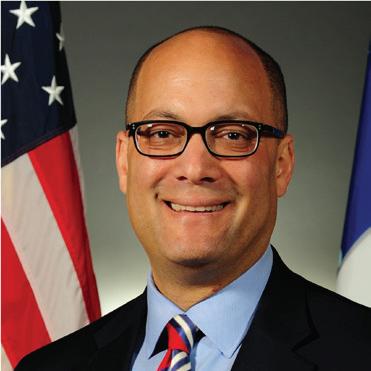
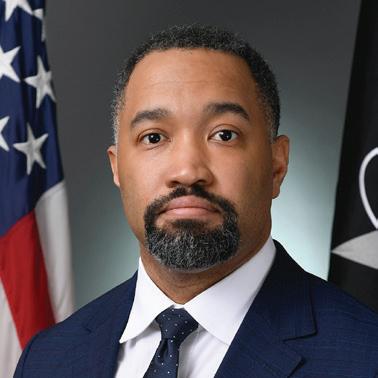
Wanda T. Jones-Heath, a member of the Senior Executive Service, is the principal cyber advisor for the Department of the Air Force (DAF), comprised of the U.S. Air Force and U.S. Space Force. As the chief cyber advisor for the DAF, her duties include


synchronizing, coordinating, and overseeing the implementation of the DAF cyber strategy and advising the secretary of the Air Force on all cyber programs. She oversees cyberspace recruitment, resourcing, and training of cyber mission forces, assessing their readiness, managing acquisition, advocating for cyber investments, cyber security supply chain risk management, and security of information systems and weapon systems. Before her current position, Jones-Heath served as the chief information security officer and advised the chief information officer on cyber security policy, programs, and cyber force development. She leads a directorate comprised of military, civilian, and contractor personnel responsible for developing cyber security policy and strategy for over 5,000 Air Force information technology systems. She oversees risk management and cyber security accountability for information systems, weapon systems, and operational technology supporting military cyberspace operations. Her portfolio includes policy governing the defense industrial base, supply chain risk management, and cyber security capabilities. She oversees the Freedom of Information Act, Privacy Act laws, and cryptographic modernization supporting cyber operations.
Horace L. Larry
Director of Air Force Services, Headquarters U.S. Air Force, the Pentagon, Arlington, Virginia
Horace L. Larry is the director of Air Force Services, Headquarters U.S. Air Force. He assists the deputy chief of staff for manpower and personnel and services in delivering services capabilities to optimize airmen’s performance through care solutions that help build and maintain resilient, ready airmen and families. His team provides policy direction, funding advocacy, and oversight for the $2.9 billion worldwide services program. This includes physical fitness, peacetime, wartime troop feeding, Air Force mortuary affairs operations, armed forces entertainment, Air Force protocol, lodging, and libraries. It also includes the Wounded Warrior Program, the Transition Assistance Program, Airmen and Family Readiness Centers, child development centers, youth centers, and a broad spectrum of recreational activities. Larry received his Air Force commission in 1975. Over the next 30 years, he was assigned to various installations at the Pentagon, including Headquarters Air Force Personnel Center, the Air Force Services Agency, Headquarters Air Force Services, and the Air Force Secretariat. Larry’s leadership positions include deputy support group commander, Aviano Air Base, Italy; commander of the Air Force Services Agency in San Antonio, TX; and deputy director of Air Force Services in the Office of the Deputy Chief of Staff for Installations and Logistics at the Pentagon. He retired from the Air Force in August 2005 as a colonel. Larry was appointed to the Senior Executive Service as deputy director of services in July 2009 and became director of services in August 2018.
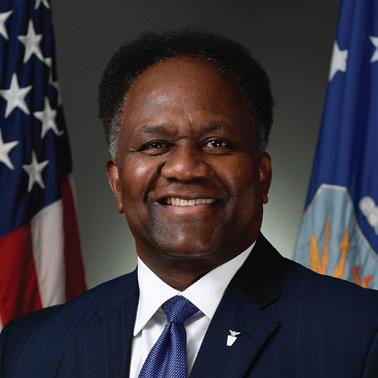
Director of Contracting, Life Cycle Management Center Hanscom Air Force Base, Massachusetts
Anna Marie Morris serves as the director of contracting at the Life Cycle Management Center, Hanscom
Air Force Base, MA. Morris leads a 500-person missionfocused contracting workforce and provides the necessary resources and environment to deliver innovative and agile solutions to the warfighter. While overseeing more than $4 billion in annual contract obligations, she supports multiple program executives off cars on more than 300 programs. Morris was commissioned in 1990 through the Reserve Officer Training Corps at the University of Florida. During her career, she garnered a broad range of experiences with numerous assignments and commands at the squadron, wing, product center, and primary command level across the Air Force. Before this assignment, she served as the deputy director of contracting at the Air Force Sustainment Center, Robins Air Force Base, GA. While on active duty, Morris deployed in support of Operation Iraqi Freedom and Operation Enduring Freedom to the Joint Contracting Command Iraq/Afghanistan. Additionally, she served as the first Defense Contract Management Agency Pacific commander in Singapore. She led the contract administration services for the F-35 and F135 Final Assembly and Checkout facilities and the first F-16 maintenance hub in Taichung, Taiwan.
Deputy for Budget, Office of the Assistant Secretary of the Air Force Financial Management and Comptroller, Headquarters U.S. Air Force
Carlos Rodgers, a member of the Senior Executive Service, is the deputy for budget, Office of the Assistant Secretary of the Air Force for Financial Management and Comptroller, Headquarters U.S. Air Force, Arlington, VA, where he is responsible for planning and directing
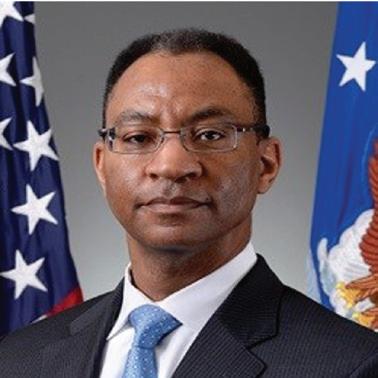
Air and Space Force budget formulation and execution of appropriations. He leads a staff of civilian and military financial managers who develop, defend, and execute more than $165 billion in funding that supports military operations and Department of the Air Force priorities. Rodgers entered government service as an Air Force palace acquire intern in 1987. During his career, he has held more responsible financial management positions progressively in operational and support commands, including assignments at Headquarters Military Airlift Command (renamed Air Mobility Command), Headquarters Air Force Communications Command (reorganized to Air Force Network Integration Center), Headquarters Air Force Special Operations Command, and Air Force Materiel Command. Rodgers has more than 25 years of experience in various single and joint service programs, including automated information/computer and communication systems, weapons, munitions, and aircraft.
Deputy Director, Concepts, Development, and Management Office (CDM) Secretary of the Air Force.
Tawanda Rooney is the deputy director of the Concepts, Development, and Management Office (CDM). Rooney oversees assigned organizations, programs, and developmental activities, totaling over $5 billion in support of national security and operational priorities. Before this assignment,
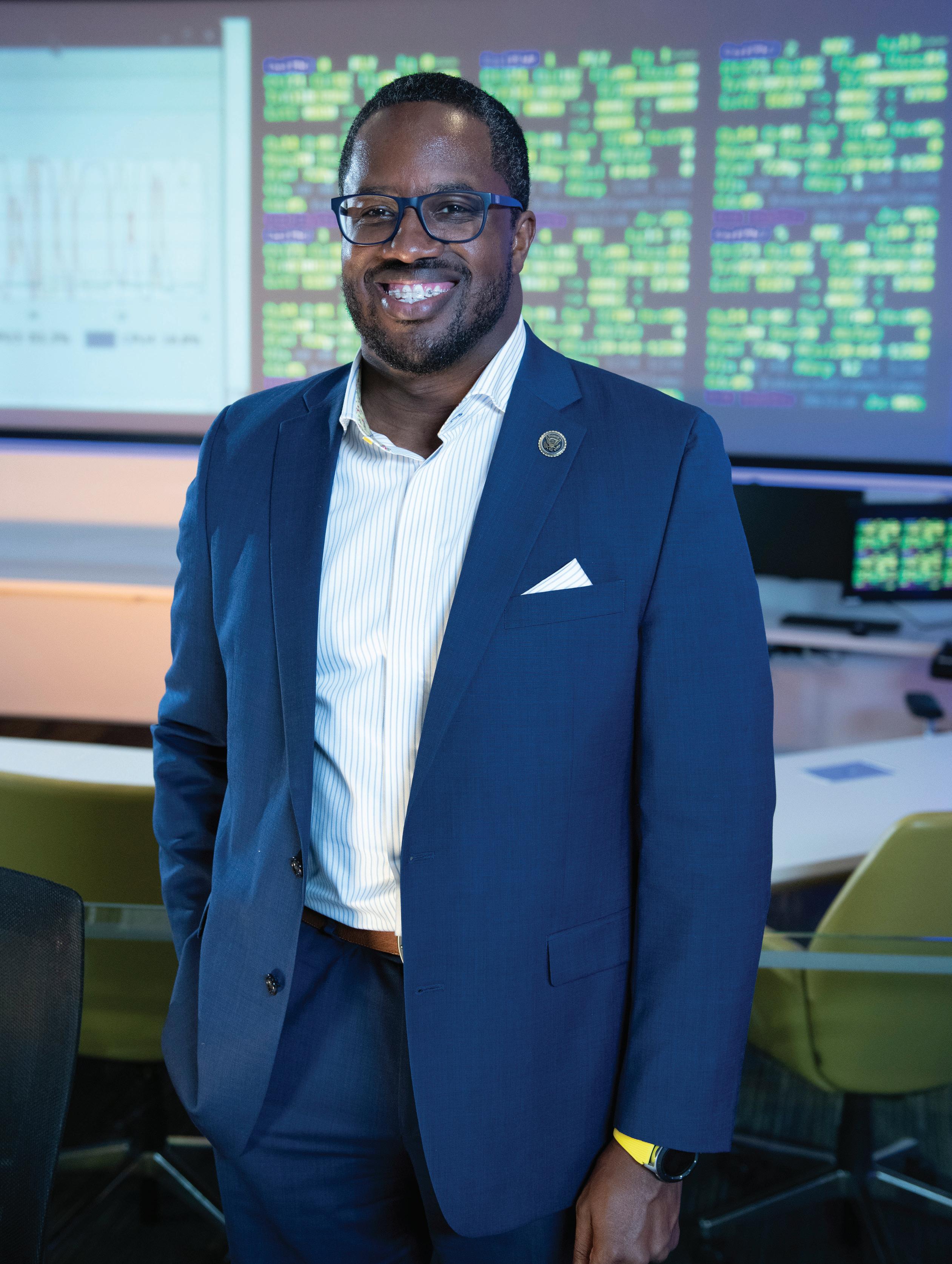
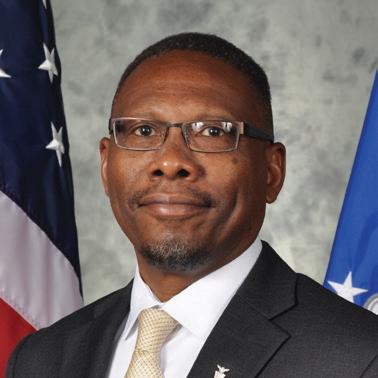
Rooney was appointed by the secretary of the Air Force as the acting director of diversity and inclusion for the Department of the Air Force (DAF). In this role, Rooney was responsible for establishing the new office under the National Defense Authorization Act; advising the secretary of the Air Force on DAF’s diversity and inclusion program, policies, and initiatives; and aligning the DAF diversity and inclusion strategy with its mission to attract, recruit, develop, and retain a high-quality, diverse total force, ensuring a culture of inclusion.
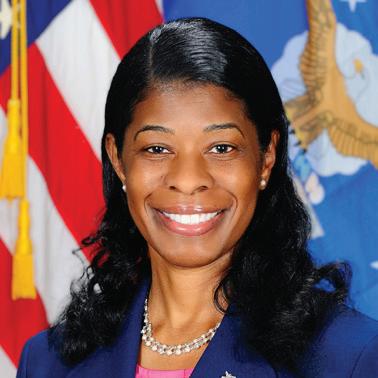
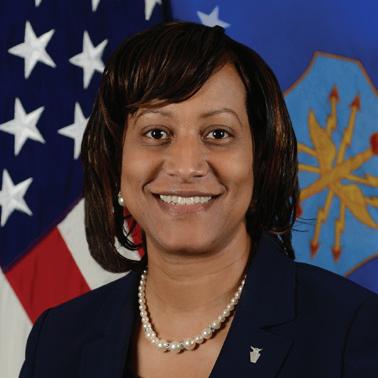
Rooney also served as the Intelligence Systems Support Office (ISSO) director, leading technology development and methodology efforts that provided specialized and innovative approaches to

address strategic, operational, and tactical requirements. Rooney’s civilian federal career in the DOD began in the Air Force’s summer-hire program at the Pentagon in 1984. In 1988, Rooney joined the assistant secretary of the Air Force for acquisition, Directorate of Space Programs, where she provided budget analysis for space and space-related programs.
Alphonso Thomas is the director of engineering and technical management at the Air Force Sustainment Center (AFSC), Tinker Air Force Base, OK. He is responsible for developing, implementing, and overseeing the center’s technical policies, processes, databases, goals, standards, and overall scientific and engineering expertise for the AFSC. Thomas is responsible for leadership and technical direction to a specialized workforce of more than 4,500 science and engineering professionals supporting the center’s mission at three locations (Robins Air Force Base, GA; Hill Air Force Base, UT; and Tinker) and encompassing depot maintenance, repair, and overhaul activities; supply chain management; and software maintenance and development enterprise. Before his current position, Thomas served the Technical Engineering Authority for a world-class organization of more than 7,200 military and civilian personnel.
Thomas enlisted in the Air Force as a bandsman and later received his commission as an officer through Office Training School. He began his engineering career by managing space and missile warning acquisition programs, including the Defense Support Program and the Cheyenne Mountain Upgrade Program. He started his civil service career at the Warner Robins Air Logistics Center, leading the development and test of software sustainment and upgrades for the B-1 Bomber and Electronic Attack pods. S
At Northrop Grumman, some of the finest minds in the country are part of our diverse team. Northrop Grumman employees come from varied backgrounds and have unique skills and experiences. It is this diversity that makes us great. It fosters creativity and enables us to create some of the most technically sophisticated products and solutions in the world. Join us on our mission to push past possible and invent tomorrow’s technologies.

 by Gale Horton Gay editors@ccgmag.com
by Gale Horton Gay editors@ccgmag.com
Ed Clark has had a fulfilling career in aviation, so much so that he continues to share both its past and the potential of its future with adults and young people.
Clark is a former Army helicopter pilot who now is both a board member and pilot with Army Aviation Heritage Foundation & Flying Museum (AAHF) in Hampton, GA. One of the goals of the 25-year-old nonprofit organization is to “obtain, restore, and maintain in flyable condition, examples of historic aircraft representing Army aviation from Vietnam to present.”
Each of AAHF’s decommissioned aircraft—from the Korean War era to the present day—is restored to Army specifications with help from partners and volunteers, many of whom flew and fought during the Vietnam War.
“We honor the sacrifices and service of veterans and their families by preserving, promoting, and protecting the legacy of U.S. Army Aviation,” states the organization’s brochure. “We support veterans and patriots by providing engaging volunteer opportunities that extend or create connections to U.S. Army aviation.”
Clark previously served as president and CEO of AAHF for five years and helped the organization grow from 700 volunteers to more than 2,000, according to his resume.
He and the other AAHF members also have another goal: encouraging young people to consider careers in aviation
by supporting educational initiatives in science, technology, engineering, and math. They fly their helicopters to schools as well as air shows and talk to students about aircraft and careers in aviation. They also invite them to visit their hangar for rides and exploration.
Flying a helicopter onto a school’s campus captures the attention of students, Clark said, noting the rumble of the aircraft as it lands and takes off as well as its visual appearance making a memorable impression. Many young people think about planes and jets when it comes to aviation but not helicopters, he added.
“There are not a lot of us African Americans that fly helicopters, and even jets for that matter,” said Clark.
He said the United States needs more scientists, engineers, mechanics, and pilots, and many aviation companies are now seeking to add more diversity to their ranks in these occupations. There are currently tremendous opportunities in aviation for “young energetic African Americans and Hispanics” who possess the qualifications and skills, Clark said.
At AAHF’s hangar in Hampton, aircraft such as the AH-1 Cobra, UH-l Iroquois (Huey), OH-6 Cayuse (Loach), OH-58 Kiowa, and O-1/L1-19 Cessna (Bird Dog) are on display. Visitors are encouraged to explore the hangar, examine the aircraft, learn about how they were operated in war and conflicts from pilots and volunteers, and climb into the cockpit.
Rides in the Huey are offered starting at $100 per person for a 10-minute experience, and a jaunt in the Cobra costs $625 per person.
Clark earned a bachelor’s degree in engineering from the U.S. Military Academy West Point and a master’s degree in aeronautical science from Embry-Riddle University. He served in the Army for 10 years in several capacities including as an instructor pilot and company commander, rising to the rank of captain. After he left the military, Clark worked in sales and marketing for various companies including Georgia-Pacific in Atlanta, GA. In 2013, Clark became an entrepreneur when he founded GRN Atlanta South, an executive search firm for the corrugated industry and paper mills.
Clark doesn’t have to look far to see the impact military service and aviation careers can have on young lives. His wife Molly, who served in the Army as an ordnance officer when they met, was a pilot, and both his daughters have attended West Point. Lt. Col. Kristina Clark, his oldest daughter, works at the Pentagon. His youngest daughter Maj. Kasandra Clark flew Black Hawk helicopters for Army special operations and now is pursuing commercial pilot certification with her sights set on becoming an airline pilot, he said.
AAHF has two other chapters aside from the one in Georgia—in Mesa, AZ and St. Louis, MO. S
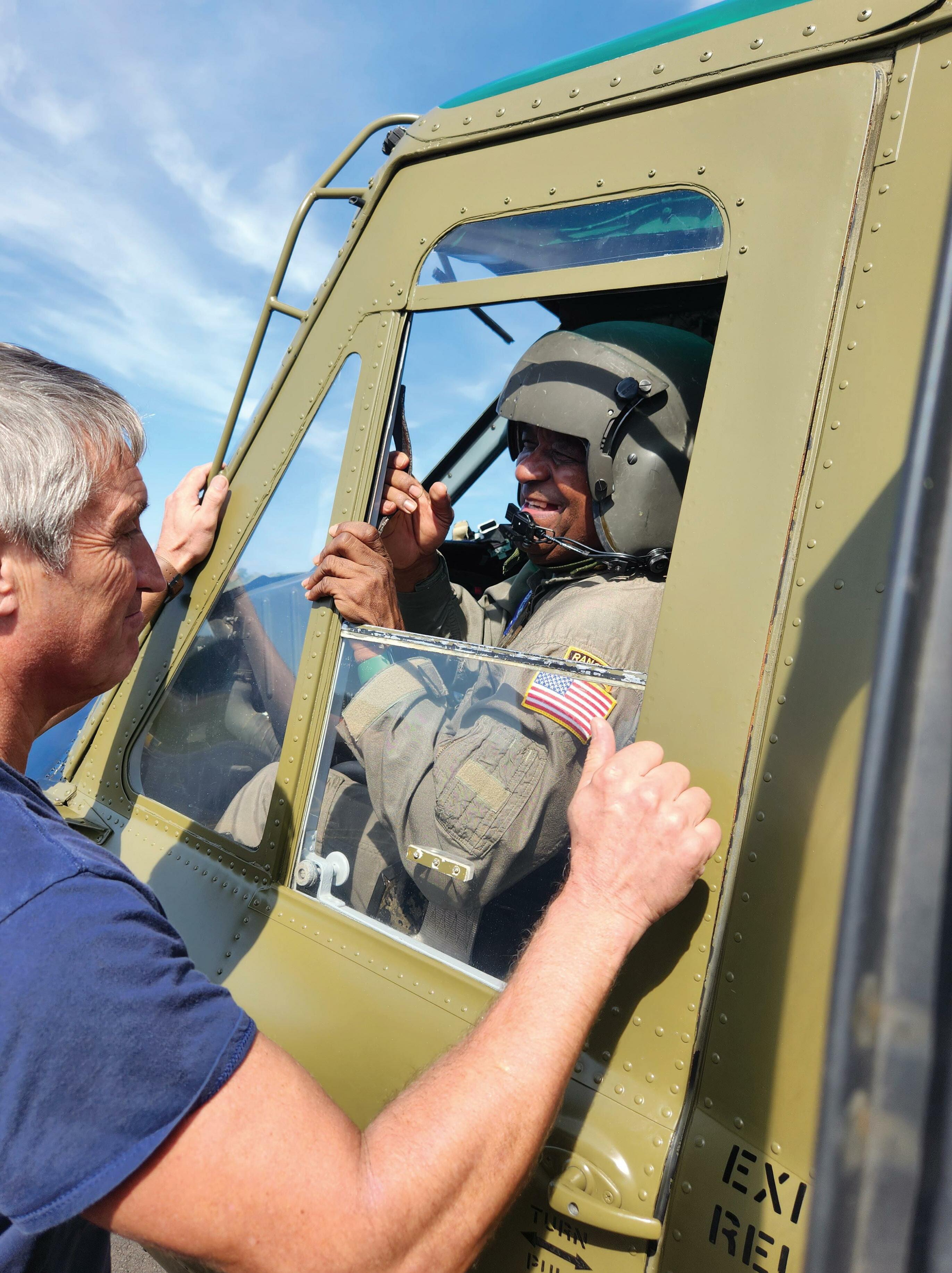
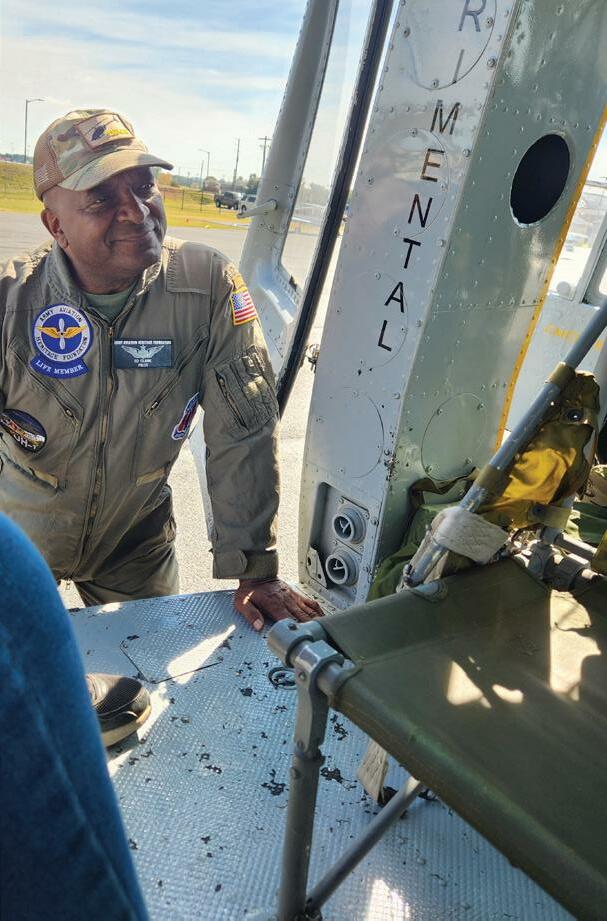
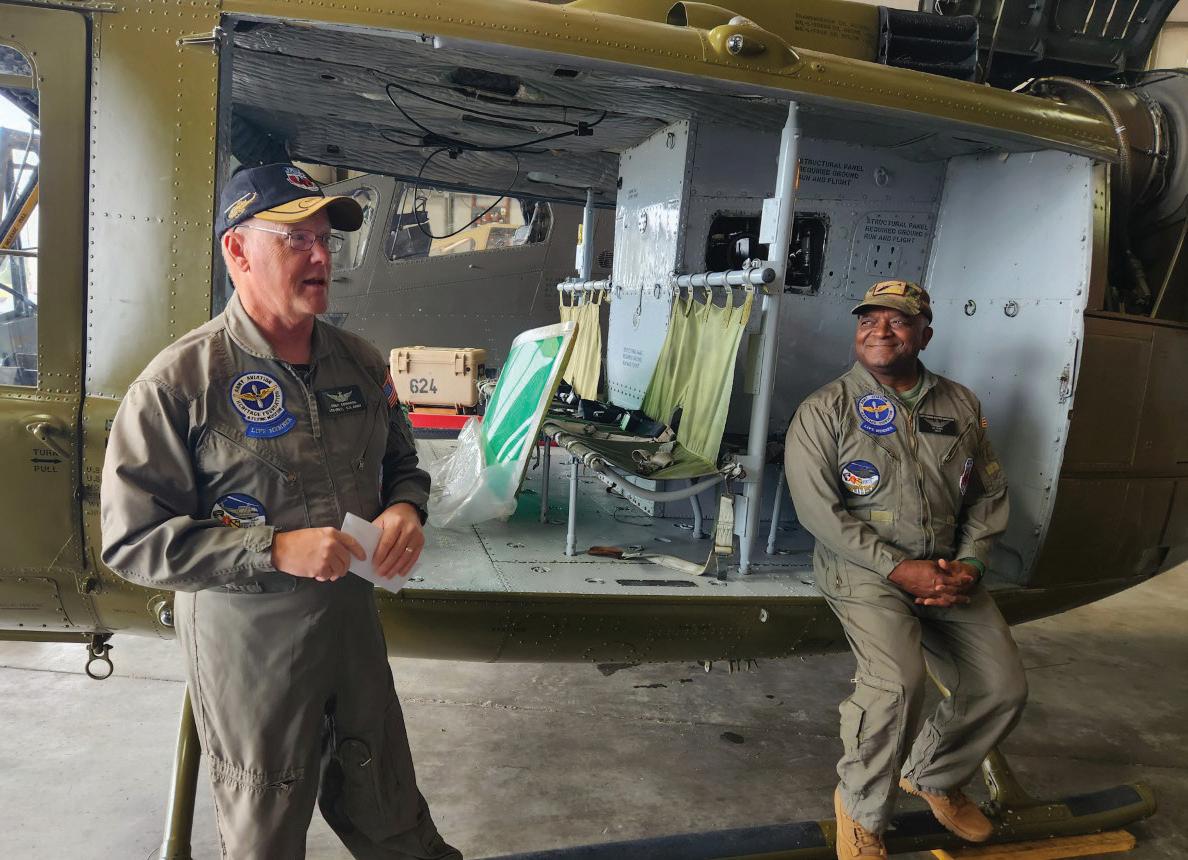
We honor the sacrifices and service of veterans and their families by preserving, promoting, and protecting the legacy of U.S. Army Aviation. ”Pilots Fred Edwards, left, and Ed Clark are two leaders of the Army Aviation Heritage Foundation & Flying Museum in Hampton, GA. Photos by Gale Horton Gay
US Black Engineer & Information Technology (USBE&IT) magazine launched the maiden issue of Leading Voices (LV) in the fall of 2017. Broken up into three or four columns written by inventors, entrepreneurs, and STEM policymakers, the section spotlights the 14 challenges outlined by the National Academy of Engineering, and disruptors such as artificial intelligence and bioengineering. Through the years, LV has provided perspectives on smart cities, building a weather-ready nation, and where AI is in your future. An auspicious start for one of USBE magazine’s newest sections. Leading Voices is available in print and online at www.blackengineer.com.
In 23 years of Naval service, I have learned that candid and open discussions that welcome dissenting or different opinions can be an effective catalyst for change; it is no different for racial injustice. If the Navy truly believes that inclusion and diversity are critical to warfighting readiness, now is the time for real progress, building on the foundation laid by Adm. Elmo Russell “Bud” Zumwalt Jr., the 19th chief of Naval operations.
In 1970, in the wake of Secretary of the Navy John Chafee’s ALNAV 51 on equal opportunity, Zumwalt released a trailblazing document, Z-Gram 66: “Equal Opportunity in the Navy.” In this message, he noted, “What struck me more than anything else was the depth of feeling of our Black personnel that there is significant discrimination in the Navy.”
your team represents. You stand in front of that team because your oath to the Constitution is the burden you chose, bearing true faith and allegiance to it, freely, without mental reservation, to faithfully discharge the duties of your office.
Fifty years later, I was both encouraged and disheartened to read the June 3 statement from the 32nd chief of Naval operations, Adm. Michael Gilday, where he said, “I can’t imagine the pain and disappointment and anger that many of you felt when you saw that [the choking of George Floyd].” I was encouraged because Gilday said what he said, but I was disheartened because I doubt anyone expected this conversation to carry forward to 2020. After five decades of Navy innovation, progress, and change, we find ourselves back where we started. Some may feel things have gotten better, but I’m certain a great number of Black officers in the Navy feel little has truly changed.
The foundations of Naval leadership are laid through commissioning programs and are built on through other training and experiences over the full span of an officer’s career. However, this training and experience have never considered the Black officer’s additional burden.
Imagine standing in front of your team. Division, department, command—it does not matter the scope. You are standing in front of them as you prepare to head into harm’s way: a deployment to a part of the world with global competitors who actively oppose what
Now consider the perspective of the Black officer standing in front of his or her team today. Individually, we carry the burden of the Black American experience as a generational post-traumatic stress disorder that has gone untreated for more than 400 years. Imagine not only leading your sailors in daily freedom of navigation operations on a $1.8 billion warship in the South China Sea but also dealing with the exhaustive mental drain of cumulative questioning. Black officers often bear the weight of being labeled examples of Black excellence or Black incompetence. Imagine not only having to fly a $100 million aircraft over an adversary’s country to drop ordnance or conduct operations at risk of being shot down but also experiencing the persistent emotional drain of questioning whether you are being judged on the content of your character and performance or the color of your skin.
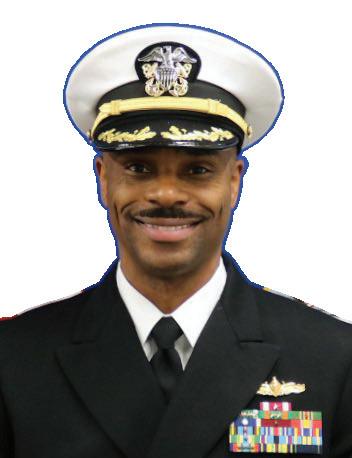
This is happening behind the mask that Coast Guard Commander Marcus Canady discusses in his recent article. Ironically, we wear the mask as a form of protection; in reality, we want to be seen and heard—as equals. We want the earned opportunity to qualify as a primary warfare designator without prejudice because of where we went to school or our commissioning source. We need our commanders and commanding officers to challenge, counsel, and mentor us months before a fitness report debrief that reflects that we are below average. Like any sailor, we want divisional or departmental leaders to get to know us beyond any preconceived notions that prevent them from being involved in our professional development.
Within the last year, the Navy has introduced the “Culture of Excellence,” “Signature Behaviors of the 21st Century
Sailor,” and “U.S. Navy Inclusion and Diversity Goals & Objectives.” The three documents provide an outstanding framework to aid commanders and commanding officers in the difficult task of building an enduring culture of excellence. However, the deep and complementary conversations are long overdue. Progress requires engagement on this issue at every level of the chain of command. We will get there only when leaders are willing to listen, reflect, learn, and adapt—through action.
For far too long, Black officers have seen top-down inclusion and diversity policy revisions that commanders and commanding officers are just expected to implement. The Navy at all echelons of leadership should take the opportunity presented at this critical moment to generate real momentum for concrete action toward a more inclusive fleet. This will require more sustained effort than having a cup of coffee, small group discussions, all-hands calls, emails to the crew, or monthly ethnic celebrations. One idea is to hold type commanders accountable for measurable inclusion and diversity benchmarks across the leadership continuum, from midshipman to flag officer.
We already know what it looks like when our top admiral communicates an expectation and the institution does not follow his lead. In 1972, two years after Z-66, Zumwalt addressed more than 80 admirals and Marine Corps generals on their resistance: “I am speaking to you, through you, to the Navy’s entire command structure to emphasize again that this issue of discrimination must be faced openly and fully.” Assignment as a minority affairs officer, for example, was merely a collateral duty. This and other initiatives mandated in 1970 were never fully implemented by the Navy, contributing to conditions that resulted in “130 men assigned to the Constellation refus[ing] to board their ship . . . accusing the ship’s officers of ‘calculated racism.’” Similar racial disturbances occurred on two other ships during this period.
And what about the conversations that have happened and are continuing to happen in wardrooms, the chief’s mess, on mess decks, or behind closed doors? Recently, a retired Naval officer and member of the U.S. Naval Academy Alumni Association Board of Trustees inadvertently communicated his biases to the world through social media. Although he apologized, his words reflect his thoughts at the time.
When I was a young petty officer, a chief petty officer publicly embarrassed me by using his positional authority to put me at attention. He refused to believe a Black petty officer would know more than him about the ship’s equipment. As an officer
All Naval officers should display the same will and determination for mission accomplishment, and they should mirror that focus in the areas where it is desperately needed: listening, empathizing, learning, and adapting.
Let me be clear. If any officers are not performing up to the strictest standards of Naval excellence, it is our duty to them individually and to the Navy as a whole to evaluate them accordingly. Black officers are not looking for a handout. We just want access to the same opportunities without senior officers in positions of influence impeding our progress—even if they do so unknowingly or unintentionally. Regardless of motive, an opportunity denied is denied just the same. The Navy’s efforts must be transparent and intentional, without any hint of a willingness to sacrifice quality for quantity in achieving our organization’s inclusion, diversity, or warfighting readiness objectives.
Leaders may need more training to show empathy or compassion. However, formal training is not required to personally care about this issue by applying the same level of leadership that one would any issue of this magnitude. All Naval officers should display the same will and determination for mission accomplishment, and they should mirror that focus in the areas where it is desperately needed: listening, empathizing, learning, and adapting. Our One Navy Team of today has a moral obligation to ensure we are not talking about this issue for another 50 years. S
This article first appeared in Proceedings; www. usni.org/magazines/proceedings/2020/june/ burden-black-naval-officer. Reprinted with permission. Copyright 2020 U.S. Naval Institute / www.usni.org.

candidate in ROTC, one of my white peers, out of anger and jealousy, told me I was selected for the Seaman to Admiral 21 program only because I was Black. As a lieutenant, I was told that because I went to a historically Black college and university and with my test scores, I “probably” wouldn’t make it as a nucleartrained surface warfare officer. There are stories like this all across the Navy. Racial bias can be deceptive.
You can read this story online at: https:// www.blackengineer.com/article/theburden-of-a-black-naval-officer-bylieutenant-commander-desmond-walkeru-s-navy/


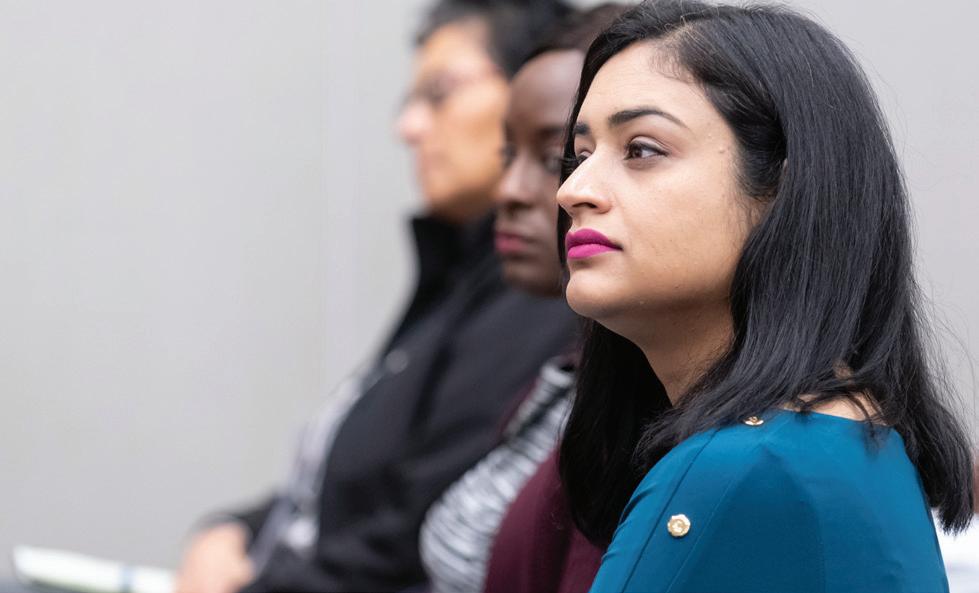



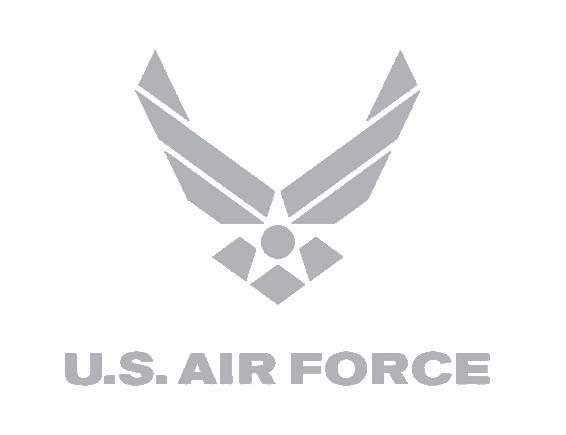

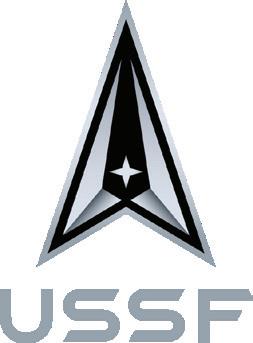



The future of warfare has changed dramatically. Battles are not only fought on the battlefield, but they are fought in Cyberspace and space as well. To stay ready the military needs to stay on top of the latest technological advances. To do that, they need top STEM professionals. This Career Outlook will look at these advancing technologies and tell you what fields are needed and how you can find a career in those areas.


IF YOU’RE PLANNING A CAREER, YOU MAY BE WONDERING WHAT SCIENCE, TECHNOLOGY, ENGINEERING, AND MATH (STEM) FIELDS WILL LOOK LIKE IN FIVE TO 10 YEARS. FIRST AND FOREMOST, THE FUTURE OF STEM CAREERS, INCLUDING THOSE IN THE MILITARY, IS PROMISING.
EXPANDED PROMINENCE, MORE SIGNIFICANT NEED, ENDLESS INNOVATION, AND RISING SALARIES MAKE ANY FUTUREFORWARD STEM CAREER PATH A GOOD BET FOR PROSPECTIVE STUDENTS, ENROLLEES, ACTIVE SERVICEMEMBERS, AND VETERANS.
STEM careers. A major path is through the U.S. Army Corps of Engineers (USACE), a wide network of both civilian engineers and soldiers who perform engineering work across the globe and in a wide variety of situations, which gives them an advantage in being future-forward. For example, engineers with USACE have worked to rebuild communities devastated by natural disasters, design and construct temporary or permanent infrastructure in war-torn areas, and design innovative solutions for every issue imaginable in combat zones. If you’re looking into any aspect of engineering, the USACE is a great choice to build versatile experience and remain at the forefront of innovative engineering practices.
The Navy lists high-priority roles that are in demand and command a higher enlistment bonus because they are critical
you’ll have the power of a nuclear reactor in your hands.”
The Air Force Research Laboratory offers servicemembers and civilians alike an opportunity to work in a well-funded, innovative work setting where they can apply expertise in chemistry, aerospace engineering, planning, leadership, research, and other core science domains. Those looking for enlistment in the Air Force will also find future-forward career paths, such as physicist, nuclear engineer, radar systems technician, aircraft armament systems roles, and perhaps the most future-forward role available— biomedical equipment. According to the Air Force, “From replacing parts and repairing components to inspecting equipment to ensure they fall within operating regulations, these professionals play a critical part in keeping our hospitals
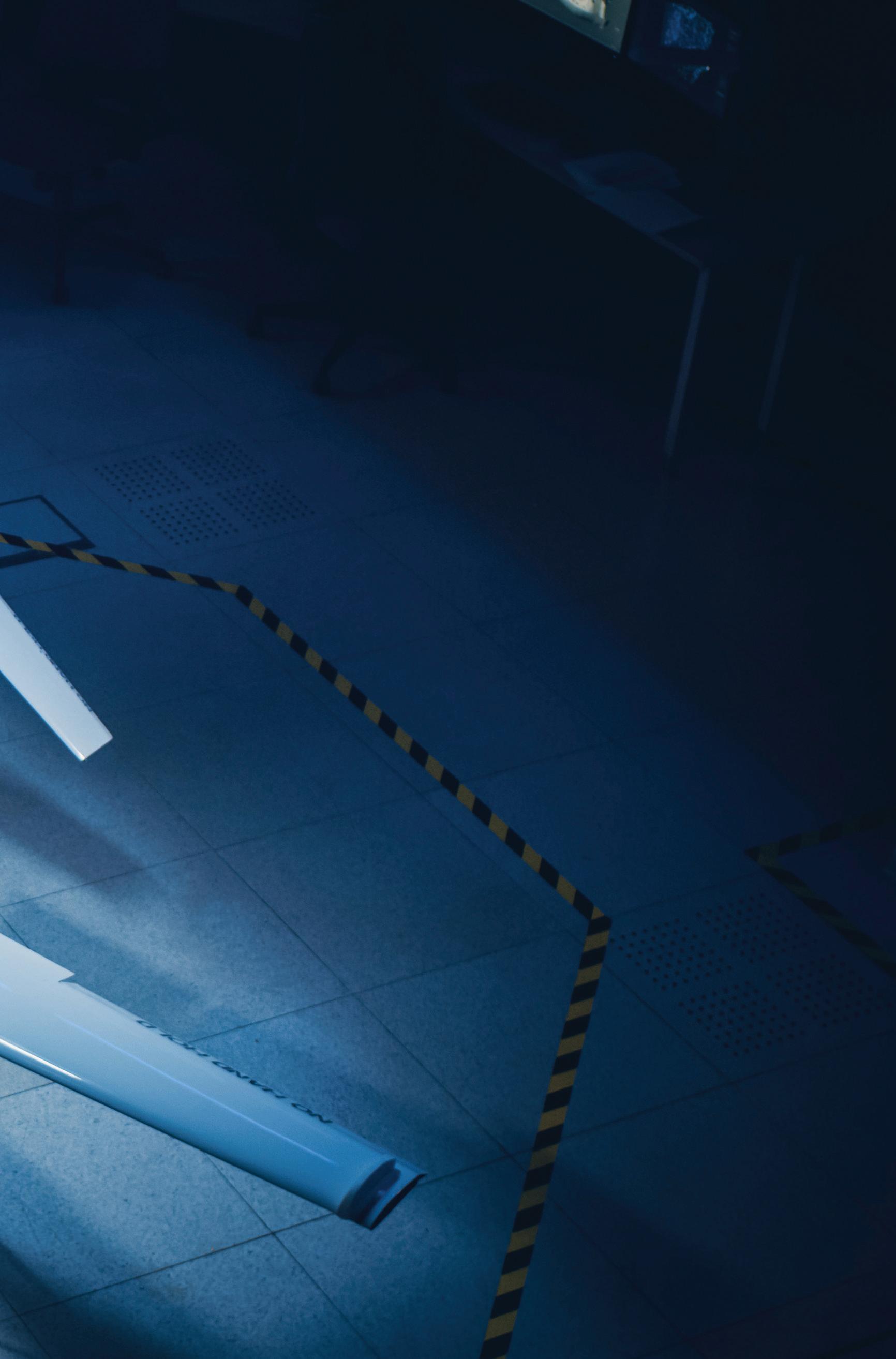
Many people think of engineers, chemists, and computer programmers when they think of STEM jobs. But there are countless career options that are part of the branches of the United States military. For example, many military branches employ engineers or specialist technicians. Servicemembers excel at medical skills, robotics, engineering, and problem-solving. In order to build and maintain a pipeline of successful, military-connected students who are prepared to enter the global STEM workforce, the Defense Department has maintained the Department of Defense Science, Mathematics, and Research for Transformation (SMART) Scholarship Program, part of the National Defense Education Program.
The U.S. Army is one of the largest employers of STEM professionals, and it has a three-pronged approach to preparing students and job seekers for
to our military’s success and readiness and involve specialized skills that will serve our country well, now and in the future. Perhaps the most future-forward role is the electronics technician nuclear (ETN) role, operating a submarine’s nuclear reactor.
According to the Navy’s website, “If math and science make your heart race, you might have the makings of an Electronics Technician Nuclear. As an ETN, you operate and perform maintenance on the electronic systems that make the reactor on Navy ships run. You must have a superior work ethic and an intense curiosity for all things in the world of physics. But out here, it pays to be smart. Not only will you get hands-on experience that nuclear techs in the civilian world can only dream about, but you’ll also be eligible to receive up to a $38,000 bonus for first-time enlistment. Re-enlistment bonuses are also available. As an ETN,
and field clinics fully operational.”
By some estimates, over 1.5 million retirements are expected from the United States armed forces. This shift will not only require the enrollment of new servicemembers but will also open up opportunities for current members of the armed forces to seek new specializations or roles. Another trend is an increased demand for STEM jobs, as more occupations and industries rely on scientific and technical skills, environmentally responsible products and energies, technology-laden products and processes, and the automation of many jobs. S

Ifyou’re a job seeker, college student, high school senior considering “what’s next,” or a high school graduate thinking of a career change, enlisting in one of the branches of the United States military offers exciting future-forward career paths. We have compiled the careers that are considered future-forward because they’re not only on the cutting edge of innovation, but they’ll most likely lead to future careers that don’t exist yet! A perfect example of this is the field of wearable medical devices and biomedical equipment. Biomedical professionals design, test, implement, repair, and maintain wearable medical devices such as prosthetics or advanced sensors embedded in a person’s body. Servicemembers who specialize in this area are on the cutting edge of medicine and treatments, and will be equipped for the futuristic wearables of tomorrow!
Future-forward STEM careers exist in all of the U.S. armed forces branches. Below are just a few examples for each branch:

ARMY: Biomedical equipment specialist, biochemist, environmental engineer, cryptologic cyberspace intelligence analyst
NAVY: Aerospace and operational physiologist, explosive ordnance disposal technician, Naval reactors engineer
AIR FORCE: Nuclear engineer, aircraft armament systems engineer, missile and space systems electronic maintenance, developmental engineer
MARINE CORPS: Military occupational specialties include; intelligence, utilities, engineering, construction, facilities, signals intelligence, chemical, biological, radiological, and nuclear defense
SPACE FORCE: Aerospace engineer, computer scientist, information technology specialist, fusion analyst, space systems operator
In general, the Air Force and Navy tend to employ a wider variety of futureforward roles, given the futuristic equipment and infrastructure they utilize. The Marine Corps offers a rigorous, specialized set of career paths that may engage some recruits. The Army offers a great set of specialized careers, as well.

In the end, your desired branch has, at a minimum, several options for you to consider. Want to be an engineer? Each branch has some level of engineering for you. Want to be a scientist? Each branch offers specialized scientific roles. Not ready to decide? Enlist and learn what suits you best!
Looking to experience another part of the United States or even another country? Then consider picking a future-forward career such as nuclear engineering. All of our armed forces utilize nuclear technology, lasers, and semiconductors in order to achieve and maintain their objectives around the world. Where are these jobs typically available? In general, these careers are available globally, as our armed forces deploy specialists all over the world both in and out of combat zones. To some degree, more opportunities exist around military bases and centers. So, consider researching which military bases and complexes are closest to your current or desired location. For example, Annapolis, MD, is home to a major Naval base, so many jobs are located there.
The best way to prepare for these careers, depending on your desired branch of service, is to speak with a recruiter or advisor prior to enlisting. There are many educational programs geared toward potential recruits seeking to prepare themselves for a futureforward STEM role in the military. The Department of Defense Education Activity (DODEA) is responsible for managing the pre-kindergarten through 12th-grade educational programs on behalf of the Department of Defense. DODEA is globally implemented, operating 160 accredited schools in eight districts located in 11 foreign countries, seven states, Guam, and Puerto Rico. Current high school students should consider several military-backed programs aimed at opening access to STEM careers, such as the SMART Scholarship program. This program offers full tuition to students pursuing STEM degrees, annual stipends, internships, and guaranteed employment with the Department of Defense upon degree completion.
Likewise, the Office of Naval Research in partnership with the Marine Corps
manages the Naval Science Awards Program. High school students are eligible for certificates and awards won through regional and state science fairs. The Office of Naval Research also offers a Science and Engineering Apprentice Program that can help academically talented high school students apprentice in Department of Defense laboratories. These programs allow students with an aptitude and interest in STEM to gain valuable experience, networking, and insights into the roles and responsibilities that await them in a STEM military career.
By connecting with the military branches’ many outreach initiatives and financial support programs, high school students and potential recruits can build their skills, connect with advisors, engage in internships, and serve the United States in a future-forward career. S

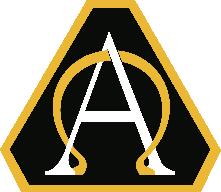


Bring your valuable experience, skills, determination and discipline to SAIC. Ranked on the 2022 Forbes Best Employers for Veterans List, we welcome you to join us. saic.com





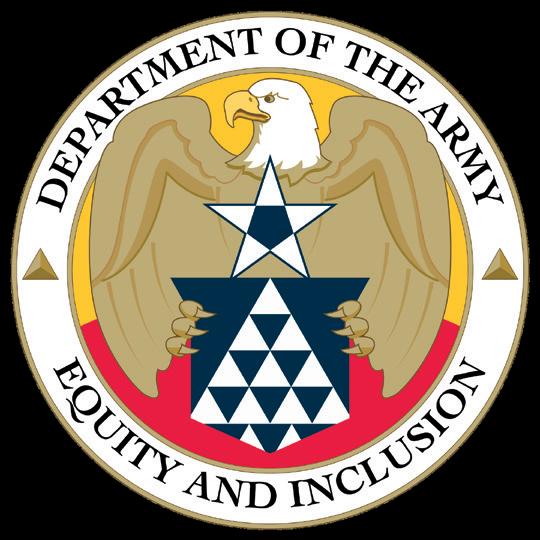
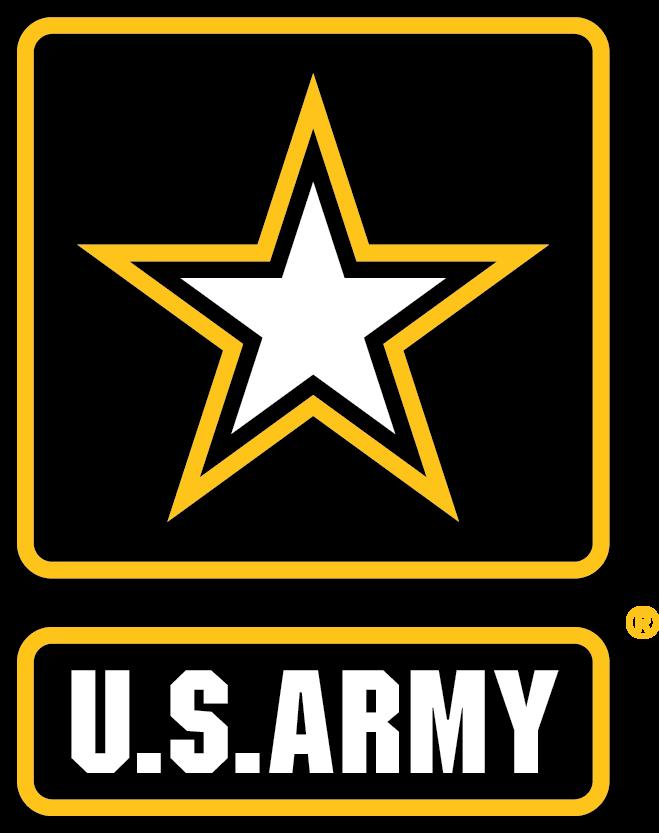
T h e U . S . A r m y f o s t e r s a c u l t u r e b u i l t o n t r u s t a n d a c c e p t s v a l u e s a n d v i e w s a s s t r e n g t h s : t h e a t t r i b u t e s , e x p e r i e n c e s , c u l t u r e s , c h a r a c t e r i s t i c s , a n d b a c k g r o u n d s e a c h S o l d i e r a n d C i v i l i a n b r i n g s t o t h e i n s t i t u t i o n .
